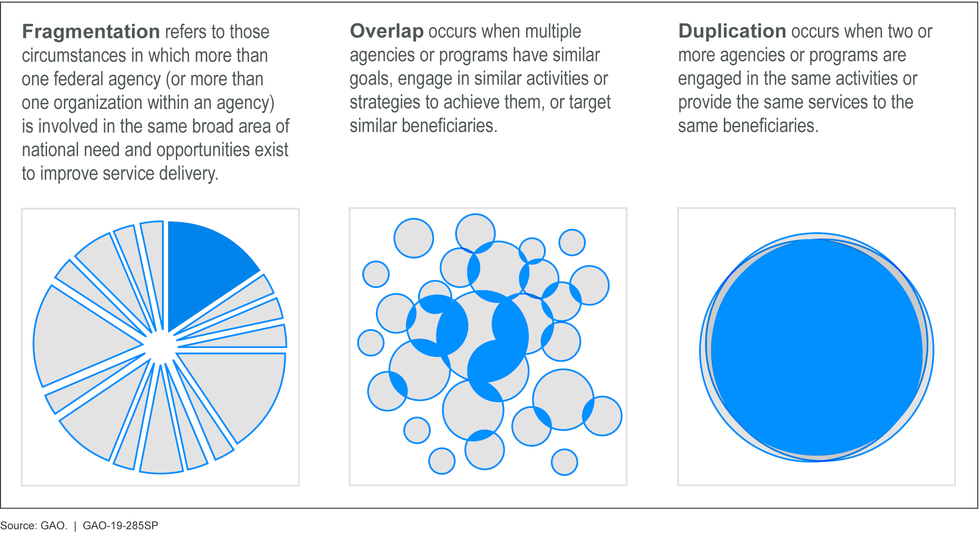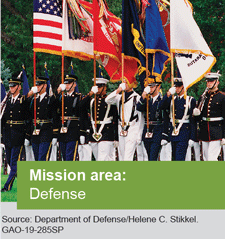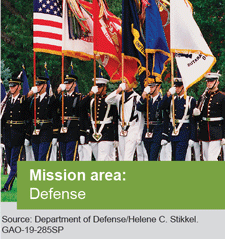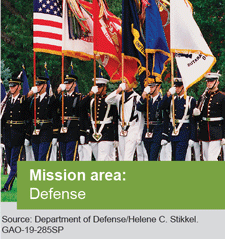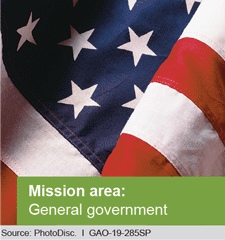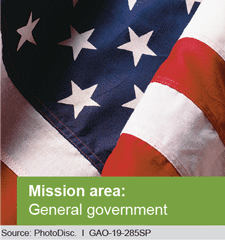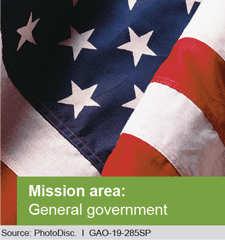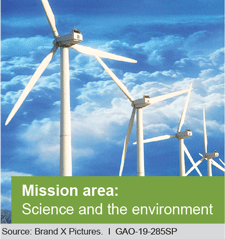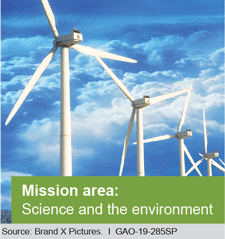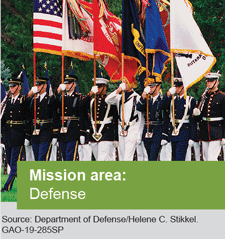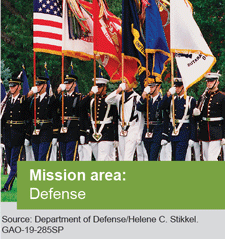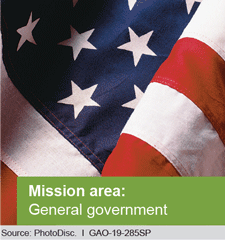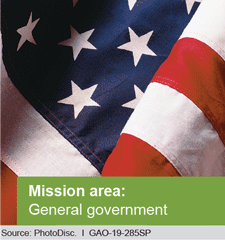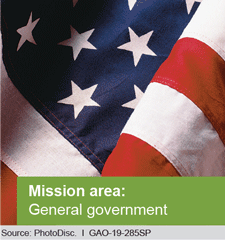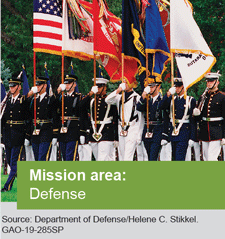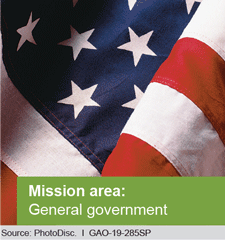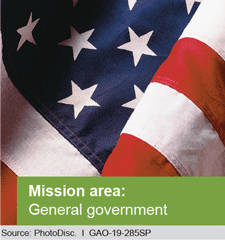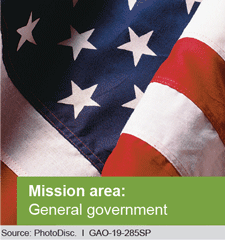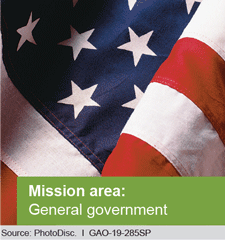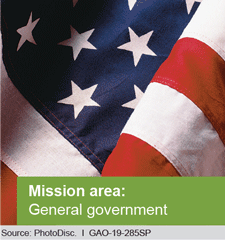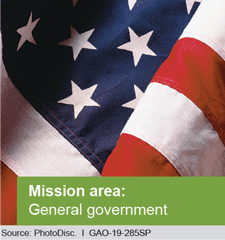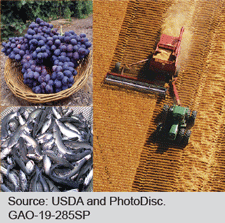Highlights
What GAO Found
GAO’s 2019 annual report identifies 98 new actions that Congress or executive branch agencies can take to improve the efficiency and effectiveness of government in 28 new areas and 11 existing areas. For example:
- The Department of Energy could potentially avoid spending billions of dollars by developing a program-wide strategy to improve decision-making on cleaning up radioactive and hazardous waste to address the greatest human health and environmental risks.
- The Centers for Medicare & Medicaid Services could also potentially save hundreds of millions of dollars by improving how it identifies and targets risk in overseeing Medicaid expenditures to identify and resolve errors.
- Congress could enhance federal revenue by at least tens of millions of dollars annually through expanding the definition of allowable expenses authorized to be covered by the Foreign Military Sales administrative account, thereby likely reducing the need to cover these expenses with other appropriated funds.
- The Department of Defense could expand its use of intergovernmental agreements to obtain military installation support services—such as waste management and snow removal—and potentially save millions of dollars annually.
- The Department of Defense could also potentially save millions of dollars in its administration of military treatment facilities—such as hospitals and dental clinics—by analyzing medical functions for duplication, validating headquarters-level personnel requirements, and identifying the least costly mix of personnel.
- The Department of Homeland Security should develop a strategy and implementation plan to help guide, support, integrate, and coordinate its multiple chemical defense programs and activities to better manage these fragmented efforts.
- The federal agencies that coordinate research on quantum computing and synthetic biology could better manage fragmentation by agreeing on roles and responsibilities and identifying outcomes to help agencies improve their research efforts to maintain U.S. competitiveness in these areas.
GAO identified 33 new actions related to 11 existing areas presented in its 2011 to 2018 annual reports. For example:
- Congress could provide the Internal Revenue Service the authority to require scannable codes on tax returns prepared electronically, but filed on paper, to improve its ability to combat tax fraud and noncompliance and save tens of millions of dollars annually.
- The U.S. Mint could potentially reduce the cost of coin production by millions of dollars annually by changing the metal content of currency.
- The Department of Defense could collect cost and technical data and lessons learned to make more informed decisions on using commercial spacecraft to host government sensors and communications packages, which could lead to considerable cost savings.
Significant progress has been made in addressing many of the 805 actions that GAO identified from 2011 to 2018 to reduce costs, increase revenues, and improve agencies’ operating effectiveness. As of March 2019, Congress and executive branch agencies have fully addressed 436 actions (54 percent) and partially addressed 185 actions (23 percent). This has resulted in approximately $262 billion in financial benefits. About $216 billion of these benefits accrued between 2010 and 2018 and $46 billion are projected to accrue in future years. These are rough estimates based on a variety of sources that considered different time periods and utilized different data sources, assumptions, and methodologies.
While Congress and executive branch agencies have made progress toward addressing actions that GAO has identified since 2011, further steps are needed. GAO estimates that tens of billions of additional dollars could be saved should Congress and executive branch agencies fully address the remaining 396 open actions, including the new ones identified in 2019. Addressing the remaining actions could lead to other benefits as well, such as increased public safety, better homeland and national security, and more effective delivery of services. For example:
| Area name and description (year-number links to Action Tracker) | Mission | Potential benefits (source when financial) |
| DOE’s Treatment of Hanford’s Low Activity Waste (2018-17): The Department of Energy may be able to reduce certain risks by adopting alternative approaches to treating a portion of its low-activity radioactive waste. | Energy | Tens of billions (GAO) |
| Defense Headquarters (2012-34): The Department of Defense could review and identify further opportunities for consolidating or reducing the size of headquarters organizations. | Defense | $9.4 billion (National Defense Authorization Act) |
| Disability and Unemployment Benefits (2014-08): Congress should consider passing legislation to prevent individuals from collecting both full Disability Insurance benefits and Unemployment Insurance benefits that cover the same period. | Income security | $2.5 billion over 10 years (Office of Management and Budget) |
| Medicare Payments by Place of Service (2016-30): Medicare could have cost savings if Congress were to equalize the rates Medicare pays for certain health care services, which often vary depending on where the service is performed. | Health | Billions annually (GAO) |
| IRS Strategic Workforce Planning (2019-07): The Internal Revenue Service should address its fragmented human capital activities to improve its strategic workforce planning so it can better meet challenges to achieving its mission. | General government | Identify and address skills gaps in mission critical occupations |
| Military and Veterans Health Care (2012-15): The Departments of Defense (DOD) and Veterans Affairs (VA) need to improve integration across care coordination and case management programs to reduce duplication and better assist servicemembers, veterans, and their families. | Health | Better care from and management of DOD and VA Healthcare programs |
Note: All estimates of potential savings are dependent on various factors, such as whether action is taken and how it is taken. Actual savings may be less, depending on costs associated with implementing the action, unintended consequences, and the impact of other factors that could/should be controlled for. For estimates of potential financial benefits, GAO developed the notional estimates, which are intended to provide a sense of potential magnitude of savings. Notional estimates have been developed using broad assumptions about potential savings which are rooted in previously identified losses, the overall size of the program, previous experience with similar reforms, and similar rough indicators of potential savings.
Why GAO Did This Study?
The federal government continues to face an unsustainable long-term fiscal path caused by an imbalance between federal revenue and spending. While addressing this imbalance will require difficult policy decisions, opportunities exist in a number of areas to improve this situation, including where federal programs or activities are fragmented, overlapping, or duplicative.
To call attention to these opportunities, Congress included a provision in statute for GAO to identify and report on federal programs, agencies, offices, and initiatives—either within departments or government-wide—that have duplicative goals or activities. GAO also identifies areas that are fragmented or overlapping and additional opportunities to achieve cost savings or enhance revenue collection.
This report discusses the new areas identified in GAO’s 2019 annual report; the progress made in addressing actions GAO identified in its 2011 to 2018 reports; and examples of open actions directed to Congress or executive branch agencies.
To identify what actions exist to address these issues, GAO reviewed and updated prior work, including recommendations for executive action and matters for congressional consideration.
Introduction
May 21, 2019
Congressional Addressees
The federal government continues to face an unsustainable long-term fiscal path caused by an imbalance between federal revenue and spending, primarily driven by health care spending and interest on debt held by the public (net interest).[1] Addressing this imbalance will require difficult policy decisions about long-term changes to both spending and revenue. Acting soon to mitigate this imbalance would help to minimize the disruption to individuals and the economy.
Meanwhile, Congress and executive branch agencies have opportunities to contribute toward fiscal sustainability and act as stewards of federal resources. One way is to take action to reduce, eliminate, or better manage fragmentation, overlap, or duplication; achieve cost savings; or enhance revenues. To call attention to these opportunities, Congress included a provision in statute for us to identify and report to Congress on federal programs, agencies, offices, and initiatives—either within departments or government-wide—that have duplicative goals or activities.[2] As part of this work, we also identify additional opportunities to achieve greater efficiency and effectiveness that result in cost savings or enhanced revenue collection.
In eight annual reports issued from 2011 to 2018, we presented more than 300 areas and more than 800 actions for Congress or executive branch agencies to reduce, eliminate, or better manage fragmentation, overlap, or duplication; achieve cost savings; or enhance revenues.[3] Congress and executive branch agencies have partially or fully addressed 621 (77 percent) of the actions we identified from 2011 to 2018, resulting in about $262 billion in financial benefits. We estimate tens of billions more dollars could be saved by fully implementing our open actions.[4]
Figure 1 defines the terms we use in this work.
This report is our ninth in the series, and it identifies 28 new areas where a broad range of federal agencies may be able to achieve greater efficiency or effectiveness.
For each area, we suggest actions that Congress or executive branch agencies could take to reduce, eliminate, or better manage fragmentation, overlap, or duplication, or achieve other financial benefits. In addition to identifying new areas and actions, we continue to monitor the progress Congress and executive branch agencies have made in addressing actions we previously identified (see text box).
This report is based upon work we previously conducted in accordance with generally accepted government auditing standards or our quality assurance framework. See appendix I for more information on our scope and methodology.
| GAO's online Action Tracker GAO's Action Tracker, a publicly accessible website, allows Congress, executive branch agencies, and the public to track the government's progress in addressing the issues we have identified. GAO's Action Tracker includes a downloadable spreadsheet containing all actions. Areas and actions in the spreadsheet can be sorted and filtered by the year identified, mission, area name, implementation status, and implementing entities (Congress or executive branch agencies). The spreadsheet additionally notes which actions are also GAO priority recommendations--those recommendations GAO believes warrant priority attention from the heads of departments or agencies. With the release of this report, GAO is concurrently releasing the latest updates to these resources. |
Major Findings
IN THIS SECTION
New Opportunities Exist to Improve Efficiency and Effectiveness across the Federal Government
This report presents 98 new actions that Congress or executive branch agencies could take across 28 new areas.[5] Of these 28 new areas, 17 concern fragmentation, overlap, or duplication in government missions and functions (see table 1). Appendix II provides more detailed information about the 17 new areas.
We also present 11 areas where Congress or executive branch agencies could take action to reduce the cost of government operations or enhance revenue collections for the U.S. Treasury (see table 2). Appendix III provides more detailed information about these new areas.
In addition to these 28 new areas, we identified 33 new actions related to 11 existing areas presented in our 2011 to 2018 annual reports (see table 3).[6] Appendix IV provides more detailed information about these new actions.
| Mission | New action (area name links to Action Tracker) | Year introduced (year links to report) |
| Defense | 1. Prepositioning Programs: In January 2019, GAO identified two new actions to help fully implement joint oversight of the Department of Defense’s prepositioned stocks programs and to reduce fragmentation. | |
| Energy | 2. Strategic Petroleum Reserve: In May 2018, GAO identified two new actions to help the federal government potentially realize savings by examining the optimal size of the Strategic Petroleum Reserve. | |
| General government | 3. Department of Veterans Affairs Medical Facility Construction: In July 2018, GAO identified three new actions to improve the accuracy of project budgets and better manage project delays and cost increases. | |
| 4. Financial Regulatory Structure: In March 2018, GAO identified five new actions to help reduce fragmentation and improve collaboration among federal financial regulators. | ||
| 5. Identity Theft Refund Fraud: In June 2018, GAO identified four new actions to help the Internal Revenue Service (IRS) prevent refund fraud associated with identity theft. | ||
| 6. Government-wide Improper Payments: In May 2018, GAO identified two new actions to help the federal government address the long-standing problem of improper payments. | ||
| 7. Government Satellite Program Costs: In July 2018, GAO identified a new action to help the Department of Defense make more informed decisions on using commercial spacecraft to host government sensors and communications packages, which could lead to considerable cost savings. | ||
| 8. U.S. Currency: In March 2019, GAO identified a new action to potentially reduce the cost of coin production by millions of dollars annually. | ||
| 9. Tax Fraud and Noncompliance: In July 2018, GAO identified six new actions to help IRS combat tax fraud and noncompliance and save tens of millions of dollars annually. | ||
| Training, employment, and education | 10. Employment and Training Programs: In March 2019, GAO identified a new action to help the Department of Labor evaluate whether actions to manage fragmentation and overlap among employment and training programs are working. | |
| 11. Higher Education Assistance: In November 2016, GAO identified six new actions to help the Department of Education improve its income-driven repayment plan budget estimates. |
Congress and Executive Branch Agencies Continue to Address Actions across the Federal Government
Congress and executive branch agencies have made consistent progress in addressing many of the actions we have identified since 2011, as shown in table 4. As of March 2019, they had fully addressed 436 (54 percent) of the actions we identified from 2011 to 2018. See GAO’s online Action Tracker for the status of all actions.
aIn assessing actions suggested for Congress, GAO applied the following criteria: “addressed” means relevant legislation has been enacted and addresses all aspects of the action needed; “partially addressed” means a relevant bill has passed a committee, the House of Representatives, or the Senate during the current congressional session, or relevant legislation has been enacted but only addressed part of the action needed; and “not addressed” means a bill may have been introduced but did not pass out of a committee, or no relevant legislation has been introduced. Actions suggested for Congress may also move to “addressed” or “partially addressed,” with or without relevant legislation, if an executive branch agency takes steps that address all or part of the action needed. At the beginning of a new congressional session, GAO reapplies the criteria. As a result, the status of an action may move from partially addressed to not addressed if relevant legislation is not reintroduced from the prior congressional session.
bIn assessing actions suggested for the executive branch, GAO applied the following criteria: “addressed” means implementation of the action needed has been completed; “partially addressed” means the action needed is in development or started but not yet completed; and “not addressed” means the administration, the agencies, or both have made minimal or no progress toward implementing the action needed.
cOf the 69 “other” actions, GAO categorized 42 as “consolidated or other” and 27 as “closed-not addressed.” GAO no longer assesses actions categorized as “consolidated or other” and “closed-not addressed.” In most cases, “consolidated or other” actions were replaced or subsumed by new actions based on additional audit work or other relevant information. GAO generally categorizes actions as “closed-not addressed” when the action is no longer relevant due to changing circumstances.
As we have reported, it frequently takes multiple years for actions to be fully addressed, in part because many of the actions involve significant issues that require action from multiple agencies. Thus, more recommendations are implemented over time. For example, as of March 2019 executive branch agencies had addressed 88 percent of the actions introduced in the 2013 report, compared to 20 percent of the actions introduced in the 2018 report.[7]
Actions Taken by Congress and Executive Branch Agencies Led to Billions in Financial Benefits
As a result of steps Congress and executive branch agencies have taken to address our open actions, we have identified approximately $262 billion in total financial benefits, including $83 billion identified since our last report. About $216 billion of the total benefits accrued between 2010 and 2018, while approximately $46 billion are projected to accrue in 2019 or later, as shown in figure 2.[8]
Figure 2: Total Reported Financial Benefits of $262 Billion, as of March 2019

Table 5 highlights examples of these results.
| Area name (year-number links to Action Tracker) | Actions taken | Financial benefit |
| Congress passed the Agricultural Act of 2014, which eliminated direct payments to farmers.a | Savings of approximately $44.5 billion from fiscal year 2015 through fiscal year 2023, of which $19.8 billion has accrued and $24.7 billion is expected to accrue in fiscal year 2019 or later, according to the Congressional Budget Office (CBO). | |
| Congress passed the Weapon Systems Acquisition Reform Act of 2009, which implemented a number of GAO’s recommendations for how the Department of Defense (DOD) develops and acquires weapon systems. GAO highlighted the need for additional action in this area in its 2011 report. Since then, DOD has followed more best practices for these acquisitions.b | Savings of approximately $43.8 billion from 2011 through 2017, according to GAO analysis. | |
| The Department of Health and Human Services (HHS) changed processes to curtail some problematic methods used to determine spending limits for Medicaid Demonstrations, restricted the amount of unspent funds states can accrue and carry forward to expand demonstrations, and could further reduce federal spending by addressing other problematic methods. | Savings of approximately $36.8 billion in 2016 and 2017, and tens of billions of additional savings could potentially accrue in the future according to agency estimates. | |
| Congress allowed the Volumetric Ethanol Excise Tax Credit to expire at the end of 2011, which eliminated duplicative federal efforts directed at increasing domestic ethanol production.c | Reduced revenue losses by $29 billion from fiscal year 2012 to fiscal year 2016, according to GAO analysis. | |
| The Department of Education changed its estimation approach for calculating the cost of Income-Driven Repayment (IDR) plans, allowing the agency to transfer unused funds to the Treasury. | Financial benefits of approximately $24.2 billion during fiscal year 2018, according to agency estimates. | |
| Congress passed the Bipartisan Budget Act of 2013, which modified the passenger security fee from its current per enplanement structure ($2.50 per enplanement with a maximum one-way-trip fee of $5.00) to a structure that increases the passenger security fee to a flat $5.60 per one-way-trip.d | Increased revenue of about $12.9 billion in fee collections over a 10-year period beginning in fiscal year 2014 and continuing through fiscal year 2023, according to CBO and other estimates. | |
| The Department of Veterans Affairs evaluated strategic sourcing opportunities, set goals, tracked metrics, and ultimately procured a larger share of goods and services–including information technology (IT)–using contracts aligned with strategic sourcing principles. | Cost avoidance of about $10.6 billion from fiscal years 2013 through 2017, according to GAO estimates. | |
| Congress amended the audit procedures applicable to certain large partnerships to require that they pay audit adjustments at the partnership level.e | Increased revenue of $9.3 billion from fiscal years 2019 to 2025, according to the Joint Committee on Taxation. | |
| The Department of the Treasury (Treasury) updated its analysis of estimated future expenditures for the Making Home Affordable program, reducing the estimated lifetime cost of the program. | Savings of $6 billion as a result of deobligating funds in December 2016, according to agency estimates. | |
| The Department of Housing and Urban Development made improvements to increase the recoveries from disposing of properties it receives when loans default, such as by selling these loans and increasing property inspections and oversight of contractors disposing of these properties. | Savings of as much as $5.4 billion from July 2013 through June 2018, according to GAO estimates. | |
| The 24 federal agencies participating in the Office of Management and Budget’s (OMB) data center consolidation and optimization efforts have taken steps to consolidate over 6,200 data centers as of August 2018. | Cost savings and avoidances of $4.2 billion from fiscal years 2011 through 2019, based on GAO analysis of agency reported data. This includes about $468 million expected to accrue in fiscal year 2019, according to agency plans. | |
| United States Forces Korea conducted a series of consultations with the military services to evaluate the costs and benefits associated with tour normalization, and DOD decided not to move forward with the full tour normalization initiative because it was not affordable. | Savings of an estimated $3.1 billion from fiscal years 2012 through 2016, according to agency estimates. | |
| Congress limited preparedness grant funding until the Federal Emergency Management Agency completes a national preparedness assessment of capability gaps.f | Savings of $2.6 billion from fiscal years 2011 through 2013, according to GAO estimates. | |
| Congress has taken steps to increase the minimum adjustment made for differences in diagnostic coding patterns between Medicare Advantage plans and traditional Medicare providers. | Savings of approximately $2.5 billion from fiscal years 2013 through 2022, of which $1.5 billion has accrued and $1 billion is expected to accrue in fiscal year 2019 or later according to CBO. | |
| Information Technology Investment Portfolio Management (2014‑24) | Nine agencies migrated commodity IT areas to shared services in response to OMB’s 2012 guidance to review their portfolios and identify duplicative, low-value, and wasteful investments, contributing to savings. | Savings of an estimated $2.5 billion from fiscal years 2012 through 2017, and billions in additional savings could potentially accrue in the future according to agency estimates. |
| DOD canceled the Air Force’s Expeditionary Combat Support System because of significant cost and schedule overages. | Savings of about $1.6 billion from fiscal years 2013 through 2025, according to GAO analysis of agency estimates. This includes about $862 million expected to accrue in fiscal year 2019 or later. | |
| The Department of Energy (DOE) completed a long-term strategic review of the Strategic Petroleum Reserve in August 2016, as Congress required in 2015. | DOE reported savings of $1.2 billion from selling crude oil from the reserve in fiscal years 2017 and 2018, with potential for over $8.4 billion in total sales through 2025 according to CBO. |
Note: The estimates in this report are from a range of sources, including GAO, executive branch agencies, CBO, and the Joint Committee on Taxation. Some estimates have been updated since GAO’s 2018 report to reflect more recent analysis.
aPub. L. No. 113-79, § 1101, 128 Stat. 649, 658 (2014).
bPub. L. No. 111-23, 123 Stat. 1704 (2009).
c26 U.S.C. § 6426(b)(6).
dPub. L. No. 113-67, § 601(b), 127 Stat. 1165, 1187 (2013).
eBipartisan Budget Act of 2015, Pub. L. No. 114-74, § 1101, 129 Stat. 584, 625–638 (2015).
fPub. L. No. 112-10, § 1632, 125 Stat. 38, 143 (2011); Pub. L. No. 112-74, 125 Stat. 786, 960–962 (2011); Pub. L. No. 113-6, 127 Stat. 198, 358–360 (2013); Pub. L. No. 113-76, 118 Stat. 5, 261–262 (2014).
Other Benefits Resulting from Actions Taken by Congress and Executive Branch Agencies
Our suggested actions, when implemented, often result in benefits—for instance, more effective and equitable government; improvements in major government programs or agencies; and increased assurance that programs comply with laws and that funds are legally spent. The following examples illustrate these types of benefits.
- Defense Weather Satellites (2017-04): DOD’s weather satellites have provided data to support both military and civilian operations for more than 50 years. As these weather satellites aged, DOD faced potential gaps in its ability to monitor the weather. In 2016, we found that DOD had not effectively collaborated with the National Oceanic and Atmospheric Administration (NOAA) to assess the availability of data for some of its highest priorities.
- We recommended that DOD establish formal mechanisms to work with NOAA. DOD agreed, and in late 2017, NOAA signed a memorandum of agreement with the Air Force and the Navy regarding exchanging information, collaboration, and interagency acquisitions. These actions will help NOAA and DOD update weather satellite capabilities. Because of this progress and other actions, in 2019 we removed the Mitigating Gaps in Weather Satellite Data area from our High-Risk List.[9]
- Medicare Postpayment Claims Review (2015-07): Several types of Medicare contractors conduct postpayment claims reviews to help reduce improper payments. In 2014, we found that the Centers for Medicare & Medicaid Services (CMS) did not have reliable data and did not provide sufficient oversight and guidance to measure and fully prevent duplicative claims reviews among Medicare contractors.
- We recommended that CMS monitor the Recovery Audit Data Warehouse to ensure that all postpayment review contractors are submitting required data and that the data the database contains are accurate and complete. CMS took several steps between 2015 and 2017, including developing complete guidance to define contractors’ responsibilities regarding duplicative claims reviews, implementing a new process to monitor the data that contractors enter into the Recovery Audit Data Warehouse, and periodically verifying that contractors submit all required data to the Warehouse. As a result, CMS has helped ensure that Medicare contractors conduct efficient postpayment claims reviews and avoid inappropriate duplication.
- Use of the Do Not Pay Working System (2017-11): The Office of Management and Budget (OMB), in coordination with the Department of the Treasury (Treasury), developed the Do Not Pay working system as a data matching service for agencies to use in preventing improper payments. In 2016, we reported that the 10 agencies we reviewed used the working system in limited ways, in part because of a lack of clear OMB strategy and guidance.
- We recommended that the Director of OMB develop a strategy and clarifying guidance for how agencies should use the Do Not Pay working system to complement and streamline existing data matching processes. In June 2018, OMB issued a revised Circular A-123 Appendix C that discusses in detail how agencies should effectively use the working system and clarifies requirements about use of the working system’s payment integration functionality and how to obtain a waiver. It includes a section on streamlining existing data-matching processes, screening payees before a payment is made, assessing data quality, tailoring the results of matching to program requirements, and using analytics services to develop solutions for program-specific improper payment challenges. As a result of these actions, OMB’s revised appendix should help ensure that agencies use the Do Not Pay working system effectively, which could contribute to reductions in improper payments.
Action on Remaining and New Areas Could Yield Significant Additional Benefits
Congress and executive branch agencies have made progress toward addressing the 903 total actions we have identified since 2011. However, further steps are needed to fully address the 396 actions that are partially addressed, not addressed, or new.[10] We estimate that tens of billions of dollars in additional financial benefits could be realized should Congress and executive branch agencies fully address open actions, and other improvements can be achieved as well.[11]
Open Areas Directed to Congress and Executive Branch Agencies with Potential Financial Benefits
Congress has used our work to identify legislative solutions to achieve cost savings, address emerging problems, and find efficiencies in federal agencies and programs. Our work has contributed to a number of key authorizations and appropriations. In addition, congressional oversight of agencies’ efforts has been critical in realizing the full benefits of our suggested actions addressed to the executive branch, and it will continue to be critical.
In our 2011 to 2019 annual reports, we directed 106 actions to Congress, including the six new congressional actions we identified in 2019. Of the 106 actions, 59 (56 percent) remained open as of March 2019. Appendix V has a full list of all open congressional actions.
We also directed 797 actions to executive branch agencies, including 92 new actions identified in 2019. As shown in figure 3, these actions span the government and are directed to dozens of federal agencies. Five of these agencies, DOD, HHS, IRS, OMB, and DHS, have at least 25 open actions. Of the 797 actions, 337 (42 percent) remained open as of March 2019.
Figure 3: Number of Partially Addressed and Not Addressed Actions since 2011, by Agency
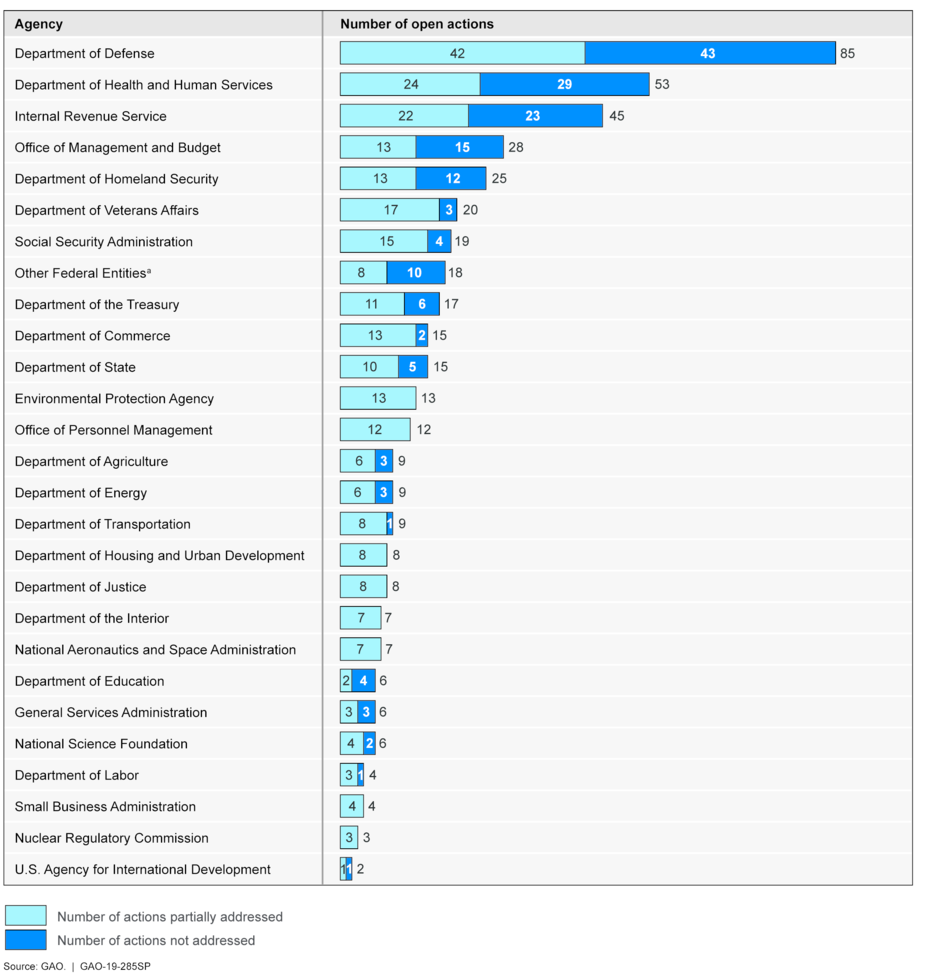
A significant number of open actions are directed to 10 agencies that made up about 95 percent of federal outlays in fiscal year 2018. Figure 4 highlights agencies with open actions as well as their fiscal year 2018 share of federal outlays.
Figure 4: Fiscal Year 2018 Outlays and Number of Open Actions since 2011, by Agency
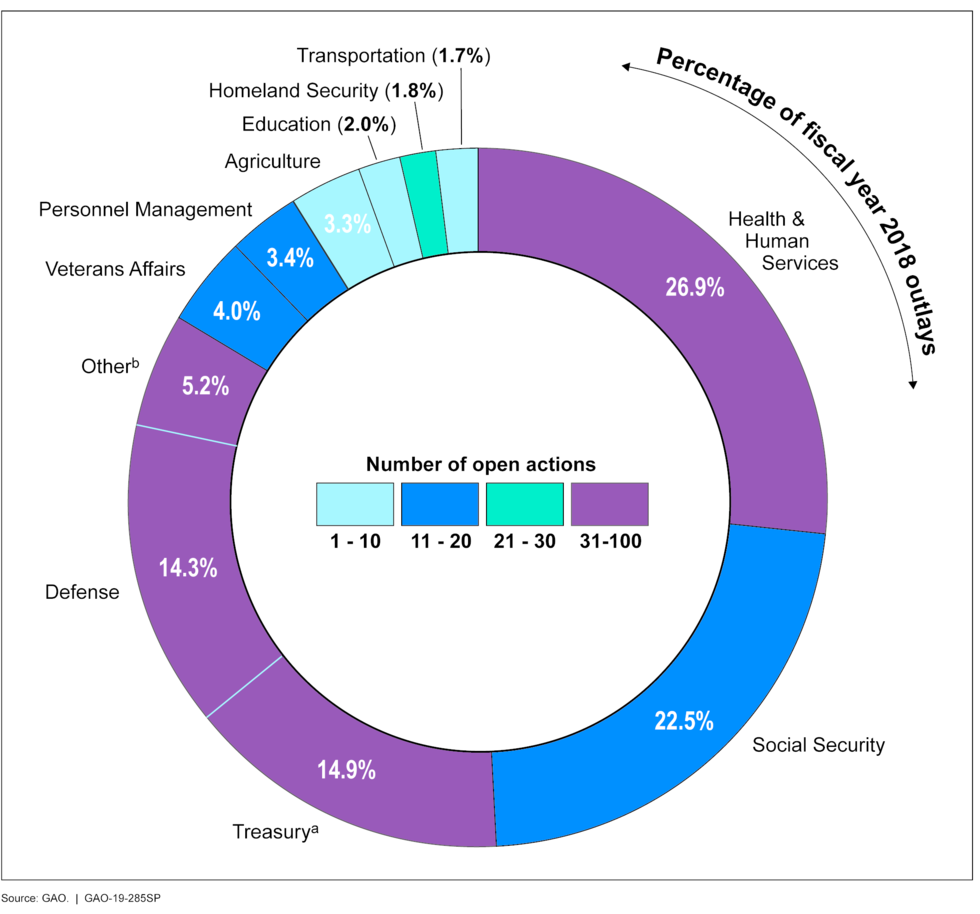
We identified potential financial benefits associated with many open areas with actions directed to Congress and the executive branch. These benefits range from millions of dollars to tens of billions of dollars. For example, DOD could help achieve its initial cost savings target of $2 billion by managing its commissaries better, potentially saving millions of dollars. In another example, IRS could collect over a million dollars annually in additional tax revenues by clarifying whether transfers of unclaimed savings from employer-based plans to states are distributions and should be subject to tax withholding. Table 6 highlights examples of areas where additional action could potentially result in financial benefits of $1 billion or more.
| Area name and description (year-number links to Action Tracker) | Mission | Potential financial benefitsa (source) |
| *DOE’s Treatment of Hanford’s Low-Activity Waste (2018‑17): The Department of Energy (DOE) may be able to reduce certain risks by adopting alternative approaches to treating a portion of its low-activity radioactive waste. (GAO-17-306) | Energy | Tens of billions (GAO) |
| Defense Headquarters (2012‑34): The Department of Defense could review and identify further opportunities for consolidating or reducing the size of headquarters organizations. (GAO-12-345, GAO-13-293, GAO-14-439, GAO-15-10) | Defense | $9.4 billion (National Defense Authorization Act) |
| *Advanced Technology Vehicles Manufacturing Loan Program (2014‑13): Unless the Department of Energy can demonstrate demand for new Advanced Technology Vehicles Manufacturing loans and viable applications, Congress may wish to consider rescinding all or part of the remaining credit subsidy appropriations. (GAO-14-343SP) | Energy | Up to $4.3 billion (DOE) |
| *Disability and Unemployment Benefits (2014‑08): Congress should consider passing legislation to prevent individuals from collecting both full Disability Insurance benefits and Unemployment Insurance benefits that cover the same period. (GAO-12-764) | Income security | $2.5 billion over 10 years (Office of Management and Budget) |
| *Social Security Offsets (2011‑80): The Social Security Administration (SSA) needs data on pensions from noncovered earnings to better enforce offsets and ensure benefit fairness, which could result in cost savings if enforced both retrospectively and prospectively, according to the Congressional Budget Office (CBO) and SSA. Congress could consider giving the Internal Revenue Service the authority to collect the necessary information. Estimated savings would be less if SSA only enforced the offsets prospectively as it would not reduce benefits already received. (GAO-05-786T) | Income security | $2.4 to $7.9 billion over 10 years (CBO and SSA) |
| *Crop Insurance (2013‑19): Congress could consider limiting the subsidy for premiums that an individual farmer can receive each year from the Federal Crop Insurance program, reducing the subsidy, or some combination of limiting and reducing these subsidies and making changes to the program to reduce its delivery costs. (GAO-17-501, GAO-12-256) | Agriculture | Up to $1.4 billion annually (GAO) |
| Medicare Clinical Laboratory Payments (2019‑25): The Centers for Medicare & Medicaid Services should take steps to avoid paying more than necessary for clinical laboratory tests. (GAO-19-67) | Health | Over $1 billion, or billions (GAO) |
| *Medicare Payments by Place of Service (2016‑30): Medicare could have cost savings if Congress were to equalize the rates Medicare pays for certain health care services, which often vary depending on where the service is performed. (GAO-16-189) | Health | Billions annually (GAO) |
| Department of Energy Environmental Liability (2019‑20): DOE could develop a program-wide strategy to improve decision-making on cleaning up radioactive and hazardous waste. (GAO-19-28) | Energy | Billions (GAO) |
| *Identity Theft Refund Fraud (2016‑22): The Internal Revenue Service and Congress could improve the agency’s efforts to prevent refund fraud associated with identity theft. (GAO-18-418, GAO-16-508) | General government | Billions (GAO) |
| Tax Expenditures (2011‑17): Periodic reviews could help identify ineffective tax expenditures and redundancies in related tax and spending programs, potentially reducing revenue losses. (GAO-16-622, GAO-15-83) | General government | Billions (GAO) |
Note: All estimates of potential financial benefits are dependent on various factors, such as whether action is taken and how it is taken. Actual benefits may be less, depending on costs associated with implementing the action, unintended consequences, and the impact of other factors that could and should be controlled for. The individual estimates in this table should be compared with caution, as they come from a variety of sources, which consider different time periods and utilize different data sources, assumptions, and methodologies.
aGAO developed the notional estimates, which are intended to provide a sense of potential magnitude of financial benefits. Notional estimates have been developed using broad assumptions about potential benefits which are rooted in previously identified losses, the overall size of the program, previous experience with similar reforms, and similar rough indicators of potential benefits. GAO generally determines the notional label (“millions” vs. “tens of millions” vs. “hundreds of millions”) using a risk-based approach that takes into account such factors as the possible minimum and maximum values of the financial benefits estimate (where available), the quality of the data underlying those values, the certainty of those values, and/or the rigor of the estimation method used.
Open Areas with Other Benefits
Table 7 shows selected areas where Congress and executive branch agencies can take action to achieve other benefits, such as increased public safety, better homeland and national security, and more effective delivery of services.
| Area name and description (year-number links to Action Tracker) | Mission | Potential benefit |
| GPS Modernization (2018-03): The Department of Defense should assign a single organization responsibility for ensuring that common solutions for Global Positioning System (GPS) receiver card modernization efforts are collected and shared among hundreds of programs. (GAO-18-74) | Defense | Save time on GPS modernization and enable anti-jamming capabilities |
| Graduate Medical Education Funding (2018-05): The Department of Health and Human Services should coordinate with federal agencies, including the Department of Veterans Affairs, to improve the effectiveness and oversight of fragmented federal funding for physician graduate medical education, which cost the federal government $14.5 billion in 2015. (GAO-18-240) | Health | Better data quality for examining graduate medical education programs |
| Supplemental Security Income (2018-10): To better manage fragmentation in service delivery, the Social Security Administration should explore options for better connecting transition-age youth receiving Supplemental Security Income (SSI) to vocational rehabilitation services. (GAO-17-485) | Income security | Improved service delivery for SSI recipients |
| Military and Veterans Health Care (2012-15): The Departments of Defense (DOD) and Veterans Affairs (VA) need to improve integration across care coordination and case management programs to reduce duplication and better assist servicemembers, veterans, and their families. (GAO-12-129T) | Health | Better care from and management of DOD and VA healthcare programs |
| Biological Threats (2011-21): The Homeland Security Council could develop and implement strategic oversight mechanisms to help integrate fragmented interagency efforts to defend against biological threats. (GAO-11-318SP) | Homeland security/law enforcement | Ensure biodefense plans are cohesive, compatible, and mutually reinforcing |
| *Food Safety (2011-01): The Office of Management and Budget, relevant agencies, and Congress can address inconsistent oversight, ineffective coordination, and inefficient use of resources caused by the fragmented federal approach to food safety. (GAO-17-74, GAO-15-180) | Agriculture | Reduced fragmentation for federal food safety oversight efforts |
This report was prepared under the coordination of Jessica Lucas-Judy, Director, Strategic Issues, who may be reached at (202) 512-9110 or lucasjudyj@gao.gov, and J. Christopher Mihm, Managing Director, Strategic Issues, who may be reached at (202) 512-6806 or mihmj@gao.gov. Specific questions about individual issues may be directed to the area contact listed at the end of each summary.
Gene L. Dodaro
Comptroller General of the United States
Congressional Addressees
The Honorable Richard Shelby
Chairman
The Honorable Patrick Leahy
Vice Chairman
Committee on Appropriations
United States Senate
The Honorable Mike Enzi
Chairman
The Honorable Bernie Sanders
Ranking Member
Committee on the Budget
United States Senate
The Honorable Ron Johnson
Chairman
The Honorable Gary C. Peters
Ranking Member
Committee on Homeland Security and Governmental Affairs
United States Senate
The Honorable Nita Lowey
Chairwoman
The Honorable Kay Granger
Ranking Member
Committee on Appropriations
House of Representatives
The Honorable John Yarmuth
Chairman
The Honorable Steve Womack
Ranking Member
Committee on the Budget
House of Representatives
The Honorable Elijah Cummings
Chairman
The Honorable Jim Jordan
Ranking Member
Committee on Oversight and Reform
House of Representatives
The Honorable Mark Warner
United States Senate
Appendixes
IN THIS SECTION
- Appendix I: Objectives, Scope, and Methodology
- Appendix II: New Areas in Which GAO Has Identified Fragmentation, Overlap, or Duplication
- 1. Arsenic in Rice
- 2. Defense Agency Human Resources Services
- 3. DOD Document Services
- 4. Defense Health Care Reform
- 5. Federal Shared Services
- 6. Foreign Asset Reporting
- 7. IRS Strategic Workforce Planning
- 8. DOD Adverse Medical Events
- 9. Chemical Terrorism
- 10. Department of Homeland Security’s Office of Strategy, Policy, and Plans
- 11. Alignment of Foreign Assistance Strategies
- 12. Coordination of Overseas Stabilization Efforts
- 13. State’s Internal Communication Regarding Cuba Incidents
- 14. U.S. Security Assistance to the Caribbean
- 15. Federal Research
- 16. Patent Licensing at Federal Labs
- 17. SNAP Employment and Training
- Appendix III: New Areas in Which GAO Has Identified Other Cost Savings or Revenue Enhancement Opportunities
- 18. DOD Installation Support Services
- 19. Foreign Military Sales Administrative Account
- 20. Department of Energy Environmental Liability
- 21. Disaster Response Contracting
- 22. Inland Waterways Construction
- 23. Tax Treatment of 401(k) Transfers
- 24. Medicaid Spending Oversight
- 25. Medicare Clinical Laboratory Payments
- 26. Prior Authorization in Medicare
- 27. Coast Guard Shore Infrastructure
- 28. Federal Student Loan Default Rates
- Appendix IV: New Actions Added to Existing Areas in 2019
- Appendix V: Open Congressional Actions, by Mission
- Appendix VI: Additional Information on Programs Identified
Appendix I: Objectives, Scope, and Methodology
Section 21 of Public Law 111-139, enacted in February 2010, requires us to conduct routine investigations to identify federal programs, agencies, offices, and initiatives with duplicative goals and activities within departments and government-wide.[12] This provision also requires us to report annually to Congress on our findings, including the cost of such duplication, with recommendations for consolidation and elimination to reduce duplication and specific rescissions (legislation canceling previously enacted budget authority) that Congress may wish to consider. Our objectives in this report are to (1) identify potentially significant areas of fragmentation, overlap, and duplication and opportunities for cost savings and enhanced revenues that exist across the federal government; (2) assess to what extent have Congress and executive branch agencies addressed actions in our 2011 to 2018 annual reports; and (3) highlight examples of open actions directed to Congress or key executive branch agencies.
For the purposes of our analysis, we used the term “fragmentation” to refer to circumstances in which more than one federal agency (or more than one organization within an agency) is involved in the same broad area of national need and there may be opportunities to improve how the government delivers these services. We used the term “overlap” when multiple agencies or programs have similar goals, engage in similar activities or strategies to achieve them, or target similar beneficiaries. We considered “duplication” to occur when two or more agencies or programs are engaged in the same activities or provide the same services to the same beneficiaries.[13]
This report presents 17 new areas of fragmentation, overlap, or duplication where greater efficiencies or effectiveness in providing government services may be achievable. The report also highlights 11 other new opportunities for potential cost savings or revenue enhancements.
To identify what actions, if any, exist to address fragmentation, overlap, and duplication and take advantage of opportunities for cost savings and enhanced revenues, we reviewed and updated our prior work and recommendations to identify what additional actions Congress may wish to consider and agencies may need to take. For example, we used our prior work identifying leading practices that could help agencies address challenges associated with interagency coordination and collaboration and with evaluating performance and results in achieving efficiencies.[14]
To identify the potential financial and other benefits that might result from actions addressing fragmentation, overlap, or duplication, or taking advantage of other opportunities for cost savings and enhanced revenues, we collected and analyzed data on costs and potential savings to the extent they were available. Estimating the benefits that could result from addressing these actions was not possible in some cases because information about the extent and impact of fragmentation, overlap, and duplication among certain programs was not available. Further, the financial benefits that can be achieved from addressing fragmentation, overlap, or duplication or taking advantage of other opportunities for cost savings and enhanced revenues were not always quantifiable in advance of congressional and executive branch decision-making. In addition, the needed information was not readily available on, among other things, program performance, the level of funding devoted to duplicative programs, or the implementation costs and time frames that might be associated with program consolidations or terminations.
Appendix VI provides additional information on the federal programs or other activities related to the new areas of fragmentation, overlap, duplication, and cost savings or revenue enhancement discussed in this report, including budgetary information when available.
We assessed the reliability of any computer-processed data that materially affected our findings, including cost savings and revenue enhancement estimates. The steps that we take to assess the reliability of data vary but are chosen to accomplish the auditing requirement that the data be sufficiently reliable given the purposes for which it is used in our products. We review published documentation about the data system and inspector general or other reviews of the data. We may interview agency or outside officials to better understand system controls and to assure ourselves that we understand how the data are produced and any limitations associated with the data. We may also electronically test the data to see whether values in the data conform to agency testimony and documentation regarding valid values, or we may compare data to source documents. In addition to these steps, we often compare data with other sources as a way to corroborate our findings. For each new area in this report, specific information on data reliability is located in the related products.
We provided drafts of our new area summaries to the relevant agencies for their review and incorporated these comments as appropriate.
Assessing the Status of Previously Identified Actions
To examine the extent to which Congress and executive branch agencies have made progress in implementing the 805 actions in the approximately 300 areas we have reported on in previous annual reports on fragmentation, overlap, and duplication, we reviewed relevant legislation and agency documents such as budgets, policies, strategic and implementation plans, guidance, and other information between April 2018 and March 2019. We also analyzed, to the extent possible, whether financial or other benefits have been attained, and included this information as appropriate. (See discussion below on the methodology we used to estimate financial benefits.) In addition, we discussed the implementation status of the actions with officials at the relevant agencies. Throughout this report, we present our counts as of March 2019 because that is when we received our last updates. The progress statements and updates are published on GAO’s Action Tracker.
We used the following criteria in assessing the status of actions:
- In assessing actions suggested for Congress, we applied the following criteria: “addressed” means relevant legislation has been enacted and addresses all aspects of the action needed; “partially addressed” means a relevant bill has passed a committee, the House of Representatives, or the Senate during the current congressional session, or relevant legislation has been enacted but only addressed part of the action needed; and “not addressed” means a bill may have been introduced but did not pass out of a committee, or no relevant legislation has been introduced. Actions suggested for Congress may also move to “addressed” or “partially addressed” with or without relevant legislation if an executive branch agency takes steps that address all or part of the action needed. At the beginning of a new congressional session, we reapply the criteria. As a result, the status of an action may move from partially addressed to not addressed if relevant legislation is not reintroduced from the prior congressional session.
- In assessing actions suggested for the executive branch, we applied the following criteria: “addressed” means implementation of the action needed has been completed; “partially addressed” means the action needed is in development or started but not yet completed; and “not addressed” means the administration, the agencies, or both have made minimal or no progress toward implementing the action needed.
Since 2011, we have categorized 69 actions as “other” and are no longer assessing these actions. We categorized 42 “other” actions as “consolidated or other.” In most cases, “consolidated or other” actions were replaced or subsumed by new actions based on additional audit work or other relevant information. We also categorized 27 of the “other” actions as “closed-not addressed.” Actions are generally “closed-not addressed” when the action is no longer relevant because of changing circumstances.
Methodology for Generating Total Financial Benefits Estimates
In order to calculate the total financial benefits resulting from actions already taken (addressed or partially addressed) and potential financial benefits from actions that are not fully addressed, we compiled available estimates for all of the actions from GAO’s Action Tracker, from 2011 through 2018, and from reports identified for inclusion in the 2019 annual report, and linked supporting documentation to those estimates. Each estimate was reviewed by one of our technical specialists to ensure that estimates were based on reasonably sound methodologies. The financial benefits estimates came from a variety of sources, including our analysis, Congressional Budget Office estimates, individual agencies, the Joint Committee on Taxation, and others. Because of differences in time frames, underlying assumptions, quality of data and methodologies among these individual estimates, any attempt to generate a total will be associated with uncertainty that limits the precision of this calculation. As a result, our totals represent a rough estimate of financial benefits, rather than an exact total.
For actions that have already been taken, individual estimates of realized financial benefits covered a range of time periods stretching from 2010 through 2025. In order to calculate the total amount of realized financial benefits that have already accrued and those that are expected to accrue, we separated those that accrued from 2010 through 2018 and those expected to accrue between 2019 and 2025. For individual estimates that span both periods, we assumed that financial benefits were distributed evenly over the period of the estimate.[15] For each category, we summed the individual estimates in order to generate a total. To account for uncertainty and imprecision resulting from the differences in individual estimates, we present these realized savings to the nearest billion dollars, rounded down.
There is a higher level of uncertainty for estimates of potential financial benefits that could accrue from actions not yet taken because these estimates are dependent on whether, how, and when agencies and Congress take our recommended actions. As a result, many estimates of potential savings are notionally stated using terms like millions, tens of millions, or billions, to demonstrate a magnitude without providing a more precise estimate.
Further, many of these estimates are not tied to specific time frames for the same reason. In order to calculate a total for potential savings, with a conservative approach, we used the minimum number associated with each term.[16] To account for the increased uncertainty of potential estimates and the imprecision resulting from differences among individual estimates, we calculated potential financial benefits to the nearest $10 billion, rounded down, and presented our results using a notional term.
This report is based upon work GAO previously conducted in accordance with generally accepted government auditing standards. Generally accepted government auditing standards require that we plan and perform the audit to obtain sufficient, appropriate evidence to provide a reasonable basis for our findings and conclusions based on our audit objectives. We believe that the evidence obtained provides a reasonable basis for our findings and conclusions based on our audit objectives.
Appendix II: New Areas in Which GAO Has Identified Fragmentation, Overlap, or Duplication
This appendix presents 17 new areas in which we found evidence of fragmentation, overlap, or duplication among federal government programs.
1. Arsenic in Rice
To avoid unnecessary and potentially inefficient duplicative efforts, the Food and Drug Administration and the U.S. Department of Agriculture should improve coordination of their efforts to develop methods for detecting contaminants in food, including arsenic in rice.
| Quick Look Potential Benefit Improved management of resources Implementing Entity Food and Drug Administration and U.S. Department of Agriculture Link to Actions GAO identified one action each for FDA and USDA to improve coordination on methods to detect contaminants in food. See GAO’s Action Tracker. Related GAO Product Contact Information Steve Morris at (202) 512-3841 or morriss@gao.gov |
Arsenic, an element in the earth’s crust, can be harmful to human health and may be present in water and certain foods. The Department of Health and Human Services’ (HHS) Food and Drug Administration (FDA) and the U.S. Department of Agriculture (USDA) work to address food safety risks. FDA’s responsibilities for rice include regulatory and research programs; USDA’s include research programs.
In March 2018, GAO found that FDA and USDA’s Federal Grain Inspection Service (FGIS) and Agricultural Research Service (ARS) coordinated on the development of detection methods for arsenic in rice to a limited extent. Officials from FDA and FGIS told GAO that they began to coordinate in March 2016, when they discovered they were each working independently to adapt a digital test kit used for detecting arsenic in drinking water so that it can be used to detect arsenic in rice. FGIS suspended work on the effort after about nine months. ARS researched a different method to detect arsenic in rice, and ARS did not coordinate with FDA to develop this method because, according to ARS officials, the agencies are trying to meet different needs with their research.
The strategic plans of FDA and of USDA’s ARS and FGIS show a shared interest in developing detection methods for foodborne contaminants, including arsenic in rice. However, neither FDA nor USDA has a mechanism to coordinate this work. Instead, according to FDA and USDA officials, they coordinate on an informal basis.
GAO has shown in prior work that many of the meaningful results that the federal government seeks to achieve, such as those related to protecting food and agriculture, require the coordinated efforts of more than one federal agency. Because of risks to the economy and to public health and safety, GAO has identified transforming federal oversight of food safety as a high-risk area. GAO has also noted in prior work that interagency mechanisms to coordinate programs that address crosscutting issues may reduce potentially inefficient duplicative efforts.
GAO recommended in 2018 that FDA and USDA develop a mechanism to coordinate the development of methods to detect contaminants in food, including arsenic in rice. In its comments, HHS generally agreed with the recommendation and stated that FDA agreed that such a mechanism would be worthwhile. USDA also generally agreed with the recommendation and stated that the USDA Office of the Chief Scientist will facilitate this effort.
Better coordinating methods to detect contaminants in food, including arsenic in rice, could help FDA and USDA better manage their resources and avoid engaging in unnecessary and potentially inefficient duplicative efforts. During the course of the engagement, GAO found that FDA and USDA avoided duplicating their efforts to develop detection methods for arsenic in rice through informal discussions once their research efforts were underway. However, FDA and USDA do not proactively plan their shared research interest in developing such methods; therefore, the potential exists for engaging in potentially inefficient duplicative efforts in the future. Because the risk of duplication—and potential inefficiencies—is dependent on the specifics of future projects, GAO cannot develop an estimate of savings that would result from taking this action.
Table 21 in appendix VI provides additional program information related to this issue area.
Agency Comments and GAO’s Evaluation
GAO provided a draft of this report to HHS and USDA for review and comment. HHS had no comments. USDA noted, among other actions, that ARS would discuss common research needs with FDA and FGIS at the beginning of the 2021-2025 ARS food safety research program cycle. Such action may be responsive to GAO’s recommendation if it includes discussions about the development of methods to detect contaminants in food. GAO will continue to monitor USDA’s and FDA’s activities to determine whether the planned discussions lead to improved coordination in this area.
Related GAO Product
Food Safety: Federal Efforts to Manage the Risk of Arsenic in Rice. GAO-18-199. Washington, D.C.: March 16, 2018.
2. Defense Agency Human Resources Services
The Department of Defense should address fragmentation and overlap among providers of human resources services to increase effectiveness and efficiency and potentially save millions of dollars.
| Quick Look Potential Benefit Millions of dollars and more effective and efficient delivery of human resources services Implementing Entity Department of Defense Link to Actions GAO identified three actions to DOD to address inefficiencies related to human resources services provided by defense agencies. See GAO’s Action Tracker. Related GAO Product Contact Information Elizabeth Field at (202) 512-2775 or fielde1@gao.gov |
The Department of Defense (DOD) relies on six providers for human resources (HR) services—three military departments, the Defense Finance and Accounting Service (DFAS), the Defense Logistics Agency (DLA), and the Washington Headquarters Service (WHS). These providers develop vacancy announcements, screen potential candidates, and process personnel actions, among many other services.
In September 2018, GAO found that these entities provided fragmented and overlapping services to customers. For example, DOD officials reported that all six provide some similar HR services to personnel employed by one customer, the Defense Security Cooperation Agency, depending on the location, rank, or other characteristics of the staff.
GAO identified negative effects of these issues. First, defense organizations that use more than one HR services provider pay overhead costs for each provider, resulting in unnecessary expenses and inefficiencies. Second, DOD officials stated that over 800 fragmented learning management information technology (IT) systems store and record training records across the department, which are costly to maintain. Third, the HR services providers use inconsistent performance information regarding hiring, thereby limiting DOD’s ability to assess what changes, if any, need to be made to hiring practices. Specifically, DFAS, DLA, and WHS differed in how they measure and report performance data, such as time-to-hire measures, which limits customers’ ability to make informed choices about selecting a HR services provider.
In January 2018, DOD established the Human Resources Management Reform Team to initiate key reform efforts within the department. According to the team’s charter, the team will work to modify HR processes and move toward enterprise service delivery of HR services, which DOD expects to reduce costs. Team members said they would initially focus on high-priority challenges, such as pursuing the optimal IT systems, such as learning management systems, for DOD HR services department-wide and identifying legislative and regulatory changes needed to streamline processes and procedures.
After making progress in these areas, the team plans to review service delivery across the department and determine the most effective and efficient system. However, GAO identified limitations in how the team was planning and managing its work. Specifically, the reform team had not required the use of consistent performance measures and had not set clear time frames for some of its work. Further, the reform team lacked key pieces of information, such as data on overhead costs.
GAO recommended that DOD (1) collect information on the overhead costs charged by all DOD HR services providers, (2) identify time frames and deliverables for adopting optimal IT solutions for HR and implementing the most effective and efficient means of HR service delivery, and (3) require that all DOD HR providers adopt consistent time-to-hire measures. DOD concurred, stating that the department is on track to achieve substantial savings through its reform team efforts.
Addressing these issues could help DOD provide a more effective, economical, and efficient HR service delivery model. DOD could not provide a cost savings estimate for learning management system reform or a comprehensive list of related IT systems. GAO identified 100 IT systems that DOD could consider. The total cost of these systems in fiscal year 2017 exceeded $300 million, and about half of the systems cost over $1 million. By eliminating even one of these more costly systems, DOD could reasonably be expected to save $1 million or more, depending on DOD’s analysis and subsequent actions.
Table 22 in appendix VI provides additional program information related to this issue area.
Agency Comments and GAO’s Evaluation
GAO provided a draft of this report section to DOD for review and comment. DOD officials stated that the department would continue to review the most effective and efficient means of HR service delivery. DOD officials also provided GAO an update on these recommendations, including estimated milestones through fiscal year 2020.
Related GAO Product
Defense Management: DOD Needs to Address Inefficiencies and Implement Reform across Its Defense Agencies and DOD Field Activities. GAO-18-592. Washington, D.C.: September 6, 2018
3. DOD Document Services
The Department of Defense should take actions to better manage fragmentation in its document services functions to potentially save millions of dollars annually.
| Quick Look Potential Benefit Millions of dollars annually Implementing Entity Department of Defense Link to Actions GAO identified five actions to address fragmentation and overlap. See GAO’s Action Tracker. Related GAO Product Contact Information Elizabeth Field at (202) 512-2775 or fielde1@gao.gov |
During fiscal years 2010 through 2015, the Department of Defense (DOD) reported spending an annual average of $608 million on document services, which include printing, copying, and related activities. Multiple DOD components have a role in providing document services. The Defense Logistics Agency (DLA) is DOD’s single manager for printing and high-speed, high-volume duplicating and the preferred provider for document conversion and automation services. Other components, including the military services, also maintain some of these capabilities.
In October 2018, GAO found that DOD had taken some steps to achieve efficiencies in its document services, but identified four areas where gains may be possible. First, DOD customers were obtaining printing and duplicating services from DLA, as required by DOD policy, but were also obtaining services directly from the Government Publishing Office and from in-house print facilities, citing concerns about DLA’s quality, cost, and timeliness. DOD had not assessed whether DLA’s single manager role was the most effective and efficient model for providing the services.
Second, DOD had not developed a department-wide approach to acquiring print devices, and DOD components used at least four different contract sources to acquire print devices, with costs that varied widely for similar devices. GAO analyzed a selection of standard print device pricing and vendor quotes for similar devices across the contracts and found that consolidating procurements of print devices could potentially reduce DOD’s costs. However, DOD had not assessed which acquisition approach represented the best value.
Third, DOD could not demonstrate that it had achieved its goals for reducing the number of print devices, which it had estimated would result in savings of millions of dollars annually. DOD lacked adequate internal controls, such as reporting procedures, and it did not assign responsibility for monitoring the department’s progress in meeting these goals.
Fourth, DOD may be able to realize additional savings from further consolidating DLA facilities beyond those already identified, but DLA did not have the complete data it would need to do so. As of October 2018, DLA planned to close 74 of 112 printing facilities in the United States. DLA generally consolidated or retained facilities based on whether they provided mission specialty services that could not be easily outsourced. GAO analysis found that DLA planned to retain facilities that were responsible for less than 5 percent of the total revenue for certain types of mission specialties, which suggests that further consolidations may be possible. GAO also found that DLA did not have revenue data on all of its mission specialties to inform any future consolidation decisions.
GAO made five recommendations, including that DOD assess whether DLA’s single manager role for printing and duplication services and its current approach to obtaining print devices provides the best value; implement controls and assign responsibility to monitor actions to reduce the number of print devices; and evaluate opportunities to further consolidate DLA facilities. DOD concurred with the recommendations and identified specific actions to address them.
DOD could potentially achieve cost savings and gain other efficiencies by implementing GAO’s recommendations, which would help manage fragmentation in its document services. For example, DOD estimated that reducing the number of its print devices would save millions of dollars annually. Implementing additional controls and assigning oversight responsibilities to monitor progress on reducing the number of print devices would better enable DOD to achieve its cost savings goals.
Table 23 in appendix VI provides additional program information related to this issue area.
Agency Comments and GAO’s Evaluation
GAO provided a draft of this report section to DOD for review and comment. DOD agreed with the accuracy of the information presented in this section. DOD also provided technical comments, which GAO incorporated as appropriate.
Related GAO Product
Document Services: DOD Should Take Actions to Achieve Further Efficiencies. GAO-19-71. Washington, D.C.: October 11, 2018.
4. Defense Health Care Reform
The Department of Defense could potentially save millions of dollars by resolving weaknesses in its planning efforts to reform the administration of military treatment facilities.
| Quick Look Potential Benefit Millions of dollars Implementing Entity Department of Defense Link to Actions GAO identified three actions to reduce or better manage duplicative functions and improve efficiencies in the administration of the military treatment facilities. See GAO’s Action Tracker. Related GAO Product Contact Information Brenda S. Farrell at (202) 512-3604 or farrellb@gao.gov |
In fiscal year 2017, the Department of Defense (DOD) provided health care to 9.4 million beneficiaries, including servicemembers, retirees, and their families. In September 2013, DOD established the Defense Health Agency (DHA) to create a more integrated Military Health System and achieve cost savings at headquarters-level organizations. These organizations have responsibilities that generally involve oversight, direction, and control of subordinate organizations or other units. According to DOD, there are approximately 679 military treatment facilities (MTFs) including military hospitals, ambulatory care clinics, and dental clinics.
In fiscal year 2017, Congress directed that the administrative responsibility for the MTFs transfer from the military departments to the Director of the DHA. This transfer will include management responsibilities, among other things, and shall be completed no later than September 30, 2021. Congress also directed that the Secretary of Defense develop an implementation plan for the transfer of administration of the MTFs that includes certain elements, such as DOD’s efforts to eliminate duplicative activities and reduce headquarters-level military, civilian, and contractor personnel of the headquarters activities within the Military Health System.
In October 2018, GAO found that DOD excluded 16 operational readiness and installation-specific medical functions, including dental care and substance abuse programs, from the planned transfer to DHA. DOD did not provide any analysis or documentation regarding the decision to exclude these 16 functions. However, senior-level officials from the Assistant Secretary of Defense for Health Affairs and DHA acknowledged that transferring the dental care function, for example, from the military departments to DHA could potentially reduce duplicative activities and result in more efficiencies.
DOD also has not conducted a comprehensive review to validate headquarters-level personnel requirements needed to accomplish its mission and performance objectives, including the least costly mix of personnel (i.e., military, civilian, and contract). DOD policy states that personnel requirements are driven by workload and shall be established at the minimum levels necessary to accomplish mission and performance objectives.
GAO recommended that DOD (1) define and analyze the 16 operational readiness and installation-specific medical functions not included in the planned transfer to the DHA for duplication; (2) validate headquarters-level personnel requirements; and (3) identify the least costly mix of personnel. DOD concurred and stated it was assessing the 16 functions previously identified for exclusion from transfer to DHA and personnel requirements, including an extensive review of the personnel requirements for the management structure of the DHA. In March 2019, DOD officials stated that DOD continues to take action to address GAO’s recommendations, to include implementing congressional direction to address specific medical functions and addressing personnel requirements and mix. However, as GAO previously stated in the report, DOD needs to identify the least costly mix of military, civilian, and contractors once it has validated requirements for DHA. GAO will continue to monitor DOD’s progress for addressing these recommendations.
Taking these actions should help DOD and congressional decision makers understand how this significant reform effort will improve effectiveness and efficiency in the administration of the MTFs. Taking these actions could also potentially achieve millions of dollars in savings. For example, GAO calculated that for one of the functions not being considered, a savings of even 1 percent could amount to millions of dollars in savings in the administration of the MTFs.
Table 24 in appendix VI provides additional program and budgetary information related to this issue area.
Agency Comments and GAO’s Evaluation
GAO provided a draft of this report section to DOD for review and comment. DOD officials provided technical comments, which GAO incorporated as appropriate.
Related GAO Product
Defense Health Care: DOD Should Demonstrate How Its Plan to Transfer the Administration of Military Treatment Facilities Will Improve Efficiency. GAO-19-53. Washington, D.C.: October 30, 2018.
5. Federal Shared Services
The Office of Management and Budget and the General Services Administration could better position themselves to achieve their cost savings goal of $2 billion over 10 years and reduce inefficient overlap and duplication by strengthening their implementation of selected federal shared services reform efforts.
| Quick Look Potential Benefit Reduce duplicative efforts, cut costs, and modernize aging IT systems Implementing Entity Office of Management and Budget Link to Actions GAO identified four actions to improve OMB implementation of shared services initiatives with GSA. See GAO’s Action Tracker. Related GAO Product Contact Information Tranchau (Kris) T. Nguyen at (202) 512-2660 or nguyentt@gao.gov |
The federal government can reduce duplicative efforts and free up resources for mission-critical activities by consolidating mission-support services that multiple agencies need—such as payroll or travel—with a smaller number of providers so they can be shared among agencies.
According to the Office of Management and Budget (OMB), the federal government spends more than $25 billion annually on core mission-support services that are common across agencies, such as human resources (HR) and financial management. OMB and the General Services Administration (GSA) are responsible for overseeing a strategic, government-wide framework for improving the effectiveness and efficiency of shared services. The Office of Personnel Management estimated that implementation of shared services for HR, including payroll, resulted in more than $1 billion in government-wide cost savings and cost avoidance between fiscal years 2002 and 2015. However, these results have not been consistent across shared services migration efforts, according to OMB and others who have observed these migrations.
In 2018, OMB and GSA introduced a new marketplace model meant to better meet the needs of customers and service providers by offering more choices for purchasing shared services. In March 2019, GAO identified weaknesses with the implementation of the new marketplace that may limit its success. For example, OMB and GSA designed a payroll initiative called NewPay to determine how well the new marketplace model works. However, GAO found that they do not have a plan to monitor NewPay’s implementation. OMB and GSA also did not identify or document some key roles and responsibilities. A monitoring plan which includes performance goals and milestones and a process for documenting key roles could help OMB and GSA avoid gaps in service or costly delays as agencies transition to the new model for obtaining shared services.
GAO also found that OMB and GSA have not updated provider information for prospective customers on available shared services, pricing, and performance. Without up-to-date information on providers, it will be time consuming and difficult for potential customers to compare providers. Finally, GAO found that OMB and GSA set a cost-savings goal of $2 billion over 10 years based on reforms to the shared services governance structure and marketplace for federal agencies. However, they do not have a process for collecting and tracking data to assess their progress toward that goal. This information is necessary for OMB and GSA to determine progress and help identify areas for improvement.
GAO recommended that OMB’s Shared Services Policy Officer should work with GSA to (1) finalize a monitoring plan for the implementation of NewPay, (2) document key decision-making roles and responsibilities, (3) develop a process to provide information to customers on services, pricing, and performance to help minimize the challenges of transitioning to shared services on key stakeholders, and (4) implement a process for collecting and tracking cost-savings data that would allow them to assess progress toward their cost-savings goal. As of March 2019, OMB staff did not comment on GAO’s recommendations, but noted that OMB may update its shared services policy in the future.
Taking these steps should help OMB and GSA strengthen their approach to implementing shared services reform so that they are better positioned to achieve cost savings and reduce inefficient overlap and duplication.
Table 25 in appendix VI provides additional program and budgetary information related to this issue area.
Agency Comments and GAO’s Evaluation
GAO provided a draft of this report section to OMB for review and comment. OMB did not provide comments on this report section.
Related GAO Product
Streamlining Government: OMB and GSA Could Strengthen Their Approach to Implementing a New Shared Services Plan. GAO-19-94. Washington, D.C.: March 7, 2019.
6. Foreign Asset Reporting
Congress should take steps to address overlap in foreign asset reporting requirements—which could potentially generate cost savings—while agencies should improve collaboration to help mitigate burdens faced by U.S. individuals living abroad.
| Quick Look Potential Benefit Cost savings from reduced reporting and improved agency coordination Implementing Entity Congress, the Departments of Treasury and State, and the Social Security Administration Link to Actions GAO identified one matter for Congress and three actions to manage overlap and fragmentation. See GAO’s Action Tracker. Related GAO Product Contact Information James R. McTigue, Jr. at (202) 512-9110 or mctiguej@gao.gov |
Some people subject to U.S. tax obligations have used offshore accounts to hide income and evade taxes. According to a number of international tax policy experts, revenue losses due to such offshore noncompliance are in the billions of dollars annually. The passage of the set of statutory provisions known as the Foreign Account Tax Compliance Act (FATCA) in 2010 sought to reduce tax evasion by creating greater transparency and accountability for offshore assets potentially subject to U.S. taxation (Subtitle A of title V of the Hiring Incentives to Restore Employment Act, Public Law 111-147).
In April 2019, GAO found that overlapping statutory requirements resulted in duplicative reporting of foreign asset information by individuals subject to the requirements. Specifically, the Internal Revenue Service (IRS) and Financial Crimes Enforcement Network (FinCEN)—both within the Department of the Treasury (Treasury)—collect duplicative foreign financial account and other asset information from certain individuals with U.S. tax filing obligations. GAO determined that in tax years 2015 and 2016, close to 75 percent of filers who reported information on foreign accounts and other assets on their tax returns (more than 270,000 each year) also filed a separate form with FinCEN. These overlapping requirements increase the compliance burden on these filers, in terms of cost and time, and add complexity, potentially resulting in confusion and inaccurate or unnecessary reporting. Modifying the statutes governing the requirements can address these issues and reduce costs to the government to process and store foreign financial asset information.
GAO also found that some U.S. individuals living abroad faced challenges accessing financial services after FATCA was enacted. In some cases, foreign financial institutions closed existing accounts or denied opportunities to open new accounts due to increased costs and other risks posed under FATCA reporting requirements. Individuals living abroad have driven an increased demand for Social Security Numbers (SSN) to meet their U.S. tax obligations or obtain foreign financial services; these include individuals who might not possess an SSN because their parents did not obtain one for them as a minor, often because the parents left the United States when the child was young. However, these individuals encountered problems obtaining SSNs, due in part to difficulties obtaining documentation required to be submitted with SSN applications and mail times of 3 to 6 months—depending on the country’s mail service—to receive a Social Security card after an application is processed.
Effects of FATCA implementation—such as reduced access to foreign financial services—contributed to individuals’ decisions to renounce their U.S. citizenship since FATCA was enacted. According to the Department of State (State) data, annual approvals of renunciations increased from about 1,600 to 4,449—or nearly 178 percent—between 2011 and 2016, attributable in part to these challenges.
Although Treasury previously worked with State to address the loss of access to financial services resulting from FATCA, some individuals living abroad continue to face these challenges, including difficulties obtaining SSNs. Treasury lacks ongoing mechanisms to coordinate efforts with State and the Social Security Administration (SSA) to address them. Without collaborative mechanisms to monitor and share information and establish cross-agency solutions, efforts to address these challenges will be fragmented.
GAO suggested that Congress consider amending the Internal Revenue Code, Bank Secrecy Act of 1970, and other statutes, as needed, to address overlap in foreign financial asset reporting requirements for purposes of tax compliance and detection and prevention of financial crimes. GAO cannot yet estimate potential cost savings from implementing this action because the amount of savings will be dependent on the specifics of how Congress chooses to amend the reporting requirements.
GAO also made three recommendations—one each to Treasury, State, and SSA—to establish collaborative mechanisms to address ongoing issues that individuals living abroad encounter from FATCA reporting requirements, with efforts led by Treasury. These actions should help the U.S. government coordinate otherwise fragmented efforts to mitigate burdens faced by individuals affected by FATCA implementation. State and SSA concurred with GAO’s recommendations, while Treasury neither agreed nor disagreed. Later this year, GAO will obtain information on how these agencies plan to implement the recommendations.
Table 26 in appendix VI provides additional program and budgetary information related to this issue area.
Agency Comments and GAO's Evaluation
GAO provided a draft of this report section to Treasury, State, and SSA for review and comment. Treasury and State had no comments on this report section. SSA provided technical comments, which GAO incorporated as appropriate.
Related GAO Product
Foreign Asset Reporting: Actions Needed to Enhance Compliance Efforts, Eliminate Overlapping Requirements, and Mitigate Burdens on U.S. Persons Abroad. GAO-19-180. Washington, D.C.: April 1, 2019.
7. IRS Strategic Workforce Planning
The Internal Revenue Service should address its fragmented human capital activities to improve its strategic workforce planning so it can better meet challenges to achieving its mission.
| Quick Look Potential Benefit Improved ability to identify and develop the workforce needed for the future Implementing Entity Internal Revenue Service Link to Actions GAO identified two actions to improve IRS’s strategic workforce planning activities. See GAO’s Action Tracker. Related GAO Product Contact Information James R. McTigue, Jr. at (202) 512-9110 or mctiguej@gao.gov |
In recent years, the Internal Revenue Service (IRS) faced a number of challenges, such as declining budgets, increasing responsibilities, and evolving risks with regard to protecting taxpayer information. IRS’s workforce—consisting of nearly 78,000 full-time equivalents as of fiscal year 2017—is key to addressing these challenges. Cultivating a well-equipped, diverse, flexible, and engaged workforce requires strategic human capital management.
In March 2019, GAO found that IRS has scaled back strategic workforce planning activities, such as developing an inventory of skills, identifying skills gaps, and attrition forecasting. Since 2011, IRS’s Human Capital Office has decided to largely abandon these activities because of resource constraints and because attrition has left it with fewer staff with strategic workforce planning skills. Activities to support workforce planning and skills assessments shifted to the individual business divisions and program offices and became increasingly fragmented. This fragmentation puts IRS at greater risk for inefficient duplication of effort in human resources activities. It could also lead to failure to effectively identify and retain personnel with critical skills and experience and hiring staff that may not serve the agency’s current and future needs.
In light of a number of indicators, such as high rates of retirement eligibility and declining employee satisfaction, IRS determined in 2016 that this approach is unsustainable and took steps to improve its strategic workforce planning capabilities. For example, IRS developed a five-phase workforce planning initiative. The five phases of the initiative are to (1) conduct enterprise strategy and planning, (2) conduct workforce analysis, (3) create a workforce plan, (4) implement the workforce plan, and (5) monitor and evaluate the results.
IRS also took related actions, such as issuing policy to outline an agency-wide approach to workforce planning, and establishing a Workforce Planning Council with business unit representatives. However, implementation of the initiative was on hold as of November 2018 due to a number of issues, including the need to redirect personnel resources to implementing Public Law 115-97—commonly referred to as the Tax Cuts and Jobs Act—and need to integrate systems to aid in workforce planning analysis. IRS officials could not provide an estimated completion date for any of the five phases.
In addition, IRS had not assessed which mission critical occupations have the highest risk for skills gaps. According to IRS officials, the agency is pursuing new contract support to assist with developing a skills inventory and identify where significant skills gaps may exist. Once contractor support efforts are underway, IRS officials told GAO the agency will be better positioned to provide an estimated completion date for the five phases.
GAO recommended actions IRS can take to fully implement the workforce planning initiative. GAO also recommended that IRS develop a work plan or other mechanism to prioritize and schedule skills assessments for mission critical occupations at the highest risk of skills gaps, such as those areas where key activities have been scaled back. IRS agreed with these recommendations.
Fully implementing these recommendations will help IRS address fragmentation of human capital planning efforts and could aid in developing an inventory of its workforce, competency, and staffing requirements and in identifying and addressing skills gaps in mission critical occupations.
Table 27 in appendix VI provides additional program information related to this issue area.
Agency Comments and GAO’s Evaluation
GAO provided a draft of this report section to IRS for review and comment. IRS provided technical comments, which GAO incorporated as appropriate.
Related GAO Product
Internal Revenue Service: Strategic Human Capital Management is Needed to Address Serious Risks to IRS’s Mission. GAO-19-176. Washington, D.C.: March 26, 2019.
8. DOD Adverse Medical Events
The Department of Defense needs to improve the systems and processes it uses to track the most serious adverse medical events to reduce and better manage fragmentation, fully understand why such events occurred, and identify what actions are needed to prevent similar incidents.
| Quick Look Potential Benefit Increased efficiency and to better understand and potentially prevent serious adverse medical events Implementing Entity Department of Defense Link to Actions GAO identified one action to help DOD better track serious adverse medical events. See GAO’s Action Tracker. Related GAO Product Contact Information Debra Draper at (202) 512-7114 or draperd@gao.gov |
Each year, military hospitals and clinics report thousands of adverse medical events—unintended health care incidents that may or may not result in harm to the patient. The most serious type of adverse medical event is called a sentinel event, which can result in unexpected death or serious physical or psychological harm to the patient. For every sentinel event that occurs in a military clinic or hospital, referred to as military treatment facilities, officials are required to prepare a root cause analysis (RCA) report, which is intended to identify the factors that caused or contributed to the sentinel event, as well as corrective actions. Military treatment facilities report sentinel events and submit their corresponding RCA reports to the Department of Defense’s (DOD) Defense Health Agency (DHA), which tracks this information to determine whether system-wide patient safety improvements are needed.
In April 2018, GAO reported that DOD has a fragmented process for tracking sentinel events and their RCA reports, which impedes DHA’s ability to ensure that it has received complete information. DHA’s adverse medical event reporting system lacks the ability to track RCA reports, so the military services (Army, Navy, and Air Force), the National Capital Region (NCR), and DHA each maintain their own tracking records for sentinel events and RCA reports. (NCR is the entity within DHA that manages military treatment facilities within the Washington D.C. area.)
Due to these fragmented tracking efforts, DHA reconciles its information on sentinel events and RCA reports through monthly emails to the military services and NCR—a time-consuming, inefficient process that relies on the military services’ cooperation. Despite DHA’s reconciliation efforts, GAO identified discrepancies with reported sentinel events as well as missing RCA reports—for example, 75 sentinel events (out of 796) were missing their required RCA reports between 2013 and 2016. Because of these discrepancies, DHA lacks critical information about why a sentinel event may have occurred and how to prevent similar incidents in the future.
GAO recommended that DHA improve its system to track sentinel events and RCA reports and require that the military services and NCR communicate reasons an RCA may not be completed. DHA concurred and reported that it has a new tool to help track these reports. However, the new tool requires any corrections or additional information to be submitted via email, which may perpetuate previous inefficiencies. DOD has yet to fully address the recommendation as of February 2019.
Reporting and tracking of sentinel events and RCA reports provides critical information that can be used to improve the Military Health System. By reducing and better managing fragmentation in its system for tracking sentinel events, DOD can increase efficiency in tracking these events and RCA reports and potentially improve the completeness and reliability of patient safety data and its ability to identify and implement system-wide improvements. Although GAO believes this recommendation would lead to greater efficiency and potentially better, safer care, the cost of integrating these systems is unknown because DOD has not begun this process. Additionally, potential cost savings would likely be impacted by the purchase or development of a centralized tracking system and staff time needed for training.
Table 28 in appendix VI provides additional program information related to this issue area.
Agency Comments and GAO’s Evaluation
GAO provided a draft of this report section to DOD for review and comment. DOD provided technical comments, which GAO incorporated where appropriate. DOD officials told GAO they are currently exploring options for a comprehensive and integrated system for tracking and monitoring sentinel events, with a goal of implementing the new system in 2021.
Related GAO Product
DOD Health Care: Defense Health Agency Should Improve Tracking of Serious Adverse Medical Events and Monitoring of Required Follow-up. GAO-18-378. Washington, D.C.: April 26, 2018.
9. Chemical Terrorism
The Department of Homeland Security should develop a strategy and implementation plan for its chemical defense programs and activities to better manage these fragmented efforts.
| Quick Look Potential Benefit Improved support, guidance, integration, and coordination of DHS’s chemical defense efforts Implementing Entity Countering Weapons of Mass Destruction Office Link to Actions GAO identified one action for the Countering Weapons of Mass Destruction Office to better integrate DHS chemical defense efforts. See GAO’s Action Tracker. Related GAO Product Contact Information Christopher P. Currie at (404) 679-1875 or curriec@gao.gov |
The Department of Homeland Security (DHS) manages several programs and activities designed to prevent and protect against domestic attacks using chemical agents. In December 2017, DHS consolidated some chemical defense programs and activities by establishing a Countering Weapons of Mass Destruction Office. In August 2018, GAO reported that some DHS components had programs that focused on chemical defense, such as the Science and Technology Directorate’s (S&T) chemical hazard characterization efforts. Others had chemical defense responsibilities as part of their broader missions, such as U.S. Customs and Border Protection (CBP), which is responsible for interdicting chemical agents at the border.
GAO found that DHS had not fully integrated and coordinated its chemical defense programs and activities. Several components—including CBP, U.S. Coast Guard, the Office of Health Affairs, and S&T—had separately conducted similar activities, such as acquiring chemical detectors or assisting local jurisdictions with preparedness, without DHS-wide direction and coordination. As components carry out chemical defense activities, DHS risks missing the opportunity to leverage resources and share information that could lead to greater effectiveness in addressing chemical threats.
Given the breadth of DHS’s chemical defense responsibilities, a strategy and implementation plan would help the Countering Weapons of Mass Destruction Office (1) mitigate the risk of fragmentation among DHS programs and activities, and (2) establish goals and identify resources to achieve these goals, consistent with the GPRA Modernization Act of 2010. In 2012, DHS started to develop a strategy and implementation plan for all chemical defense activities, from prevention to recovery. DHS officials stated the 2012 effort was not completed because of leadership changes and competing priorities.
In August 2018, GAO recommended that the Countering Weapons of Mass Destruction Office develop a strategy and implementation plan to help DHS guide, support, integrate, and coordinate chemical defense programs and activities. DHS concurred with the recommendation and estimated that it will complete this effort by September 2019. In January 2019, the Assistant Secretary for Countering Weapons of Mass Destruction stated that his office was taking actions to implement this recommendation.
In December 2018, the Countering Weapons of Mass Destruction Act of 2018, H.R. 7213, was enacted into law (Public Law 115-387). The act statutorily establishes the Countering Weapons of Mass Destruction Office and outlines its authorities. The responsibilities of the office include developing departmental policy and strategy to plan for, detect, and protect against attacks using, or other specified illicit conduct involving, unauthorized chemical, biological, radiological, and nuclear materials, devices, or agents.
Developing a strategy and implementation plan consistent with provisions of the act would help the Countering Weapons of Mass Destruction Office better manage chemical defense programs and activities. Further, such a strategy and plan would help mitigate duplication, overlap, and fragmentation risks and DHS would be positioned to further define its chemical defense capability and provide a roadmap for addressing any identified gaps.
Other GAO work has also informed the organization efforts of the Countering Weapons of Mass Destruction Office. It includes testimony before Congress in December 2017 emphasizing, among other things, the importance of using key mergers and organizational transformation practices to help ensure that lessons learned from other reorganizations are considered during consolidation implementation efforts.
Table 29 in appendix VI provides additional program and budgetary information related to this issue area.
Agency Comments and GAO’s Evaluation
GAO provided a draft of this report section to DHS for review and comment. DHS did not provide comments on this report section.
Related GAO Product
Chemical Terrorism: A Strategy and Implementation Plan Would Help DHS Better Manage Fragmented Chemical Defense Programs and Activities. GAO-18-562. Washington, D.C.: August 22, 2018.
Homeland Security: DHS’s Chemical, Biological, Radiological, and Nuclear Program Consolidation Efforts. GAO-18-284T. Washington, D.C.: December 7, 2017.
Homeland Security: DHS’s Chemical, Biological, Radiological, Nuclear and Explosives Program Consolidation Proposal Could Better Consider Benefits and Limitations. GAO-16-603. Washington, D.C.: August 11, 2016.
10. Department of Homeland Security’s Office of Strategy, Policy, and Plans
Clearer roles and responsibilities for the Department of Homeland Security’s Office of Strategy, Policy, and Plans would enhance the department’s efficiency and reduce the risks associated with fragmentation in the development of department-wide and crosscutting strategies, policies, and plans.
| Quick Look Potential Benefit Improved efficiency and more effective policies Implementing Entity Department of Homeland Security Link to Actions GAO identified two actions for the Department of Homeland Security to better define roles and responsibilities and develop corresponding processes and procedures, for the Office of Strategy, Policy, and Plans. See GAO’s Action Tracker. Related GAO Product Contact Information Chris Currie at (404) 679-1875 or curriec@gao.gov |
The Department of Homeland Security (DHS) has long faced challenges building a cohesive department, an issue GAO has designated as high risk. DHS management has made significant progress addressing the problem, but issues remain. DHS’s Office of Strategy, Policy, and Plans (PLCY) is intended to support cohesiveness by, among other things, coordinating department-wide and crosscutting policy and strategy.
For a number of years, questions have been raised about the office’s efficacy and engagement with DHS operational components. Section 1902 of the National Defense Authorization Act for Fiscal Year 2017 (NDAA), enacted in December 2016, codified PLCY’s organizational structure. Implementation of the act required organizational changes designed to respond to certain challenges the office had identified to its ability to perform effectively.
In September 2018, GAO found that PLCY has encountered challenges leading and coordinating efforts to develop, update, or harmonize policies that affect multiple DHS components. For example, officials from one operational component said they were tasked with leading a department-wide policy development effort they believed was outside their area of responsibility and expertise. Officials in another operational component stated that components sometimes coordinate among themselves, but that policy development could be more effective and efficient if PLCY took the role of convener and facilitator to ensure the department-wide perspective is present and all relevant stakeholders participate.
PLCY faces these challenges in large part because DHS does not have clearly defined roles and responsibilities with accompanying processes and procedures to help PLCY lead and coordinate policy in a predictable, repeatable, and accountable manner. Standards for Internal Control in the Federal Government states that management should establish an organizational structure, assign responsibility, and delegate authority to achieve the entity’s objectives.
DHS had been working to develop a delegation of authority, which involves reaching agreement about PLCY’s roles and responsibilities and clearly documenting them. However, according to PLCY officials, that effort stalled because of changes in department leadership. Pursuant to the NDAA, PLCY is to be headed by an Under Secretary appointed by the President with the advice and consent of the Senate. The President nominated an Under Secretary on February 25, 2019. In addition, according to PLCY officials, as of March 2019, all Assistant Secretary positions within PLCY were filled.
GAO recommended that DHS should finalize a delegation of authority or similar document that clearly defines PLCY’s mission, roles, and responsibilities relative to DHS’s operational and support components. GAO also recommended that DHS create corresponding processes and procedures to help implement the mission, roles, and responsibilities defined in the delegation of authority or similar document to help ensure predictability, repeatability, and accountability in department-wide and crosscutting strategy and policy efforts. DHS concurred with these recommendations and estimated it will publish a comprehensive delegation of authority by June 30, 2019, and corresponding implementing documentation, including processes and procedures, and other guidance, by September 30, 2019. According to PLCY officials, as of March 2019 PLCY had made progress toward finalizing the delegation of authority and expected to publish it by June 30, 2019. These officials also stated that PLCY has instituted many cross-component efforts to more clearly define its roles and responsibilities.
Until PLCY’s roles and responsibilities for policy are more clearly defined and corresponding processes and procedures are in place, PLCY is likely to continue to be limited in its effectiveness in driving policy, resulting in inefficiencies and a continuing risk of fragmentation across DHS. While taking these actions may reduce the risk of future inefficiencies, GAO has not estimated the potential for savings because the specific actions the agency might take, resulting changes in process, and timing of implementation are unknown.
Table 30 in appendix VI provides additional program information related to this issue area.
Agency Comments and GAO’s Evaluation
GAO provided a draft of this report section to DHS for review and comment. DHS provided technical comments, which GAO incorporated as appropriate.
Related GAO Product
Homeland Security: Clearer Roles and Responsibilities for the Office of Strategy, Policy, and Plans and Workforce Planning Would Enhance Its Effectiveness. GAO-18-590. Washington, D.C.: September 19, 2018.
11. Alignment of Foreign Assistance Strategies
Guidance from the Department of State would help agencies that provide foreign assistance align strategies and identify and better manage fragmentation.
| Quick Look Potential Benefit More effective foreign assistance Implementing Entity Department of State, in collaboration with other agencies Link to Actions GAO identified one action to State to provide guidance for strategy development. See GAO’s Action Tracker. Related GAO Product Contact Information David Gootnick at (202) 512-3149 or gootnickd@gao.gov |
The U.S. government provides foreign assistance for activities ranging from promoting democracy and better health to building the capacity of local security forces. These foreign assistance activities are provided by more than 20 U.S. agencies and are managed, in part, through a variety of federal strategies at the global, regional, and country level.
In July 2018, GAO looked at 52 strategies used by the six agencies that provide most foreign assistance and found that, for about a quarter of the strategies, their relationships to each other were unclear. GAO also found that the strategies did not always address how agencies will cooperate and measure progress toward strategic goals. If the agencies’ strategies consistently addressed key elements that GAO identified (related to interagency coordination, strategic integration, and assessment of progress), the agencies could better identify and manage fragmentation by improving alignment of related foreign assistance strategies. For example, strategies that consistently address interagency coordination can help ensure that agencies’ roles and responsibilities are clear and distinct and that coordination mechanisms are well defined. Further, strategies that consistently address progress assessment, for example, by including milestones and performance indicators and by outlining monitoring and evaluation plans, can help agencies specify common goals and objectives and mutually reinforce results.
GAO recommended that the U.S. Department of State (State) lead an effort, in collaboration with the five other agencies that implement most U.S. foreign assistance, to establish guidance for developing foreign assistance strategies that addresses key elements GAO identified related to interagency coordination, strategic integration, and assessment of progress. State agreed with this recommendation, and said its Office of U.S. Foreign Assistance Resources will work within the agency and with other agencies to develop a more defined strategic framework to advance top national security and foreign policy goals, to coordinate all foreign assistance-related strategies, and to promulgate guidance for foreign assistance-related strategies that incorporates the key elements identified in the GAO report, as appropriate.
Implementing this recommendation could improve foreign assistance by helping agencies identify and better manage fragmentation.
Table 31 in appendix VI provides additional program and budgetary information related to this issue area.
Agency Comments and GAO’s Evaluation
GAO provided a draft of this report section to State for review and comment. State officials said that they had no comments on this report section.
Related GAO Product
Foreign Assistance: Better Guidance for Strategy Development Could Help Agencies Align Their Efforts. GAO-18-499. Washington, D.C.: July 12, 2018.
12. Coordination of Overseas Stabilization Efforts
To reduce the risks associated with fragmentation, overlap, and duplication, the Departments of State and Defense and the U.S. Agency for International Development should document their agreement to coordinate U.S. stabilization efforts through formal written guidance and agreements that address key collaboration practices.
| Quick Look Potential Benefit Improved coordination and effectiveness Implementing Entity Departments of State and Defense and U.S. Agency for International Development Link to Actions GAO identified three actions, one each to State, USAID, and DOD, to improve coordination of overseas stabilization efforts. See GAO’s Action Tracker. Related GAO Product Contact Information Jessica Farb at (202) 512-6991 or farbj@gao.gov |
During the past decade, the U.S. government has invested tens of billions of dollars to counter overseas threats, including violent extremism and instability in fragile and conflict-affected states. The 2017 National Security Strategy commits to strengthening fragile states in order to prevent threats against the United States and prevent the reemergence of violent extremist groups. The Department of State (State), the U.S. Agency for International Development (USAID), and the Department of Defense (DOD) have reported that a collaborative government approach is an essential part of maximizing the effectiveness of U.S. efforts in conflict-affected areas.
In 2018, these agencies released the Stabilization Assistance Review: A Framework for Maximizing the Effectiveness of U.S. Government Efforts to Stabilize Conflict-Affected Areas (referred to as the SAR). The SAR was conducted to examine lessons learned from past U.S. stabilization efforts and to develop a framework for effective stabilization. It included a newly established common definition of stabilization as “a political endeavor involving an integrated civilian-military process to create conditions where locally legitimate authorities and systems can peaceably manage conflict and prevent a resurgence of violence.”
GAO found that although the SAR identified ways to better coordinate stabilization efforts in conflict-affected areas, the agencies have not documented their agreement in formal written guidance and agreements that address key collaboration practices. In prior work, GAO identified key collaboration practices that can be used to assess collaboration within and among federal agencies, including key elements such as establishing common outcomes and accountability mechanisms, establishing ways to operate across agency boundaries, identifying sources of leadership, defining and agreeing on respective roles and responsibilities, including relevant participants, and articulating agreements in formal documents. Because multiple agencies are engaged in overseas stabilization efforts, there is some inherent fragmentation in their efforts as well as the potential for problematic overlap and duplication.
GAO recommended in September 2018 that State, USAID, and DOD collaborate to document their agreement on coordination for U.S. stabilization efforts through formal written guidance and agreements that address key collaboration practices such as defining outcomes and accountability and clarifying roles and responsibilities for U.S. stabilization efforts. The three agencies concurred with GAO’s recommendations and highlighted some planned efforts that may address the recommendations.
By articulating their agreement in formal documents, such as a memorandum of agreement or an implementation plan, the agencies can strengthen their coordination of U.S. stabilization efforts and could mitigate the risks associated with fragmentation, overlap, and duplication.
Table 32 in appendix VI provides a brief description of agency roles related to this issue area.
Agency Comments and GAO’s Evaluation
GAO provided a draft of this report section to State, USAID, and DOD for review and comment. State reported that it has taken some steps that may address the recommendation. However, GAO has requested and is awaiting information from State on details about these efforts and the results. USAID stated that all three agencies have agreed to document their agreement in formal written guidance and agreements that address key collaboration practices and are committed to codifying their respective roles and responsibilities in a Memorandum of Agreement by September 2019. State, USAID, and DOD provided technical comments, which GAO incorporated as appropriate.
Related GAO Product
Overseas Conflicts: U.S. Agencies Have Coordinated Stabilization Efforts but Need to Document Their Agreement. GAO-18-654. Washington, D.C.: September 27, 2018.
13. State’s Internal Communication Regarding Cuba Incidents
The Department of State should better manage fragmentation of information by revising its policies to ensure appropriate internal communication of relevant incidents that may involve injury, loss of life, or destruction of property at, or related to, U.S. missions abroad.
| Quick Look Potential Benefit Improved internal communication among the Department of State’s bureaus and offices resulting in more timely actions to address potential health and safety issues. Implementing Entity Department of State Link to Actions GAO identified one action to the Department of State. See GAO’s Action Tracker. Related GAO Product Contact Information Brian M. Mazanec at (202) 512-5130 or mazanecb@gao.gov |
In late 2016, U.S. government personnel and their families in Havana, Cuba, began reporting incidents associated with acoustic or sensory phenomena. The Department of State (State) reported that over 20 U.S. personnel and family members in Havana have suffered from medical conditions believed to be connected to the incidents. According to State officials, these individuals suffered serious injuries, including brain damage and hearing loss, but the cause of the injuries has not been determined. On September 29, 2017, State ordered the departure of non-emergency personnel assigned to the embassy and their family members to minimize the number of U.S. diplomats at risk of exposure to harm.
State is generally required by law to convene an Accountability Review Board (ARB) within a specified period after an incident occurs that results in serious injury, loss of life, or significant destruction of property at, or related to, a U.S. mission abroad (22 U.S.C. § 4831). An ARB seeks to determine accountability for such incidents and promote and encourage improved security programs and practices at U.S. missions abroad. According to State policy, once State’s Office of Management Policy, Rightsizing, and Innovation (M/PRI) becomes aware of a potentially qualifying incident, it will start the process for considering whether the incident warrants convening an ARB. In order to make this determination, information about the incident needs to be communicated to M/PRI.
In July 2018, GAO found that State’s ARB policy does not ensure that M/PRI is made aware of incidents that may meet the ARB statute criteria, such as those that occurred in Cuba and were associated with injuries to U.S. personnel. M/PRI relies on informal communication to identify potentially qualifying incidents to begin the vetting process because State does not have a policy, procedure, or process for internal communication of such incidents to M/PRI, according to State officials and GAO analysis.
However, Standards for Internal Control in the Federal Government call for internal communication to achieve the entity’s objectives and note that management should document responsibilities through policy. Other State entities—including the Bureau of Diplomatic Security, Bureau of Medical Services, and Bureau of Western Hemisphere Affairs—were aware of the incidents and began responding in early 2017, but M/PRI was not made aware of the incidents until August 2017, when a former M/PRI official contacted the office after seeing media reports.
GAO recommended that State revise its policies to define responsibilities for internal communication to M/PRI of incidents that may involve injury, loss of life, or destruction of property at, or related to, U.S. missions abroad. State concurred with the recommendation and said it will improve its processes for ensuring effective internal communication.
By implementing this action, State will better manage fragmentation of information across its bureaus and offices and help ensure that M/PRI receives relevant information in a timely manner. If M/PRI is not aware of incidents, it cannot initiate State’s ARB incident vetting process. This situation could result in State being less able to improve security programs and practices at other U.S. diplomatic posts and puts State at risk of not meeting statutory time frames for convening an ARB.
Table 33 in appendix VI lists relevant State bureaus and offices related to this issue area, including their responsibilities for responding to incidents that may involve injury, loss of life, or destruction of property at, or related to, U.S. missions abroad.
Agency Comments and GAO’s Evaluation
GAO provided a draft of this report section to State for review and comment. State did not have comments on this report section and indicated that as of February 2019, the department was in the process of approving and publishing a revised policy to address GAO’s recommendation.
Related GAO Product
Reported Injuries to U.S. Personnel in Cuba: State Should Revise Policies to Ensure Appropriate Internal Communication of Relevant Incidents. GAO-18-615. Washington, D.C.: July 30, 2018.
14. U.S. Security Assistance to the Caribbean
The Department of State should establish an initiative-wide planning and reporting mechanism to better manage fragmentation and potential overlap of security assistance activities in Caribbean countries.
| Quick Look Potential Benefit Increased effectiveness of security assistance Implementing Entity U.S. Department of State and U.S. Agency for International Development Link to Actions GAO identified one action to better manage fragmentation and overlap of security assistance activities. See GAO’s Action Tracker. Related GAO Product Contact Information Jennifer Grover at (202) 512-7141 or groverj@gao.gov |
The countries of the Caribbean region face security threats, such as high rates of drug trafficking and other crime, which jeopardize their economic growth and development and affect the stability of the western hemisphere. Since fiscal year 2010, through the Caribbean Basin Security Initiative (CBSI), the U.S. Department of State (State) and U.S. Agency for International Development (USAID) have provided more than $560 million in assistance intended to reduce illicit trafficking, improve public safety and security, and promote social justice in these countries.
In February 2019, GAO found that the U.S. government cannot assess initiative-wide progress for CBSI because State has not established a functioning planning and reporting mechanism for the initiative. State and USAID individually plan for and report on CBSI activities on a country-specific basis using a variety of mechanisms. However, their planning and reporting documents are for the entire western hemisphere, and CBSI information is aggregated with information from other initiatives in the region. As a result, information specific to CBSI cannot be distinguished from other regional efforts.
Additionally, State created a framework for CBSI that specified goals and objectives for intermediate results and related performance indicators; however, neither State nor USAID use it to measure progress. According to State officials and our assessment of program documentation, State does not use the framework in any official capacity, and officials were not aware of the reason for its lack of use. USAID officials stated that they continue to use the framework as internal guidance but do not use it to measure progress. State and USAID have not established any other initiative-wide planning and reporting mechanism.
The absence of a functioning CBSI-wide planning and reporting mechanism leaves open the possibility that State’s and USAID’s existing planning efforts may be inadequate in ensuring that activities are effectively coordinated to reduce or better manage fragmentation and potential overlap. Concerns about effective CBSI coordination have been noted since 2016, following an independent assessment of USAID’s CBSI activities that identified the potential for overlap between the agencies. A subsequent 2017 report by one of USAID’s implementing partners noted that lack of effective coordination remained an issue and resulted in unintended competition among agencies’ activities. While USAID reports that agency officials in one Caribbean country now meet to coordinate and deconflict programming, it is unclear whether these meetings have addressed the issues identified in the reports.
GAO identified key elements for effectively aligning foreign assistance strategies in situations where multiple agencies are working together to deliver foreign assistance, such as CBSI. These elements include, among others, the establishment of interagency coordination mechanisms and assessment of progress toward strategic goals through the articulation of desired results, activities to achieve the results, performance indicators, and monitoring and evaluation plans and reports.
In February 2019, GAO recommended that State, in consultation with USAID and other stakeholders as appropriate, create an initiative-wide planning and reporting mechanism for CBSI that includes the ability to monitor, evaluate, and report the results of their collaborative efforts. State agreed with GAO’s recommendation.
The creation of an initiative-wide planning and reporting mechanism for CBSI would allow for assessment of the initiative’s progress and for the agencies to demonstrate the results that have been achieved. In addition, a planning and reporting mechanism could help agencies better manage fragmentation and overlap in State and USAID activities designed to improve public safety and security.
Table 34 in appendix VI provides allocations data for State’s and USAID’s CBSI activities.
Agency Comments and GAO’s Evaluation
GAO provided a draft of this report section to State and USAID for review and comment. Both agencies provided technical comments, which GAO incorporated as appropriate.
Related GAO Product
Security Assistance: U.S. Agencies Should Establish a Mechanism to Assess Caribbean Basin Security Initiative Progress. GAO-19-201. Washington, D.C.: February 27, 2019.
15. Federal Research
Implementing leading practices for collaboration to better manage fragmentation could help agencies improve their research efforts to maintain U.S. competitiveness in quantum computing and synthetic biology.
| Quick Look Potential Benefit Maintain U.S. competitiveness in the global economy Implementing Entity
Link to Actions GAO identified five actions to improve research efforts to maintain U.S. competitiveness. See GAO’s Action Tracker. Related GAO Product Contact Information John Neumann at (202) 512-6888 or neumannj@gao.gov |
Federal agencies support transformational technological advances—those that result in new or significantly enhanced technologies—by funding research, among other actions. In fiscal year 2017, the federal government obligated nearly $70 billion for research, according to the National Science Foundation (NSF). Two examples of research areas that could lead to transformational technological advances are quantum computing—the manipulation of bits of data using the behavior of individual atoms, molecules, or other quantum systems to potentially outperform supercomputers—and synthetic biology—the combination of biology and engineering to create or modify biological systems.
In September 2018, GAO found that federal efforts in these areas are fragmented. Specifically, at least 6 agencies supported quantum computing research and at least 10 agencies supported synthetic biology research during fiscal year 2016 through the second quarter of fiscal year 2018. In fiscal year 2017, 4 of the 6 agencies that supported quantum computing research reported a combined total of at least $23.4 million in obligations for such research, and 6 of the 10 agencies that supported synthetic biology research reported a combined total of at least $211.2 million in obligations for this research.
Agency officials said they coordinate on quantum computing and synthetic biology through efforts such as conferences and interagency groups, but GAO found that certain new efforts had not fully implemented selected leading collaboration practices. The Quantum Information Science (QIS) Subcommittee—which covers quantum computing among other topics—was established in June 2018 and is co-chaired by officials from the Departments of Commerce and Energy, NSF, and the Office of Science and Technology Policy (OSTP). The Interagency Working Group on Synthetic Biology was initially established in December 2017 and led by NSF. In November 2018, the National Science and Technology Council formalized the group—now called the Synthetic Biology Working Group—with NSF, the National Institutes of Health, and the National Institute of Standards and Technology as co-chairs.
Both groups have taken initial steps to implement some leading practices GAO identified that can enhance and sustain interagency collaboration. For example, both groups agreed to coordinate their research, and participating agencies documented agreement with the QIS Subcommittee’s purpose through a charter. However, the new groups have not fully implemented other practices, such as agreeing on roles and responsibilities and identifying common outcomes, that could help agencies address prior coordination limitations and better marshal efforts to maintain U.S. competitiveness in these areas. For example, Department of Energy officials said that clarifying common goals could help share resources on interagency quantum computing research.
GAO recommended that the QIS Subcommittee’s co-chairs and NSF, as the lead agency for the Interagency Working Group on Synthetic Biology, in coordination with the other agencies participating in these groups, should take steps to fully implement leading practices that enhance and sustain collaboration. The agencies agreed with the recommendations; however, OSTP expressed some concerns about required resources.
Implementing these recommendations could help agencies better manage fragmentation and maintain U.S. competitiveness in quantum computing and synthetic biology. Federal support for research in such areas can help maintain U.S. competitiveness in the global economy. For example, advances in quantum computing have the potential to lead to transformational advances in national security technologies or technology areas that rely heavily on simulation, such as pharmaceuticals and materials science for advanced manufacturing. Research in synthetic biology could help achieve significant advances in health care, energy, and other sectors. Moreover, collaboration through mechanisms such as interagency groups can help address technological challenges.
Table 35 in appendix VI provides additional program and budgetary information related to this issue area.
Agency Comments and GAO’s Evaluation
GAO provided a draft of this report section to OSTP, the Departments of Commerce and Energy, and NSF. All agencies provided technical comments, which GAO incorporated as appropriate. In addition, OSTP stated that agencies’ quantum computing and synthetic biology research is not fractured and agencies should support research and development in similar areas. While multiple agencies can make positive contributions by conducting research in similar areas, GAO maintains it is important to have coordination mechanisms that fully incorporate leading practices; doing so could help agencies improve efforts to maintain U.S. competitiveness in these areas. OSTP also commented on the National Science and Technology Council’s limited resources and authority with which to lead more robust interagency efforts. GAO agrees these limitations exist but maintains that the Council, which is charged with coordinating federal science and technology policy, has a key role in convening agencies to strengthen coordination. Robust interagency coordination does not need to rely on one agency having authority over another, and bringing agencies together is a means of pooling limited resources, not an additional significant resource commitment. In short, fully incorporating leading collaboration practices could bolster efforts.
Related GAO Product
Science and Technology: Considerations for Maintaining U.S. Competitiveness in Quantum Computing, Synthetic Biology, and Other Potentially Transformational Research Areas. GAO-18-656. Washington, D.C.: September 26, 2018.
16. Patent Licensing at Federal Labs
The Department of Commerce could help federal agencies and laboratories more successfully license federal inventions to the private sector by addressing fragmentation of information on comparable licenses.
| Quick Look Potential Benefit Increased information sharing for licenses of patented federal inventions Implementing Entity Department of Commerce Link to Actions GAO recommended one action to enhance agencies’ ability to establish financial terms of patent licenses. See GAO’s Action Tracker. Related GAO Product Contact Information John Neumann at (202) 512-6888 or neumannj@gao.gov |
Government research has led to new products and processes for the commercial marketplace, including antibiotics, plastics, airplanes, computers, microwaves, and bioengineered drugs. However, a 2013 Office of Science and Technology Policy report raised concerns that only a small portion of the inventions arising from government research have been commercialized by the private sector. In addition, one of the President’s Cross-Agency Priority goals is focused on improving the transition of federally funded innovations from the laboratory to the marketplace.
The Stevenson-Wydler Technology Innovation Act of 1980 (Public Law 96-480) established technology transfer as federal policy to ensure the full use of the results of public investment in research and development, in part by transferring technology to the private sector. Each federal agency involved in technology transfer designs its own program to meet technology transfer objectives, consistent with other mission responsibilities. One way federal agencies accomplish this is by licensing patents for inventions developed in their laboratories. Typically, licenses for patented federal inventions include financial terms, which may take the form of upfront fees, royalties, or other types of payments. In general, these financial terms are tailored to the technology, prospective licensee, and market conditions in order to successfully license the inventions and promote their use and development into commercial products.
In June 2018, GAO found that federal labs have varying amounts of information on comparable licenses---i.e. licenses for similar technologies. According to agency and lab officials, information on financial terms in comparable licenses can be useful as a point of reference to guide them in establishing financial terms in new patent licenses. Some federal labs obtain information from the private sector on licensing deals, but this information can be costly, according to agency and lab officials. The four agencies GAO reviewed—the Departments of Defense (DOD) and Energy (DOE), the National Aeronautics and Space Administration (NASA), and the National Institutes of Health (NIH)—share some information on licensing best practices through several collaborative groups to improve federal patent licensing, including the Federal Laboratory Consortium (FLC) and the Interagency Working Group for Technology Transfer. The Department of Commerce plays a leading role in these groups through its National Institute of Standards and Technology (NIST). However, the agencies do not formally share information on financial terms for patent licenses on lab inventions, according to NIST officials.
Given Commerce’s information gathering, regulatory, and support roles for technology transfer, GAO recommended that the department instruct NIST to facilitate formal information sharing among the agencies to provide federal labs with information on financial terms in comparable lab patent licenses, as appropriate, to enhance the sharing of expertise and ultimately the ability of federal labs to license their technologies. The department agreed with GAO’s recommendation and stated that it will take steps to share licensing expertise on financial terms across agencies.
In addition, the department stated that NIST will work with collaborative groups, such as the Interagency Working Group for Technology Transfer and FLC, to incorporate policies or guidance on financial terms into existing materials. Agency officials stressed that any effort to share license terms must ensure that confidential and proprietary information from licensees is not divulged.
Sharing information more formally will help ensure that agencies and labs have information to evaluate which financial terms are best suited to successfully licensing lab inventions.
Table 36 in appendix VI provides additional program information related to this issue area.
Agency Comments and GAO’s Evaluation
GAO provided a draft of this report section to the Department of Commerce for review and comment. In February 2019, NIST’s GAO liaison stated that NIST actions in response to this recommendation were in process. According to the NIST liaison, the Interagency Working Group for Technology Transfer and the FLC have reached agreement on their response to this recommendation, which will include adding licensing guide materials and a community of practice for licensing terms to the FLC site.
Related GAO Product
Federal Research: Additional Actions Needed to Improve Licensing of Patented Laboratory Inventions. GAO-18-327. Washington, D.C.: June 19, 2018.
17. SNAP Employment and Training
To ensure an efficient use of workforce development resources, the U.S. Department of Agriculture should help states better leverage existing resources for their Supplemental Nutrition Assistance Program employment and training programs.
| Quick Look Potential Benefit More efficient use of resources Implementing Entity U.S. Department of Agriculture Link to Actions GAO identified one action for USDA to help states leverage available workforce development system resources. See GAO’s Action Tracker. Related GAO Product Contact Information Kathryn Larin at (202) 512-7215 or larink@gao.gov |
Overseen by the U.S. Department of Agriculture (USDA) and administered by states, the Supplemental Nutrition Assistance Program (SNAP) is the nation's largest federally funded nutrition assistance program. In fiscal year 2018, it provided about $59 billion in benefits to about 40 million individuals in nearly 20 million households. To maintain eligibility for benefits, certain SNAP recipients must comply with work requirements, which may include participating in a state's SNAP Employment and Training (E&T) program if required by the state.
These programs are intended to help individuals in SNAP households acquire skills, training, employment, or experience that will increase their ability to obtain regular employment. State agencies have flexibility in designing these programs and may partner with local workforce development system entities, such as workforce agencies and community colleges, to leverage existing services. In fiscal year 2018, the federal government obligated about $441 million for SNAP E&T programs.
In recent years, state SNAP agencies have increasingly partnered with other workforce development system entities to provide services to SNAP E&T participants, according to USDA and selected state officials. However, in November 2018, GAO found that some states may be missing opportunities to leverage available workforce development system resources. Specifically, 3 states operated their own SNAP E&T programs without partnering with any other program, and 20 states lacked partnerships with workforce agencies, according to USDA data for fiscal year 2018. Federal regulations require that SNAP E&T services be delivered through the state's workforce development system unless such services are not available locally through this system.
USDA officials said that they rely on states to document the availability of workforce development system partners in their state SNAP E&T plans; yet GAO found 24 states did not provide such information in their fiscal year 2017 plans. According to regional and state officials, state SNAP agencies with workforce development system partnerships often have used the partnerships to leverage non-federal funding sources and provide additional capacity and expertise to help expand SNAP E&T services. In addition, states with workforce development system partnerships offered a broader range of services compared to states that operated their own SNAP E&T programs without such partners, according to GAO’s analysis of USDA data and state SNAP E&T plans.
GAO recommended that USDA take additional steps to assist states in leveraging available workforce development system resources. Such steps should include ensuring that state SNAP E&T plans provide the agency with sufficient information to verify that states have assessed available workforce development system providers. USDA officials generally agreed with this recommendation and, as of March 2019, they said that they plan to build on existing efforts to address the recommendation.
States that are not fully leveraging resources available through the workforce development system may miss opportunities to provide a wider variety of services to SNAP E&T participants and serve a greater number of SNAP recipients through SNAP E&T. By ensuring that all states take steps to identify potential workforce development system partners, USDA can help to promote a more efficient use of resources among SNAP E&T programs and the broader workforce development system. Because the specific steps USDA may take as well as the number of SNAP E&T participants who may potentially access workforce development system resources are unknown, GAO cannot estimate the potential cost savings.
Table 37 in appendix VI provides program and budget information related to this issue area.
Agency Comments and GAO’s Evaluation
GAO provided a draft of this report section to USDA for review and comment. USDA officials said that the agency is continuing to develop plans to address this recommendation and expects to provide GAO with details on the agency’s planned approach later in 2019. GAO will continue to monitor implementation of this recommendation.
Related GAO Product
Supplemental Nutrition Assistance Program: More Complete and Accurate Information Needed on Employment and Training Programs. GAO-19-56. Washington, D.C.: November 20, 2018.
Appendix III: New Areas in Which GAO Has Identified Other Cost Savings or Revenue Enhancement Opportunities
This appendix summarizes 11 new areas for Congress or executive branch agencies to consider taking action that could either reduce the cost of government operations or enhance revenue collections for the Treasury.
18. DOD Installation Support Services
The Department of Defense could expand its use of intergovernmental support agreements to obtain military installation support services and potentially save millions of dollars annually.
| Quick Look Potential Benefit Millions of dollars annually Implementing Entity Department of Defense Link to Actions GAO identified eight actions to inform program expansion and potentially realize cost savings of millions, or even tens of millions, of dollars annually. See GAO’s Action Tracker. Related GAO Product Contact Information Elizabeth Field at (202) 512-2775 or fielde1@gao.gov |
The Department of Defense (DOD) budgets about $25 billion annually to operate and support its installations, which include over 160 active-duty installations in the United States. To support their mission and preserve quality of life for installation personnel and their families, the military services arrange for essential services to be provided at installations, such as utility system services, waste management, and snow removal. In 2013, Congress authorized the military services to enter into intergovernmental support agreements with local and state governments to receive, provide, or share installation support services if doing so would, among other things, reduce costs (section 331 of Public Law 112-239).
In October 2018, GAO reported that the military services had approved 45 intergovernmental support agreements at 33 installations as of July 2018. The services estimated the agreements would lead to approximately $9 million in annual financial benefits. GAO analyzed a sample of the agreements, finding that 5 of them produced an estimated cost savings of about $2.4 million during the first year of implementation. For example, Fort Polk, Louisiana saved about $1.9 million by entering into an agreement with a local government for waste removal services instead of paying a more expensive private contractor for those services.
Army and Air Force officials stated that they are taking steps to target opportunities to pursue potential intergovernmental support agreements at their installations, such as for waste management and removal, and the Navy has chosen 12 cost-saving opportunities to track. However, the military services have not established formal processes to track any realized financial benefits of implemented agreements. Further, while the services have directed their installations to evaluate opportunities to use agreements or other partnerships to obtain installation services at reduced costs, they have not established monitoring processes to determine whether installations are doing this.
To inform program expansion when cost effective, GAO recommended that each service establish, implement, and document processes to monitor information on (1) any realized financial benefits of implemented intergovernmental support agreements and (2) whether their installations are evaluating opportunities to use agreements, as well as to obtain explanations from installations on the outcome of their evaluations. DOD agreed to implement all of GAO’s recommended actions. For example, the Department of the Navy plans to finalize processes incorporating GAO’s recommended actions for both the Navy and Marine Corps by June 30, 2019.
Establishing processes to monitor the financial benefits being realized from implemented intergovernmental support agreements could provide the services with valuable information as they consider expanding the use of such agreements to achieve further savings. In addition, monitoring whether installations are evaluating opportunities to use the agreements would give the military services greater visibility over the extent to which this is occurring. This monitoring would also reduce the risk that they miss opportunities to further reduce installation support costs. Taking these actions could reduce DOD’s overall operations and support costs, potentially saving millions or even tens of millions of dollars, annually.
Table 38 in appendix VI provides further information on the military services’ use of intergovernmental support agreements to secure installation support services and achieve savings.
Agency Comments and GAO’s Evaluation
GAO provided a draft of this report section to DOD for review and comment. DOD officials did not have comments on this report section.
Related GAO Product
DOD Installation Services: Use of Intergovernmental Support Agreements Has Had Benefits, but Additional Information Would Inform Expansion. GAO-19-4. Washington, D.C.: October 23, 2018.
19. Foreign Military Sales Administrative Account
Congress could enhance federal revenue by at least tens of millions of dollars annually through expanding the definition of allowable expenses authorized to be covered by the Foreign Military Sales administrative account, thereby likely reducing the need to cover these expenses with other appropriated funds.
| Quick Look Potential Benefit Tens of millions of dollars annually Implementing Entity Congress Link to Actions GAO identified one matter for Congress to enhance federal revenue. See GAO’s Action Tracker. Related GAO Product Contact Information Jason Bair at (202) 512-6881 or bairj@gao.gov |
The U.S. government sells defense equipment and services worth tens of billions of dollars each year to its foreign partners through the Foreign Military Sales (FMS) program. To cover the program’s operating costs, the Department of Defense (DOD) collects an administrative fee from purchasers and places it into the administrative account of the FMS trust fund. In June 2018, the Defense Security Cooperation Agency (DSCA) lowered the administrative fee rate from 3.5 to 3.2 percent.
The Arms Export Control Act defines what administrative expenses DOD can charge to FMS purchasers. As enacted in 1976, this act required that sales contracts include appropriate fees for administrative services that are calculated on an average percentage basis to recover the full estimated costs of the administration of FMS sales. Subsequently, Congress amended this act to exclude some expenses from the administrative fee. In particular, according to a House report and DOD testimony, to avoid raising the administrative fee at a time when annual sales were low and the administrative account was insolvent, Congress, at DOD’s request, amended this act in 1989 to exclude salaries of the Armed Forces of the United States and estimated costs of unfunded civilian retirement and other benefits from the type of FMS expenses that can be recovered by the administrative fee.
Since that change, these expenses have been paid instead from other appropriated funds. DOD has not tracked these annual expenses, other than for fiscal year 2000, when these expenses totaled $52 million, or 13.5 percent of total FMS administrative expenses for that year. Applying the same percentage, these expenses would have been approximately $124 million in fiscal year 2018. The circumstances of the administrative account balance have changed substantially since the 1980s, and DOD officials have stated they are receptive to Congress revisiting these exclusions.
At the end of fiscal year 2018, the administrative account balance was approximately $4.7 billion, which was about $3.1 billion above the minimum desired balance that DOD had set to ensure sufficient funds to pay for program expenses and ensure account solvency. GAO simulation modeling, which included assumptions of a range of potential future sales, showed that the account balance would likely remain above its minimum level through fiscal year 2024, including if annual expenditures increased by 15 percent more than expected and the administrative fee were reduced to as low as 2.9 percent. GAO’s modeling indicates that the fee rate may be able to stay the same or even decrease given the large balance accumulated in the FMS administrative account.
GAO suggested Congress consider redefining what can be considered an allowable administrative expense. When doing so, Congress could authorize and define administrative expenses to allow DOD to use administrative fees collected from foreign purchasers, as well as existing balances in the administrative account, to reimburse additional expenses such as military salaries and the estimated costs of unfunded civilian retirement and other benefits. DOD regularly reviews the fee rate to help align fee revenue with allowable program expenses over time. When DOD next reviews the fee rate, it could ensure that the expected fee revenue from future sales, in combination with the existing collections held in the FMS trust fund administrative account, could pay for the costs of the expanded allowable expenses.
Having the administrative fee cover these expenses would likely reduce the need to cover these expenses with other appropriated funds. Although GAO cannot predict the exact value of the additional expenses that would be covered since DOD does not track this information and GAO does not know how Congress may redefine what is considered an administrative expense, GAO estimates they would be at least in the tens of millions of dollars annually.
Table 39 in appendix VI provides additional program and budgetary information related to this issue area.
Agency Comments and GAO’s Evaluation
GAO provided a draft of this report section to DOD for review and comment. DOD provided technical comments, which GAO incorporated as appropriate.
Related GAO Product
Foreign Military Sales: Controls Should Be Strengthened to Address Substantial Growth in Overhead Account Balances. GAO-18-401. Washington, D.C.: May 10, 2018.
20. Department of Energy Environmental Liability
The Department of Energy could potentially avoid spending billions of dollars by developing a program-wide strategy to improve decision-making on cleaning up radioactive and hazardous waste.
| Quick Link Potential Benefit Billions in savings, improved decision-making, and reduced environmental risks Implementing Entity Department of Energy Link to Actions GAO identified one action to improve DOE’s efforts to reduce its environmental liability. See GAO’s Action Tracker. Related GAO Product Contact Information David Trimble at (202) 512-3841 or trimbled@gao.gov |
The Department of Energy’s (DOE) Office of Environmental Management (EM) faces an estimated environmental liability of $377 billion, according to DOE’s fiscal year 2018 financial statement. This amount largely reflects estimates of future costs to clean up contamination from nuclear weapons production, which includes constructing facilities to treat millions of gallons of legacy radioactive liquid waste, tearing down contaminated facilities, and cleaning up soil and groundwater. From fiscal years 2011 through 2018, EM’s environmental liability grew by about $214 billion—outpacing its cleanup spending of over $48 billion for that period. Because this liability is large and growing, GAO has identified the federal environmental liability as a government-wide high-risk area. Contract and project management problems and other factors have led to this growth.
In January 2019, GAO found that EM has not developed a program-wide strategy to consider risks and costs across the EM program and within its sites. EM primarily relies on individual sites to locally negotiate cleanup activities and establish priorities, and EM sites generally do not consider other sites’ risks and priorities when making cleanup decisions. GAO’s analysis of DOE documents identified instances of decisions involving billions of dollars where DOE’s current plan did not always consider overall risks and costs. GAO found that by considering risks and costs, DOE may have opportunities to save billions of dollars. For example:
- DOE is generally required to remove up to 99 percent of the radioactive waste in 149 underground tanks storing radioactive and hazardous waste at DOE’s Hanford Site in Washington State. However, DOE estimated it could potentially save billions of dollars by developing a risk-informed plan that targeted higher-risk tanks and allowed for more waste left in lower-risk tanks. Additionally, DOE estimated it would avoid $18 billion in cleanup costs by closing the tanks in place—filling them with a cement-like material—rather than removing the tanks and treating them as high-level waste.
- As GAO reported in 2017, about 90 percent of the nuclear waste in tanks at the Hanford Site is low-activity waste, but this represents less than 10 percent of the radioactivity. At Hanford, DOE is currently required by an agreement with the state and the Environmental Protection Agency to treat at least one-third to one-half of the site’s low-activity waste with a process called vitrification, which immobilizes the waste in glass—a process that is likely to cost tens of billions of dollars. However, DOE has not yet determined how it will treat the remaining one-half to two-thirds of Hanford’s low-activity waste. Other DOE sites use a different treatment (solidifying the waste in concrete) which experts say is essentially as safe and which could be significantly less expensive.
GAO recommended that DOE develop a program-wide strategy that outlines how DOE will direct available resources to address human health and environmental risks across and within sites. DOE agreed with this recommendation. Developing a program-wide strategy could save billions of dollars, help DOE set national priorities, and direct available resources to address the greatest human health and environmental risks across and within sites.
Table 40 in appendix VI provides additional budgetary information related to this issue area.
Agency Comments and GAO’s Evaluation
GAO provided a draft of this report section to DOE for review and comment. In its response, DOE officials said that they are making progress in implementing a national programmatic approach to the cleanup and will continue to work toward this. DOE provided technical comments, which were incorporated as appropriate.
Related GAO Product
Department of Energy: Program-wide Strategy and Better Reporting Needed to Address Growing Environmental Cleanup Liability. GAO-19-28. Washington, D.C.: January 29, 2019.
21. Disaster Response Contracting
The Federal Emergency Management Agency could make more cost-effective contracting decisions through better use of advance contracts and improved acquisition planning.
| Quick Look Potential Benefit Reduced risk of paying more than needed for products and services Implementing Entity Federal Emergency Management Agency Link to Actions GAO identified three actions to improve disaster contracting efforts. See GAO’s Action Tracker. Related GAO Product Contact Information Marie A. Mak at (202) 512-4841 or makm@gao.gov |
Contracts play a critical role in immediate disaster response and longer-term recovery. In 2017, three major hurricanes—Hurricanes Harvey, Irma, and Maria—made landfall in the United States and historic wildfires struck California. As of May 31, 2018, FEMA’s contract obligations for these disasters totaled about $4.3 billion. FEMA’s advance contracts, which are established prior to a disaster and are typically needed to provide life-sustaining goods and services in the immediate aftermath of a disaster, accounted for about $2.8 billion of contract obligations for these events.
The Post-Katrina Emergency Management Reform Act of 2006 required the Federal Emergency Management Agency (FEMA) to establish advance contracts and develop a strategy to maximize their use to the extent cost-effective and practical. In addition, agencies are generally required to perform acquisition planning activities when establishing contracts to ensure that the government meets its needs in the most effective, economical, and timely manner possible.
In December 2018, GAO found shortfalls in FEMA’s use of advance contracts that could limit effectiveness following a disaster. For example, FEMA lacks an updated strategy and guidance identifying the objectives of advance contracts and whether and how they should be prioritized for use in relation to post-disaster contracts to cost-effectively provide goods and services following a disaster. FEMA also has not established guidance identifying the amount of time necessary to complete acquisition planning, which would help to ensure the government awards contracts in an effective and timely manner. GAO found that as a result of this lack of guidance, at least 10 of FEMA’s advance contracts used in response to the 2017 disasters resulted in bridge contracts.
The Federal Acquisition Regulation does not define bridge contracts or require that they be tracked. However, GAO established the following definition for bridge contracts: extensions to an existing contract beyond its period of performance (including base and options) or new, short-term contracts awarded on a sole-source basis to an incumbent contractor to avoid a lapse in service caused by a delay in awarding a follow-on contract. As GAO’s prior work has noted, when non-competitive bridge contracts are used frequently or for prolonged periods, the government is at risk of paying more than it should for products and services.
GAO recommended that FEMA update its strategy and guidance to clearly define the objectives of advance contracts, how they contribute to FEMA’s disaster response operations, and whether and how they should be prioritized in relation to making new, post-disaster contract awards. GAO also recommended that FEMA update and implement existing guidance to identify acquisition planning time frames and considerations across the entire acquisition planning process, and clearly communicate the purpose and use of its acquisition planning tool to relevant personnel. FEMA agreed with these recommendations and identified steps it intends to take to address them.
Updating FEMA’s strategy and guidance on the use of advance contracts will help FEMA to maximize their use to the extent practical and cost-effective in response to disasters. Taking these steps will also help FEMA to facilitate providing goods and services to survivors more quickly, considering the time and staff needed to award new post-disaster contracts. Further, development of clear guidance on time frames for completing acquisition planning will help FEMA reduce the number of noncompetitively awarded bridge contracts, which was FEMA’s intent. Moreover, it will help reduce the corresponding risk noted by FEMA, that by using non-competitive bridge contracts it cannot ensure the government is paying what it should for products and services. GAO cannot estimate the magnitude of potential savings associated with these actions, because they would depend on the specific changes to the strategy and guidance, the timeline of implementation, and other factors which may impact specific contracting decisions.
Table 41 in appendix VI provides additional program and budgetary information related to this issue area.
Agency Comments and GAO’s Evaluation
GAO provided a draft of this report section to the Department of Homeland Security (DHS) for review and comment. DHS provided technical comments, which GAO incorporated as appropriate.
Related GAO Product
2017 Disaster Contracting: Action Needed to Better Ensure More Effective Use and Management of Advance Contracts. GAO-19-93. Washington, D.C.: December 6, 2018.
22. Inland Waterways Construction
The U.S. Army Corps of Engineers should seek ways to more efficiently use available funding for inland waterways construction to potentially save tens of millions of dollars annually.
| Quick Look Potential Benefit Tens of millions of dollars annually Implementing Entity U.S. Army Corps of Engineers Link to Actions GAO identified one action to increase efficiency of inland waterways construction funding. See GAO’s Action Tracker. Related GAO Product Contact Information Andrew Von Ah at (202) 512-2834 or vonaha@gao.gov |
U.S. inland waterways are a critical component of the nation’s freight transportation system, supporting the U.S. economy as well as national defense. Towboats, barges, and other waterborne vessels are able to navigate inland waterways because of locks and dams: dams create pools for navigation and locks allow vessels to move from one river or pool to another. Commercial vessel operators that travel on portions of the inland waterways pay a diesel fuel tax to help cover the costs of constructing and rehabilitating infrastructure; this revenue is deposited into the Inland Waterways Trust Fund. The U.S. Army Corps of Engineers (the Corps) is primarily responsible for managing the nation’s inland waterways, including operating and maintaining the system of locks and dams as well as constructing new infrastructure or rehabilitating existing infrastructure when needed.
In November 2018, GAO found that the federal government’s approach to funding inland waterway capital projects has contributed to increased costs and schedule delays. Since at least 1995, all inland-waterways construction projects have been funded incrementally, meaning that only a portion of the project’s estimated costs are funded by annual appropriations, which includes appropriations from the Inland Waterways Trust Fund. The Office of Management and Budget (OMB) and GAO have advocated for full upfront funding of capital projects as a way to recognize full budgetary commitments. However, fiscal pressures on both the Corps and Congress may make it difficult to request and appropriate full funding.
GAO found that this incremental funding approach results in inefficient contracting practices, which in turn contribute to cost increases and schedule delays (for schedule delays, see the table below). For example, as of 2018, Corps officials expected that one new construction project will cost at least $229 million more than the originally estimated cost as a direct result of this contracting approach. While this example based on one project does not allow GAO to estimate the overall savings that might be attained if all inland waterway projects were funded to enable greater contract efficiency, this nevertheless suggests that, were the problem addressed, cost overruns may be expected to be mitigated such that tens of millions of dollars might be saved each year.
aEstimated completion refers to the date at which the facility is expected to be operational.
bThe Olmsted Locks and Dam project became operational on August 30, 2018, though as of February 2019 work is ongoing to complete final construction.
GAO recommended that the Corps pursue ways to increase its ability to more efficiently use available funding for inland waterways construction. If changes to the Corps’ authority are necessary, the Corps should develop a legislative proposal to request such authority. In response, the Department of Defense agreed with GAO’s recommendation. As of February 2019, the Corps stated that it will seek to review existing authorities, funding, and contracting mechanisms to identify potential courses of action to address GAO’s recommendation.
By using available construction funding more efficiently, the Corps may avoid cost increases and schedule delays, potentially reducing funding needed for future inland waterways construction projects. The extent of potential savings is difficult to quantify as the amount would depend on a number of factors including the particular action taken by the Corps in response to GAO’s recommendation, as well as the details of individual construction projects. For ongoing construction projects, the potential for cost savings may be reduced as substantial portions of the projects have already been completed and the Corps has entered into contracts on the basis of the current funding approach.
Table 42 in appendix VI provides additional program and budgetary information related to this issue area.
Agency Comments and GAO’s Evaluation
GAO provided a draft of this report section to the Office of the Assistant Secretary of the Army for Civil Works, which establishes policy direction and provides supervision of the Corps’ Civil Works program, for review and comment. This office had no comments.
Related GAO Product
Inland Waterways: Actions Needed to Increase Budget Transparency and Contracting Efficiency. GAO-19-20. Washington, D.C.: November 7, 2018.
23. Tax Treatment of 401(k) Transfers
Clarifying whether transfers of unclaimed savings from employer-based plans to states are distributions and should be subject to tax withholding could result in the Internal Revenue Service collecting over a million dollars annually in additional tax revenues if these transfers constitute taxable events.
| Quick Look Potential Benefit Over a million dollars annually in additional tax revenues Implementing Entity Internal Revenue Service Link to Actions GAO identified one action for IRS to consider clarifying the tax treatment of transfers from 401(k) plans. See GAO’s Action Tracker. Related GAO Product Contact Information Charles Jeszeck at (202) 512-7215 or jeszeckc@gao.gov |
In 2016, total assets in 401(k) plans—the predominant type of employer-based retirement plan in the United States—were $4.7 trillion. This amount is about a 70 percent increase over the amount of assets held in these plans 10 years earlier. When distributions of tax-deferred funds from 401(k) plans and individual retirement accounts (IRA) are paid to the individual rather than paid in a direct rollover to another plan or IRA, plan sponsors and IRA custodians are generally required to withhold and remit to the Internal Revenue Service (IRS) a percentage of the amount distributed to cover anticipated federal income taxes. Tax withholding helps the federal government collect taxes and prevents some taxpayers from owing large amounts when they file their tax returns.
In January 2019, GAO found that, although informal tax information has been incorporated into Department of Labor guidance on missing participants in terminated defined contribution plans, IRS has not issued separate guidance to clarify whether transfers of certain unclaimed retirement savings to states are distributions and what, if any, tax withholding requirements apply to these transfers. An individual’s retirement savings can be spread across multiple accounts of the same type, such as multiple 401(k) plans, as well as across 401(k) plans and IRAs. In addition, during the course of their careers, individuals can change jobs multiple times and retirement plans can terminate. Each event can cause an individual to lose their connection to some or all of their retirement savings, in some cases permanently, which could ultimately result in their savings being transferred to states. Based on survey data from 17 states, GAO found that, in 2016, $22.4 million in unclaimed savings was transferred to those states from employer plans. IRS has issued guidance that clarifies the tax reporting and withholding requirements that specifically apply to the transfer of unclaimed IRA savings to the states.
IRS officials said they have not clarified this issue for transfers from employer plans, such as 401(k)s, because they have had competing priorities. Based on a survey of 401(k) plan service providers, GAO found that providers that transfer savings to the states use different approaches for tax withholding—some withhold taxes while others do not. In addition, four out of seven providers that GAO surveyed indicated that additional federal guidance in this area is needed.
GAO recommended that the IRS Commissioner work with the Department of the Treasury to consider clarifying if transfers of unclaimed retirement savings from employer-based plans (such as 401(k) plans) to states are distributions, what, if any, tax withholding requirements apply, and when they apply. IRS agreed with this recommendation.
If IRS were to require tax withholding for transfers from 401(k) and other employer-based plans, it may be more likely to collect federal income taxes that may be due as a result of these transfers. IRS could potentially collect over a million dollars annually in tax revenues on unclaimed savings. This amount is based, in part, on a 10 percent tax withholding rate—the withholding rate applicable to qualified plan non-periodic distributions—applied to the $22.4 million in unclaimed savings transferred to 17 states in 2016 from employer plans according to GAO survey data, among other factors.
Table 43 in appendix VI provides additional program information related to this issue area.
Agency Comments and GAO’s Evaluation
GAO provided a draft of this report section to IRS for review and comment. In its comments, IRS questioned whether it is appropriate to calculate potential additional tax revenues by applying a tax withholding rate to the entire amount of funds transferred to states, even though some 401(k) service providers that were surveyed already withhold taxes when transferring funds. The calculation GAO used to estimate potential additional tax revenues took into account the withholding practices of surveyed providers; therefore, providers that typically withhold taxes were excluded from the calculation. As a result, GAO believes that this calculation is reasonable. IRS also provided technical comments, which GAO incorporated as appropriate.
Related GAO Product
Retirement Accounts: Federal Action Needed to Clarify Tax Treatment of Unclaimed 401(k) Plan Savings Transferred to States. GAO-19-88. Washington, D.C.: January 18, 2019.
24. Medicaid Spending Oversight
The Centers for Medicare & Medicaid Services needs to improve how it identifies and targets risk in overseeing Medicaid expenditures to potentially save hundreds of millions of dollars.
| Quick Look Potential Benefit Hundreds of millions of dollars Implementing Entity Centers for Medicare & Medicaid Services Link to Actions GAO identified five actions to improve CMS’s oversight of Medicaid expenditures. See GAO’s Action Tracker. Related GAO Products GAO-18-291, GAO-18-528, and GAO-18-564 Contact Information Carolyn Yocom at (202) 512-7114 or yocomc@gao.gov |
The Centers for Medicare & Medicaid Services (CMS) estimates that, in fiscal year 2018, Medicaid covered an approximately 75 million individuals at a cost of $630 billion, including about $393 billion in federal expenditures. This includes payments made by states to providers, as well as payments to managed care organizations that receive a set amount per beneficiary to provide care. To oversee expenditures, CMS (1) reviews states’ quarterly expenditure reports; (2) oversees states’ program integrity activities; and (3) conducts audits of payments to providers and managed care organizations under the payment error rate measurement (PERM) program.
In 2018, three GAO reports examining CMS’s oversight of Medicaid expenditures found that the agency was not sufficiently identifying and targeting risk in its spending oversight activities. Consequently, the agency was missing opportunities to identify errors that could result in substantial savings.
- In August 2018, GAO found weaknesses in how CMS was targeting its resources for reviewing state expenditure reports. CMS had not completed a comprehensive assessment of risk to determine whether oversight resources were adequate and focused on the most significant areas of risk.
- In July 2018, GAO found a lack of CMS guidance on state oversight activities and gaps in audits of managed care payments, which, if more widely conducted, could have also identified unallowable costs, such as duplicate payments or payments for ineligible patients.
- In May 2018, GAO found that the agency’s PERM methodology for reviewing payments to managed care organizations does not fully account for overpayments and other unallowable costs.
GAO made five recommendations to CMS to improve how it identifies and targets risk areas in its oversight of expenditures. CMS agreed with all five recommendations but has not provided a timeframe for implementation.
The weaknesses GAO identified in CMS’s oversight limit the agency’s ability to identify errors in expenditure reporting, resulting in potential overpayments, and unallowable expenditures going undetected. Although neither GAO nor CMS has developed estimates of savings, GAO’s work suggests that implementing the combined recommendations in this area could save hundreds of millions in federal dollars. For example, if CMS better targeted risk in its reviews of state expenditure reports, CMS could increase savings from identifying and resolving errors. CMS saved an average of $1 billion a year over the last four years by resolving errors, with errors totaling hundreds of millions in four states during that time. By better targeting risk, CMS could detect and resolve more errors.
Table 44 in appendix VI provides additional program and budgetary information related to this issue area.
Agency Comments and GAO’s Evaluation
GAO provided a draft of this report section to CMS for review and comment. CMS agrees with all five recommendations. In its response, the agency outlined steps it is taking to address two of GAO’s five recommendations, including having developed a standard tool for its planned comprehensive assessment of risk and resource allocation for overseeing expenditures. The agency also published draft guidance in January 2019 clarifying expectations that states consider certain program integrity activities when setting payment rates for managed care organizations. GAO believes these are good first steps and will continue to monitor the implementation of these recommendations. CMS also provided technical comments, which GAO incorporated as appropriate.
Related GAO Products
Medicaid: CMS Needs to Better Target Risks to Improve Oversight of Expenditures. GAO-18-564. Washington, D.C.: August 6, 2018.
Medicaid Managed Care: Improvements Needed to Better Oversee Payment Risks. GAO-18-528. Washington, D.C.: July 26, 2018.
Medicaid: CMS Should Take Steps to Mitigate Program Risks in Managed Care. GAO-18-291. Washington, D.C.: May 7, 2018.
25. Medicare Clinical Laboratory Payments
The Centers for Medicare & Medicaid Services should take steps to avoid paying more than necessary for clinical laboratory tests, which could save Medicare over a billion, or potentially billions of dollars.
| Quick Look Potential Benefit Save billions of dollars Implementing Entity Centers for Medicare & Medicaid Services Link to Actions GAO identified two actions to avoid paying more than is necessary for clinical laboratory tests. See GAO’s Action Tracker. Related GAO Product Contact Information James Cosgrove at (202) 512-7114 or cosgrovej@gao.gov |
Medicare paid $7.1 billion for 433 million laboratory tests in 2017. The Protecting Access to Medicare Act of 2014 (PAMA) required the Centers for Medicare & Medicaid Services (CMS) to use a new methodology to establish new payment rates for laboratory tests (section 216(a) of Public Law 113-93). As provided for in PAMA, CMS phased in reductions to payment rates by limiting the reductions to 10 percent per year for the first 3 years of implementation (2018 to 2020).
However, in November 2018 GAO found that CMS’s implementation of the new payment rates for laboratory tests could result in inappropriate expenditures arising from two sources. First, CMS used the 2017 maximum Medicare payment rates as a baseline to phase in the 10-percent payment-rate reductions instead of using rates Medicare actually paid. GAO estimated that use of the maximum rates could increase Medicare expenditures by hundreds of millions of dollars over this 3 year period.
Second, Medicare expenditures could increase because CMS is not paying a bundled payment rate for certain panel tests. Instead, when laboratories submit separate claims for each component, CMS began making separate payments, which can cost up to six times more. Panel tests are groups of common laboratory tests generally performed together. Prior to 2018, CMS typically paid for them using a bundled rate that reflected the efficiency of conducting the tests as a group. Although the extent that CMS will pay separately for each component is unknown, GAO estimated that doing so could lead to as much as several billion dollars in inappropriate expenditures over this 3 year period.
GAO recommended that the Administrator of CMS (1) phase in payment-rate reductions that start from the actual payment rates Medicare paid prior to 2018, and (2) use bundled payment rates for panel tests, consistent with its practice prior to 2018, rather than paying for the component tests. For the second action, the Administrator should seek legislative authority, if necessary. The Department of Health and Human Services (HHS) neither agreed nor disagreed with the recommendations.
In response to the recommendation related to panel tests, CMS has since described activities to help address it, including issuing guidance stating that, for panel tests with billing codes, laboratories should submit claims using the corresponding code rather than the codes for the components.
By phasing in payment-rate reductions using the actual amount paid and paying bundled rates for panel tests, CMS could save over a billion dollars, or potentially billions of dollars, during the first 3 years of implementation of the new payment rates.
Table 45 in appendix VI provides additional program and budgetary information related to this issue area.
Agency Comments and GAO’s Evaluation
GAO provided a draft of this report section to HHS for review and comment. As of March 2019, HHS had not responded to GAO's request for agency comments.
Related GAO Product
Medicare Laboratory Tests: Implementation of New Rates May Lead to Billions in Excess Payments. GAO-19-67. Washington, D.C.: November 30, 2018.
26. Prior Authorization in Medicare
The Centers for Medicare & Medicaid Services should take steps to continue prior authorization, a payment approach that could potentially save millions of dollars in unnecessary Medicare spending.
| Quick Look Potential Benefit Millions of dollars Implementing Entity Centers for Medicare & Medicaid Services Link to Actions GAO identified one action to the agency to continue prior authorization. See GAO’s Action Tracker. Related GAO Product Contact Information James Cosgrove at (202) 512-7114 or cosgrovej@gao.gov |
In fiscal year 2018, the federal government made an estimated $31.6 billion in improper payments for the Medicare fee-for-service program. Since 1990, GAO has designated Medicare a high-risk program because of its size, complexity, and susceptibility to mismanagement and improper payments.
The Centers for Medicare & Medicaid Services (CMS) has been trying a payment approach as one of its efforts to reduce expenditures, unnecessary utilization, and improper payments. This approach—prior authorization—generally requires health care providers and suppliers to demonstrate compliance with coverage and payment rules before certain items or services are provided to patients, rather than after the items or services have been provided. Since September 2012, CMS has been using prior authorization in Medicare through four fixed-length demonstrations designed to measure their effectiveness, as well as through one permanent program.
In April 2018, GAO found that estimated savings from all demonstrations from their implementation, which ranged from September 2012 to August 2016, through March 2017 could be as high as about $1.1 to $1.9 billion. However, as of April 2018, the demonstrations were paused, ended, or scheduled to end in 2018, and GAO reported that CMS had not made plans to continue its efforts, despite the positive results. GAO noted that by not taking steps, based on results from the evaluations, to continue prior authorization, CMS may miss opportunities to reduce unnecessary utilization and improper payments.
GAO recommended that the Administrator of CMS take steps—based on results from the agency’s planned independent evaluations—to continue prior authorization, for example, by resuming the paused demonstration, extending current demonstrations, or identifying new opportunities for expanding prior authorization to additional items and services with high unnecessary utilization and high improper payment rates. The Department of Health and Human Services reported that it concurred with this recommendation in August 2018.
Since GAO issued the report, CMS has taken steps to continue, and to evaluate, its prior authorization programs. In May 2018, CMS announced it was revising the home health services demonstration, which it paused in April 2017. The demonstration had not resumed as of January 2019. In June 2018, CMS added 31 new items to its required prior authorization list for the permanent durable medical equipment, prosthetics, orthotics, and supplies prior authorization program, effective September 2018. In June 2018, CMS issued an interim report on the independent evaluation of the non-emergency hyperbaric oxygen therapy demonstration, and a CMS official reported that the agency would release a final report at a later date. In November 2018, CMS extended the repetitive scheduled non-emergency ambulance service demonstration for 1 year, through November 2019.
GAO will continue to monitor issued agency guidance on the home health services demonstration and to evaluate additional steps CMS takes to continue prior authorization in Medicare, such as identifying new opportunities for prior authorization. Taking steps to continue prior authorization may result in reduced expenditures, unnecessary utilization, and improper payments for items and services subject to prior authorization and potential Medicare program savings.
GAO cannot precisely estimate potential cost savings, because the future items and services CMS subjects to prior authorization are unknown and it is difficult to separate the effects of prior authorization from other program integrity efforts. However, potential savings could be millions of dollars based on existing demonstrations.
Table 46 in appendix VI provides additional program and budgetary information related to this issue area.
Agency Comments and GAO’s Evaluation
GAO provided a draft of this report section to CMS for review and comment. CMS provided technical comments, which GAO will consider while monitoring CMS’s implementation of this recommendation.
Related GAO Product
Medicare: CMS Should Take Actions to Continue Prior Authorization Efforts to Reduce Spending. GAO-18-341. Washington, D.C.: April 20, 2018.
27. Coast Guard Shore Infrastructure
The Coast Guard should employ models to predict the outcome of shore infrastructure investments and analyze trade-offs to potentially save millions of dollars.
| Quick Look Potential Benefit Millions of dollars Implementing Entity Coast Guard Link to Actions GAO identified one action for the Coast Guard to achieve cost savings. See GAO’s Action Tracker. Related GAO Product Contact Information Nathan Anderson at (202) 512-3841 or andersonn@gao.gov |
The Coast Guard owns or leases more than 20,000 shore facilities, such as piers, docks, boat stations, air facilities, and housing units, at more than 2,700 locations. As of 2017, almost half of the shore infrastructure was beyond its service life, according to the Coast Guard. Coast Guard data show that as of 2018 it would cost at least $2.6 billion to address just a portion of the problems with its more than $18 billion portfolio of shore infrastructure that are identified in two project backlogs. One backlog includes 5,600 deferred maintenance projects, with an estimated cost of $900 million. The other backlog includes 125 recapitalization and new construction projects, with an estimated cost of at least $1.77 billion. GAO reported in 2018 that a build up of recapitalization, high-cost maintenance projects, and other efforts continue to put pressure on Coast Guard resources. This challenge underscores the importance of the Coast Guard ensuring its infrastructure investments are sound and optimally targeted.
In December 2017, a Coast Guard study on aviation pavement, which is one segment of an almost $3 billion portfolio of aviation shore infrastructure, used a model to determine that the Coast Guard could more efficiently prioritize its investment in this infrastructure (e.g., paving runways). The study also identified strategies the Coast Guard could pursue to achieve a long-term sustainable pavement condition. Using the results of this study, the Coast Guard proposed a maintenance plan for fiscal years 2018 to 2020 that would accelerate investment in aviation pavement rather than deferring its maintenance, and in doing so reportedly could save approximately $13.8 million over 4 years.
According to Coast Guard officials, the analytical approach outlined in its aviation pavement study could be applied to its overall portfolio of shore infrastructure. GAO could not evaluate the cost savings potential because the Coast Guard had not implemented a maintenance strategy based on the results of the recommended investment strategy it identified, and it did not plan to apply the analytical approach to other shore infrastructure. Instead, Coast Guard officials told GAO that funding decisions have been deferred due to resource constraints and other competing priorities, and they are prioritizing individual projects via a piecemeal approach, starting with one air station. This approach does not align with the approach their 2017 study recommended. Moreover, employing analytical models is a leading practice for managing public sector maintenance backlogs.
In February 2019, GAO found that the Coast Guard had not fully acted on its proposed maintenance plan nor required the development of models for other asset lines. As a result, the Coast Guard could be missing opportunities to achieve cost savings for the proposed aviation pavement maintenance plan and across other shore infrastructure.
GAO recommended that the Coast Guard employ models for its asset lines for predicting the outcome of investments, analyzing trade-offs, and optimizing decisions among competing investments. The Coast Guard, through the Department of Homeland Security, concurred with the recommendation.
Employing models for its shore infrastructure investments to predict the outcome of investments and analyze trade-offs could identify opportunities for the Coast Guard to save millions of dollars, if its leaders choose to accelerate investments in shore infrastructure preventative maintenance. Because the exact amount of savings would depend on the outcomes of those analyses, and the specifics of resulting decisions, GAO cannot precisely estimate the value of potential savings. However, given that the Coast Guard previously estimated $13.8 million in potential savings for aviation pavement, one small part of its $18 billion portfolio of shore infrastructure, it is reasonable to expect that implementing this action across other portfolios as well, could potentially save millions of dollars.
Table 47 in appendix VI provides additional program and budgetary information related to this issue area.
Agency Comments and GAO’s Evaluation
GAO provided a draft of this report section to the Department of Homeland Security for review and comment. In March 2019, DHS said it did not have comments on this report section.
Related GAO Product
Coast Guard Shore Infrastructure: Applying Leading Practices Could Help Better Manage Project Backlogs of at Least $2.6 Billion. GAO-19-82 Washington, D.C.: February 21, 2019.
28. Federal Student Loan Default Rates
Strengthening accountability for schools with high student loan default rates could help protect both borrowers and the billions of dollars of federal student aid the government distributes each year.
| Quick Look Potential Benefit Protect the billions of dollars of federal student aid distributed annually Implementing Entity Congress Link to Actions GAO identified one matter for Congress to strengthen schools’ accountability for student loan default rates. See GAO’s Action Tracker. Related GAO Product Contact Information Melissa Emrey-Arras at (617) 788-0534 or emreyarrasm@gao.gov |
As of June 2018, student loan borrowers were in default on $163 billion of nearly $1.4 trillion in outstanding federal student loan debt. The Department of Education (Education) may rescind a school’s ability to participate in federal student aid programs if a significant percentage of its borrowers—generally, 30 percent or more of borrowers for 3 consecutive years or more than 40 percent in 1 year—default on their student loans within the first 3 years of repayment. This calculation is called the cohort default rate.
The cohort default rate, which is specified in federal law, is a key tool for holding schools accountable for borrower outcomes and protecting borrowers and the federal government from the costs associated with default. In April 2018, GAO found this rate has limitations as an accountability tool. Some schools managed their 3-year cohort default rate by hiring consultants that encouraged borrowers with past-due payments to put their loans in forbearance, an option that allows borrowers to temporarily postpone payments and bring past-due loans current.
Although Education officials and student loan experts said that forbearance is intended to be a short-term option, GAO's analysis of Education data found that 20 percent of borrowers who began repaying their loans in 2013 had loans in forbearance for 18 months or more. Spending this much time in forbearance reduces the potential for borrowers to default within the 3-year period, thus helping improve schools’ cohort default rate. However, GAO found that these borrowers defaulted more often in the fourth year of repayment, when schools are not accountable for defaults, than they did during the 3-year period.
While forbearance can help borrowers avoid default in the short term, this finding suggests that forbearance may have delayed—not prevented—default, potentially resulting in increased costs to the federal government. Reducing the number of borrowers in long-term forbearance and directing them toward other options for avoiding default, such as repayment plans that base monthly payments on income, could help reduce the number of borrowers that later default and may eventually save the federal government money. Specifically, for William D. Ford Federal Direct Loans (Direct Loans) issued in fiscal year 2018, Education estimates that it will not recover over 20 percent of defaulted loans. These unrecovered defaulted loan amounts total an estimated $4 billion, according to GAO’s analysis of Education’s budget data. Further, a reduction in forbearance could result in savings for borrowers because interest continues to accrue during forbearance and is added to the loan balance, increasing borrowers’ costs over time.
Schools are seldom held accountable for their defaults, in part because of the high rate of borrowers in long-term forbearance. To examine the impact of long-term forbearance on schools’ 3-year default rates, GAO recalculated schools’ cohort default rates by excluding borrowers who were in forbearance for 18 months or more and who did not default during the 3-year period. GAO found that over 260 additional schools—receiving a combined $2.7 billion in Direct Loans and Pell Grants in academic year 2016-2017—would potentially have had a default rate high enough to put them at risk of losing access to federal student aid programs.
GAO suggested that Congress consider strengthening schools’ accountability for student loan defaults, for example, by revising the cohort default rate calculation or using other accountability measures to complement or replace the cohort default rate. In the 115th Congress, proposals had been introduced to revise, supplement, or replace the cohort default rate, though none of the legislation was enacted.
Strengthening the usefulness of the cohort default rate could help further protect both borrowers and the billions of dollars of federal student aid the government distributes each year. Assessing the cost or savings of any change to the default rate is not possible until a new accountability metric for student loan defaults is implemented. Potential savings could be realized if the new metric results in additional schools being held accountable for high default rates or fewer borrowers defaulting.
Table 48 in appendix VI provides additional program and budgetary information related to this issue area.
Agency Comments and GAO’s Evaluation
GAO provided a draft of this report section to Education for review and comment. Education provided technical comments, which GAO incorporated.
Related GAO Product
Federal Student Loans: Actions Needed to Improve Oversight of Schools' Default Rates. GAO-18-163. Washington, D.C.: April 26, 2018.
Appendix IV: New Actions Added to Existing Areas in 2019
We are adding 33 new actions based on GAO reports that fall within the scope of 11 existing areas identified in prior annual reports
Prepositioning Programs
In January 2019, GAO identified two new actions to help fully implement joint oversight of the Department of Defense’s prepositioned stocks programs and to reduce fragmentation.
GAO product with new actions: GAO-19-244
Updates on prior actions:
- One action has been addressed.
- Two actions have been partially addressed.
- See GAO’s Action Tracker for more information.
The Department of Defense (DOD) positions equipment and materiel worth billions of dollars at strategic locations around the world. However, for over the past 7 years, GAO has identified fragmented management oversight within DOD of the military services’ prepositioned stock programs. Specifically, DOD relies on the services to manage their own programs with minimal oversight at the department level. To improve joint oversight, DOD has updated guidance documents and developed other efforts, but without additional steps—including providing detailed information on how to achieve joint oversight in its guidance, reviewing related efforts, and updating Congress on its progress—DOD’s management of prepositioned stocks will continue to be fragmented. In addition, DOD risks duplication and inefficiencies among the services’ programs.
New Actions: In January 2019, GAO recommended that the Secretary of Defense ensure that the Assistant Secretary of Defense for Sustainment, in coordination with the Chairman of the Joint Chiefs of Staff: (1) provide detailed information on how to implement a joint oversight approach in department guidance and review other joint oversight efforts and (2) update Congress on the department’s progress of joint oversight management in its prepositioned stocks annual report or in a separate report.
Agency Comments and GAO’s Evaluation: GAO provided a draft of this report section to DOD for review and comment. DOD did not provide comments on this report section.
Strategic Petroleum Reserve
In May 2018, GAO identified two new actions to help the federal government potentially realize savings by examining the optimal size of the Strategic Petroleum Reserve.
GAO product with new actions: GAO-18-477
Updates on prior actions:
- One previous action has been addressed.
- See the Action Tracker for more information.
The United States is obligated, as a member of the International Energy Agency, to maintain emergency oil reserves of at least 90 days of net imports, among other things. In May 2018, GAO found that, in the face of declining net U.S. imports, Congress has mandated oil sales to reduce the reserve’s size, specifically the volume of oil; however, the sales created uncertainty about the reserve’s future size and configuration, which in turn creates risks for long-term planning at the Department of Energy (DOE). By the end of fiscal year 2027, about 43 percent of the reserve’s total design capacity to store oil would be unused as a result of the oil sales. DOE had begun to assess how the sales affected the reserve but was not examining all options for handling any excess assets.
New Actions: GAO suggested that Congress may wish to consider setting a long-range target for the size and configuration of the reserve. GAO recommended that DOE, in completing its ongoing study on the effects of congressionally mandated sales, consider a full range of options for handling potentially excess assets after mandated sales and, if needed, request authority for the disposition of these assets.
Agency Comments and GAO’s Evaluation: DOE agreed with the recommendation and plans to complete an analysis by the end of fiscal year 2019. GAO provided a draft of this report section to DOE for review and comment. DOE stated that it is analyzing the current requirements of the Strategic Petroleum Reserve and will recommend an adjustment to the reserve’s inventory size to meet established requirements.
Department of Veterans Affairs Medical Facility Construction
In July 2018, GAO identified three new actions to improve the accuracy of project budgets and better manage project delays and cost increases.
GAO product with new actions: GAO-18-479
Updates on prior actions:
- Two actions have been addressed.
- See the Action Tracker for more information.
The Department of Veterans Affairs (VA) relies on the Veterans Health Administration’s (VHA) Minor Construction and Non-recurring Maintenance programs—roughly $1 billion in fiscal year 2018—to maintain and improve the 1,240 medical facilities where VHA provides care to millions of veterans. GAO found that VA has room to improve management of these programs. For example, medical facilities staff cannot provide meaningful estimates of the cost to maintain and improve medical facilities because VHA lacks sufficient guidance on project cost estimating. Additionally, VHA does not have time frames for processing contract modifications, nor a way to monitor the time frames. Moreover, VHA lacks information on why project costs increase and schedules are delayed.
New Actions: GAO recommended in July 2018 that VHA take three actions to improve the accuracy of its project budgets and manage project delays and cost increases, including by improving cost-estimating guidance, developing a monitoring mechanism, and obtaining data on cost increases and schedule delays.
Agency Comments and GAO’s Evaluation: VHA concurred with the recommendations and said it is working to update its cost-estimating guidance and capital asset database. GAO provided a draft of this report section to VHA for review and comment. In its agency comments, VHA stated that it is implementing procedures to capture completion of contract modifications and is developing a monitoring approach.
Financial Regulatory Structure
In March 2018, GAO identified five new actions to help reduce fragmentation and improve collaboration among federal financial regulators.
GAO product with new actions: GAO-18-254
Updates on prior actions:
- Two previous actions have been addressed.
- Three previous actions have been partially addressed.
- See the Action Tracker for more information.
While financial institutions typically reimburse losses in credit card or bank accounts arising from unauthorized activity, in March 2018, GAO found that market participants disagreed over whether consumers who use financial account aggregators would be reimbursed if they experience losses because of unauthorized activity. Responsibility for addressing this consumer protection issue is fragmented across bank and credit union regulators and the Consumer Financial Protection Bureau (CFPB). Market participants and these regulators have been discussing the issues, but their efforts have not resulted in any coordinated outcomes. Until regulators coordinate and assist the industry in addressing these issues, consumers may have to choose between facing potential losses or not using these services.
New Actions: GAO recommended in March 2018 that the banking and credit union regulators and CFPB should engage in collaborative discussions in a group that includes all relevant stakeholders and has defined agency roles and outcomes to address issues related to consumers’ use of account aggregation services.
Agency Comments and GAO’s Evaluation: All the regulators agreed with the recommendation and said they would continue collaborating to address the consumer protection issues surrounding financial account data aggregation. GAO provided a draft of this report section to CFPB, Federal Deposit Insurance Corporation (FDIC), Federal Reserve System (FRS), National Credit Union Administration (NCUA), and Office of the Comptroller of the Currency (OCC). CFPB, FDIC, FRS, and OCC each stated that they have continued their collaborative efforts. CFPB provided technical comments, which GAO incorporated as appropriate. NCUA did not provide comments.
Identity Theft Refund Fraud
In June 2018, GAO identified four new actions to help the Internal Revenue Service (IRS) prevent refund fraud associated with identity theft.
GAO product with new actions: GAO-18-418
Updates on prior actions:
- Three previous actions have been addressed and one has been partially addressed.
- See the Action Tracker for more information.
IRS reported that in 2016 at least $12.2 billion in identity theft refund fraud was attempted. Of this amount, at least $1.6 billion was paid to fraudsters. To prevent fraud and protect taxpayers’ sensitive information, IRS uses an authentication process to verify that taxpayers are who they claim to be. In June 2018, GAO found that IRS had not prioritized or identified resources for its authentication initiatives and IRS lacked a comprehensive process to evaluate new authentication technologies. Addressing these issues could allow IRS to better respond to unexpected threats and protect taxpayers and the Treasury.
New Actions: GAO made four recommendations to IRS: (1) estimate resources required for initiatives and supporting activities in IRS’s authentication strategy; (2) prioritize initiatives based on these estimates; (3) develop a comprehensive process to identify and evaluate authentication options, including technologies in use by industry and other trusted partners; and (4) include and prioritize those options in its authentication strategy, as appropriate.
Agency Comments and GAO’s Evaluation: IRS agreed with GAO’s recommendations and is working to address them. GAO provided a draft of this report section to IRS for review and comment. In its agency comments, IRS stated that it is committed to improving its authentication processes to protect taxpayers and their data.
Government-wide Improper Payments
In May 2018, GAO identified two new actions to help the federal government address the long-standing problem of improper payments.
GAO product with new actions: GAO-18-377
Updates on prior actions:
- A previous action has been consolidated into another action.
- See the Action Tracker for more information.
For fiscal year 2018, federal agencies reported total improper payment estimates of about $151 billion. Reducing payments that should not have been made or that were made in an incorrect amount could yield significant savings. However, the government’s ability to understand the scope of the issue is hindered in part by incomplete, unreliable, or understated estimates. GAO found that Office of Management and Budget (OMB) guidance for estimating improper payments does not address how agencies should test to identify improper payments, including the use of a risk-based approach and appropriate treatment of nonresponse cases. Nonresponse cases occur when agencies contact outside entities—such as payees or beneficiaries—during testing and do not receive responses. Taking such steps would help ensure agencies’ processes for estimating improper payments reflect key risks and thus are useful for developing effective corrective actions.
New Actions: GAO recommended in May 2018 that the Director of OMB should develop guidance (1) on how agencies test to identify improper payments and (2) that clarifies the appropriate treatment of nonresponse cases during improper payment testing.
Agency Comments and GAO’s Evaluation: OMB partially agreed with the first recommendation, stating that they should not have to develop more specific guidance as risks vary by program, but could provide suggestions at annual town hall meetings related to improper payments. GAO continues to believe guidance from OMB could help improve how agencies test for improper payments. OMB agreed with the second recommendation. GAO provided a draft of this report section to OMB for review and comment. OMB did not provide comments on this report section.
Government Satellite Program Costs
In July 2018, GAO identified a new action to help the Department of Defense (DOD) make more informed decisions on using commercial spacecraft to host government sensors and communications packages, which could lead to considerable cost savings.
GAO product with new action: GAO-18-493
Updates on prior actions:
- Three previous actions have been implemented.
- See GAO’s Action Tracker for more information.
GAO found that DOD could potentially save time and money by using commercial satellites to host government payloads, such as sensors or communications packages. However, DOD makes limited use of commercial payloads in part because of logistical challenges and limited, fragmented information on their use. If DOD centrally collected and assessed agency-wide data on commercially hosted payloads, the department could better mitigate challenges in matching payloads to hosts. DOD would also be better positioned to manage fragmentation and make reasoned, evidence-based decisions on the viability of hosted payload solutions. Greater use of hosted payloads may contribute to significant cost savings, as DOD estimates it has already saved hundreds of millions of dollars through limited use of commercially hosted payloads. GAO cannot estimate the value of any such savings because the extent to which DOD’s future decisions to use hosted payloads is the result of improved, centralized information cannot be measured with any certainty.
New Action: GAO recommended in July 2018 that the Secretary of Defense should require programs using hosted payloads to provide cost and technical data, and lessons learned to a central office.
Agency Comments and GAO’s Evaluation: DOD agreed with the recommendation and noted that a major reorganization has been initiated. Section 1611 of the John S. McCain National Defense Authorization Act for Fiscal Year 2019 requires DOD to designate a component or military department to be responsible for, among other things, creating a centralized database for hosted payload information. GAO provided a draft of this report section to DOD for review and comment. DOD concurred and stated that the Air Force has been given responsibility for creating the database to support the centralization of hosted payload information.
U.S. Currency
In March 2019, GAO identified a new action to potentially reduce the cost of coin production by millions of dollars annually.
GAO product with new action: GAO-19-300
Updates on prior actions:
- GAO is no longer tracking the original action in this area.
- See the Action Tracker for more information.
The U.S. government spent approximately $480 million to produce circulating coins—the penny, nickel, dime, and quarter—in fiscal year 2017. These coins are produced by the U.S. Mint, within the Department of the Treasury, and the metal composition of the coins is determined by statute. GAO found that U.S. Mint research shows that the Mint could reduce the cost of producing the nickel, dime, and quarter by changing the metal content of each of those coins. According to Mint research, the coins would weigh the same as the current coins and would also be accepted by machines. Mint research indicates that the government could save $9.6 million to $16.5 million per year by changing the metal composition of coins, based on fiscal year 2017 coin production volume and costs. Without making these changes, the U.S. government cannot provide the best value to the taxpayer and is not producing coins in the most efficient and cost-effective manner possible.
New Action: GAO suggested in March 2019 that Congress consider amending the law to provide the Secretary of the Treasury with the authority to alter the metal composition of coins to reduce production costs.
Agency Comments and GAO’s Evaluation: GAO provided a draft of this report section to the U.S. Mint for review and comment. The U.S. Mint did not provide comments on this report section.
Tax Fraud and Noncompliance
In July 2018, GAO identified six new actions to help IRS combat tax fraud and noncompliance and save tens of millions of dollars annually.
GAO product with new actions: GAO-18-544
Updates on prior actions:
- One action has been partially addressed.
- One action has not been addressed.
- See GAO’s Action Tracker for more information.
The Internal Revenue Service’s (IRS) Return Review Program (RRP) uses advanced analytic techniques and various data sources, including prior-year tax returns, to detect identity theft and other refund fraud before IRS issues refunds. IRS reported that between January 2015 and September 2018 RRP prevented IRS from issuing over $8.57 billion in invalid refunds. In July 2018, GAO identified ways to increase the data available to RRP to improve its ability to detect and select fraudulent returns. For example, RRP has access to limited data on over 19 million returns that were filed on paper in 2017 (about 10 percent of returns filed), because IRS does not transcribe all data fields that are currently available for returns filed electronically. Legislation would be required to allow IRS to require certain taxpayers to use some technologies—such as barcoding—that would assist IRS in transcribing more information from paper returns and achieve cost savings. IRS also had not evaluated the costs and benefits of expanding RRP to improve other tax enforcement activities, such as compliance checks or audits, for returns not claiming refunds.
New Actions: GAO suggested Congress consider legislation to require scannable codes on returns prepared electronically but filed on paper. GAO also made three recommendations to IRS to increase data availability for RRP and two recommendations to expand the use of RRP.
Agency Comments and GAO’s Evaluation: IRS agreed with GAO’s recommendations and in November 2018 submitted an action plan to address them. GAO will continue to monitor IRS’s implementation of these recommendations. GAO provided a draft of this report section to IRS for review. IRS provided technical comments, which GAO incorporated as appropriate.
Employment and Training Programs
In March 2019, GAO identified a new action to help the Department of Labor (DOL) evaluate whether actions to manage fragmentation and overlap among employment and training (E&T) programs are working.
GAO product with new action: GAO-19-200
Updates on prior actions:
- Two actions have been addressed.
- See the Action Tracker for more information.
For fiscal year 2017, GAO identified 43 federal E&T programs, 4 fewer than in GAO’s 2011 review. Survey results from the programs’ administrators show that the programs generally overlap by providing similar services, such as employment counseling and assessment services (39 of 43) and job readiness training (38 of 43). Almost all (38) E&T programs GAO identified reported at least one action to manage fragmentation or overlap, such as co-locating services and sharing information. However, the agencies administering these E&T programs were not able to consistently provide information on the results of these actions and few evaluations encompassed more than one program. The Workforce Innovation and Opportunity Act (WIOA), enacted in 2014, requires DOL to publish a 5-year plan every 2 years describing E&T research, studies, and multistate project priorities, consistent with certain purposes including the purpose of aligning and coordinating certain programs. While DOL reported that it took steps that address this requirement, it does not yet have a strategic plan for E&T evaluations over a multiyear period.
New Action: GAO recommended in March 2019, in furtherance of DOL’s efforts to comply with a planning requirement under WIOA, that DOL, in consultation with other federal agencies, develop and publish a multi-year strategic plan for evaluation of its E&T programs. This includes assessing the completeness and results of efforts to coordinate among E&T programs to address overlap and fragmentation.
Agency Comments and GAO’s Evaluation: GAO provided a draft of this report section to DOL for review and comment. DOL officials agreed with GAO’s recommendation and indicated plans to address it.
Higher Education Assistance
In November 2016, GAO identified six new actions to help the Department of Education (Education) improve its income-driven repayment plan budget estimates.
GAO product with new actions: GAO-17-22
Updates on prior actions:
- Four actions have been addressed.
- One action has been partially addressed.
- See the Action Tracker for more information.
Income-Driven Repayment (IDR) plans are designed to help ease student debt burden by setting loan payments as a percentage of borrower income, extending repayment periods to up to 25 years, and forgiving balances at the end of that period. Based on data underlying the fiscal year 2017 President’s budget, Education estimated that $355 billion of federally issued Direct Loans (DL) in IDR plans will cost the government $74 billion. However, GAO found numerous shortcomings in Education’s estimation approach and quality control practices that call into question the reliability of its budget estimates and may cause Education to over- or understate actual IDR plan costs by billions of dollars. Education has already taken some actions to improve its estimates; for instance, revising its process to forecast borrower incomes and separately estimating loan costs for different types of loans in IDR plans. These steps caused Education’s estimates of IDR plan costs to decline by $24.2 billion. However, Education has not addressed all of the shortcomings GAO found, and until Education completes improvement in its estimation approach, IDR plan budget estimates will remain in question, and Congress's ability to make informed decisions may be affected.
New Actions: In November 2016, GAO made six recommendations to improve Education’s approach to estimating IDR plan costs, including improving the quality of data and methods used to forecast borrower incomes and adjusting those incomes for inflation and ensuring that planned model revisions generate reasonable predictions of IDR plan participation trends.
Agency Comments and GAO’s Evaluation: Education generally agreed with GAO’s six recommendations, and has fully implemented two of them. GAO provided a draft of this report section to Education for review and comment. In its response, Education described actions it stated were sufficient to close two more recommendations. GAO has requested documentation of these actions and will consider closing them based on the evidence provided. Education also stated that it has taken steps in response to two other recommendations that have affected IDR plan cost estimates, and that the net financial impact of all of these changes is less than the $24.2 billion described here. However, the additional steps described by Education did not resolve the issues underlying GAO’s recommendations. Specifically, Education took steps to mitigate the volatility of income projections it uses to generate cost estimates, but did not obtain higher quality income data, as recommended by GAO. Additionally, Education altered its methodology for estimating which repayment plans new borrowers will select in future years, but has not created the capability to estimate when borrowers will switch into and out of IDR plans in future years, as recommended. As a result, GAO is not reporting the impact of these actions on Education’s IDR plan cost estimates here. Finally, Education cited legal challenges to obtaining borrower income data, but stated that it has been working to develop a memorandum of agreement with another agency that would grant Education access to such data. GAO continues to believe in the importance of this recommendation and encourages Education’s continued efforts in this area.
Appendix V: Open Congressional Actions, by Mission
In our 2011 to 2019 annual reports, we directed 106 actions to Congress, of which 59 remain open. Thirty-three have been addressed and 14 were closed as not addressed or consolidated. Of the 59 open congressional actions, 13 are partially addressed and 46 are not addressed, as of March 2019 (see figure 5).
Figure 5: Status of Congressional Actions from 2011 to 2019 as of March 2019

The tables below have more information on the 59 open congressional actions. Our Action Tracker downloadable spreadsheet (available in XLSX or CSV formats) has information on all actions.
Mission Area: Agriculture
| Area name (links to Action Tracker) | Underlying report (links to report) | Potential benefit | Action summary and status when partially addressed |
| Agricultural Quarantine Inspection Fees (2013-18) | GAO-13-268 | Save tens of millions of dollars | Congress should consider taking steps to allow the Secretary of Agriculture to set fee rates to recovery the full costs of the Agricultural Quarantine Inspection program. |
| Crop Insurance (2013-19) | Save $1.4 billion annually Save hundreds of millions of dollars annually | Congress should consider either limiting the amount of premium subsidies that an individual farmer can receive each year or reducing premium subsidy rates, or both limiting premium subsidies and reducing premium subsidy rates Congress should consider repealing the 2014 farm bill requirement that any revision to the standard reinsurance agreement not reduce insurance companies' expected underwriting gains and direct the Risk Management Agency to (1) adjust the participating insurance companies' target rate of return to reflect market conditions and (2) assess the portion of premiums that participating insurance companies retain and, if warranted, adjust it. | |
| Food Safety (2011-01) | Strengthen oversight of food safety and address fragmentation | Congress should consider commissioning the National Academy of Science or a blue ribbon panel to conduct a detailed analysis of alternative food safety organizational structures. Congress should consider formalizing the Food Safety Working Group through statute to help ensure sustained leadership across food safety agencies over time. |
Mission Area: Defense
| Area name (links to Action Tracker) | Underlying report (links to report) | Potential benefit | Action summary and status, when partially addressed |
| Foreign Military Sales Administrative Account (2019-19) | GAO-18-401 | Save tens of millions of dollars annually | Congress should consider redefining what can be considered an allowable expense to be charged from the administrative account. |
| Joint Basing (2013-20) | GAO-14-577 | Determine whether joint bases are achieving department goals | Congress should consider directing the Assistant Secretary of Defense for Energy, Installations, and Environment, in collaboration with the military services and joint bases, to evaluate the purpose of the program and determine whether the current goals, as stated in the 2005 Base Realignment and Closure Commission recommendation, are still appropriate, or whether goals should be revised; communicate these goals to the military services and joint bases and adjust program activities accordingly; provide direction to the joint bases on requirements for meeting program goals, including determining reporting requirements and milestones; and determine any next steps for joint basing, including whether to expand it to other installations. |
| Stabilization, Reconstruction, and Humanitarian Assistance Efforts (2012-06) | GAO-12-359 | Prevent overlap with civilian agencies | Congress should consider amending the legislation that supports the Overseas Humanitarian, Disaster, and Civic Aid-funded humanitarian assistance program--the Department of Defense's (DOD) largest humanitarian assistance program--to more specifically define DOD's role in humanitarian assistance, taking into account the roles and similar types of efforts performed by the civilian agencies. |
Mission Area: Economic Development
| Area name (links to Action Tracker) | Underlying report (links to report) | Potential benefit | Action summary and status, when partially addressed |
| Treasury’s Foreclosure Prevention Efforts (2016-17) | GAO-16-351 | Make $4 billion in previously deobligated Treasury funds available for other use | Congress should consider rescinding any excess Making Home Affordable balances that the Department of the Treasury deobligates and does not move into the Housing Finance Agency Innovation Fund for the Hardest Hit Housing Markets. |
| Essential Air Service (2011-42) | GAO-11-318SP | Improve efficiency and match capacity to community use | Congress may wish to consider assessing multimodal solutions, such as more cost-effective bus service to hub airports or air taxi service, to provide communities alternatives to Essential Air Service (EAS). Partially Addressed: No specific legislative action identified as of March 2019; however, the Department of Transportation (DOT) has used existing programs to take steps toward assessing multimodal alternatives to EAS. Congress could use the results of the DOT’s actions to consider the efficacy of multimodal alternatives to EAS, as GAO suggested in March 2011. The Future of Aviation Advisory Committee, a committee that provides information, advice, and recommendations to the Secretary of Transportation on U.S. aviation industry competitiveness and capability to address evolving transportation needs, recommended establishing a task force to examine the EAS program and identify rural multimodal service opportunities for EAS-eligible communities, among other things. Although no provisions have been enacted into law to promote intermodal alternatives to EAS, DOT (1) convened a working group to study this area and (2) added new language to its Small Community Air Service Development Program Request for Proposals to clarify that intermodal solutions to air service (e.g., cost-effective bus service) are eligible for grants. DOT awarded Small Community Air Service Development Program grants to the Northern Colorado Regional Airport in Loveland, CO, in 2011 and the Sanford Seacoast Regional Airport in Sanford, ME, in 2013 to support intermodal service. In addition, through the Alternate Essential Air Service program, DOT awarded ten grants to communities to forego traditional Essential Air Service-type service for a prescribed period in exchange for receiving a grant to spend in ways that could better meet their needs. For example, in 2014, 2016, and 2018, DOT awarded an Alternate Essential Air Service grant to an airport in Beckley, WV, for regularly scheduled charter air service to a commercial airport in Charlotte, NC. The Beckley, WV, airport officials indicated that through this program, the airport has had an opportunity to receive more dependable service than it had under the traditional Essential Air Service program. |
Mission Area: Energy
| Area name (links to Action Tracker) | Underlying report (links to report) | Potential benefit | Action summary and status, when partially addressed |
| DOE’s Treatment of Hanford’s Low-Activity Waste (2018-17) | GAO-17-306 | Save tens of billions of dollars over decades | Congress should consider clarifying, in a manner that does not impair the regulatory authorities of the Environmental Protection Agency and the state of Washington, the Department of Energy’s authority at Hanford to determine, in consultation with the Nuclear Regulatory Commission, whether portions of the supplemental low-activity waste can be managed as a waste type other than high-level waste. |
| Strategic Petroleum Reserve (2015-15) | GAO-18-477 | Enhance revenue by better managing potentially excessive reserve assets | Congress may wish to consider setting a long-range target for the size and configuration of the Strategic Petroleum Reserve (SPR) that takes into account projections for future oil production, oil consumption, the efficacy of the existing SPR to respond to domestic supply disruptions, and international obligations. |
| U.S. Enrichment Corporation Fund (2015-16) | GAO-15-404SP | Save $1.6 billion | Congress may wish to permanently rescind the entire $1.6 billion balance of the U.S. Enrichment Corporation Fund. |
| Advanced Technology Vehicles Manufacturing Loan Program (2014-13) | GAO-14-343SP | Save up to $4.3 billion | Congress may wish to consider rescinding all or part of the remaining $4.3 billion in credit subsidy appropriations, unless the Department of Energy can demonstrate a demand for new Advanced Technology Vehicles Manufacturing loans and viable applications. |
| Oil and Gas Resources (2011-45) | GAO-11-318SP | Addressing actions in this area may save $1.7 billion over 10 years | Congress may need to take action to require the Department of the Interior to establish an annual production incentive fee or similar fee for nonproducing leases. |
| Congress may wish to provide additional guidance or take additional actions to direct Interior to improve its oversight of federal lands and waters and the revenues derived from production of oil and gas if Interior chooses not to take any action on its study examining how other oil and gas resource owners select fiscal parameters for leasing and adjusting oil and gas royalty rates. |
Mission Area: General Government
| Area name (links to Action Tracker) | Underlying report (links to report) | Potential benefit | Action summary and status, when partially addressed |
| Foreign Asset Reporting (2019-06) | GAO-19-180 | Reduce costs from reduced reporting overlap and improved agency coordination | Congress should consider amending the Internal Revenue Code, Bank Secrecy Act of 1970, and other statutes, as needed, to address overlap in foreign financial asset reporting requirements for the purposes of tax compliance and detection and prevention of financial crimes, such as by aligning the types of assets to be reported and asset reporting thresholds and ensuring appropriate access to the reported information. |
| Tax Fraud and Noncompliance (2018-19) | GAO-18-544 | Improve the IRS' ability to detect and prevent refund fraud | Congress should consider legislation to require that returns prepared electronically but filed on paper include a scannable code printed on the return. |
| Use of the Do Not Pay Working System (2017-11) | GAO-17-15 | Reduce improper payments and mitigate risk associated with potential duplication | Congress should consider amending the Social Security Act to explicitly allow the Social Security Administration to share its full death file with Treasury for use through the Do Not Pay working system. |
| Financial Regulatory Structure (2016-05) | GAO-16-175 | Reduce and better manager fragmentation and overlap of financial institutions, activities, and risks | Congress should consider whether additional changes to the financial regulatory structure are needed to improve (1) the efficiency and effectiveness of oversight; (2) the consistency of consumer and investor protections; and (3) the consistency of financial oversight for similar institutions, products, risks, and services. Partially Addressed: Legislation has been enacted that partially addresses GAO's suggested action. On February 15, 2019, the Consolidated Appropriations Act, 2019 (Pub. L. No. 116-6) was signed by the President and contains provisions that allow the Securities and Exchange Commission and the Commodity Futures Trading Commission to use funds for the interagency funding and sponsorship of a joint advisory committee to advise on emerging regulatory issues. Such a committee may help reduce some of the overlap in the oversight of the securities and commodities markets. In addition, on May 24, 2018, the Economic Growth, Regulatory Relief, and Consumer Protection Act (Pub. L. No 115-174) was signed into law. The law helps to reduce one component of the fragmented regulatory structure and to improve the consistency of oversight for similar products, as GAO suggested in February 2016. Specifically, the law helps to address fragmentation in insurance oversight by requiring that the federal agencies involved in insurance regulation and the Federal Insurance Office that take a position or reasonably intend to take a position achieve consensus with state insurance regulators when they participate in negotiations on insurance issues before any international forum of financial regulators or supervisors. They must also create an advisory committee to discuss and report on insurance policy issues including international issues. One other bill was introduced during the 115th Congress that could also help address fragmentation and overlap in the financial regulatory system. HR 4790, the Volcker Rule Regulatory Harmonization Act, was introduced in January 2018. The Volcker Rule generally prohibits banking entities from engaging in proprietary trading or sponsoring a hedge fund or private equity fund. The bill would help to reduce fragmentation and overlap in agencies' authorities by granting exclusive rulemaking authority under the Volcker Rule to the Board of Governors of the Federal Reserve System. Currently, the Office of the Comptroller of the Currency, the Federal Deposit Insurance Corporation, the Securities and Exchange Commission, and the Commodity Futures Trading Commission also have regulatory authority under the Volcker Rule. Each of these actions could help reduce some of the areas of fragmentation and overlap in the financial regulatory structure. As GAO suggested in February 2016, some examples of actions Congress could consider to help reduce fragmentation and overlap in the financial regulatory structure include consolidating the number of federal agencies involved in overseeing the safety and soundness of depository institutions, combining the entities involved in overseeing the securities and derivatives markets, transferring the remaining prudential regulators' consumer protection authorities over large depository institutions to the Consumer Financial Protection Bureau, and determining the optimal role for the federal government in insurance regulation, among other considerations. Without additional actions, fragmentation and overlap in the financial regulatory structure will continue to create challenges related to the efficient and effective oversight of financial institutions and the consistency of consumer protections. |
| Congress should consider whether legislative changes are necessary to align the Financial Stability Oversight Council's authorities with its mission to respond to systemic risks. | |||
| Identity Theft Refund Fraud (2016-22) | GAO-14-633 | Addressing actions in this area may save billions of dollars | Congress should consider providing the Secretary of the Treasury with the regulatory authority to lower the threshold for electronic filing of W-2s from 250 returns annually to between 5 to 10 returns, as appropriate. Partially Addressed: As of April 2019, Congress had lowered the e-filing threshold for partnerships, but not for all W-2 filers, as GAO suggested in August 2014. Section 301 of the Tax Technical Corrections Act of 2018, division U of the Consolidated Appropriations Act, 2018, lowered the threshold for e-filing by partnerships incrementally over time, eventually to 20 returns after 2021 (Public Law 115-141). However, these lower thresholds only apply to partnerships and not other W-2 filers. In April 2019, the House Ways and Means Committee reported on H.R. 1957, the Taxpayer First Act of 2019. If enacted, this legislation would lower the e-filing threshold for all filers. Lowering the threshold for all W-2 filers would help the Internal Revenue Service prevent identity theft refund fraud by enhancing its ability to verify the employment information reported on tax returns before issuing refunds. Additionally, lowering the threshold would reduce the Social Security Administration's administrative costs of processing W-2 information. |
| Consumer Product Safety Oversight (2015-04) | GAO-15-52 | Increase efficiency and effectiveness of consumer product oversight | Congress should consider transferring the oversight of the markings of toy and imitation firearms in section 5001 of title 15 of the U.S. Code from the Department of Commerce's National Institute of Standards and Technology to the Consumer Product Safety Commission. |
| Congress should consider establishing a formal comprehensive oversight mechanism for consumer product safety agencies to address crosscutting issues as well as inefficiencies related to fragmentation and overlap such as communication and coordination challenges and jurisdictional questions between agencies. Different types of formal mechanisms could include, for example, creating a memorandum of understanding to formalize relationships and agreements or establishing a task force or interagency work group. As a starting point, Congress may wish to obtain agency input on options for establishing more formal coordination. | |||
| Tax Policies and Enforcement (2015-17) | Addressing actions in this area may allow collection of hundreds of millions of dollars in additional revenue | Congress should consider revisiting the use of individual retirement accounts (IRA) to accumulate large balances and considering ways to improve the equity of the existing tax expenditure on IRAs. Options could include limits on (1) the types of assets permitted in IRAs, (2) the minimum valuation for an asset purchased in an IRA, or (3) the amount of assets that can be accumulated in IRAs and employer-sponsored plans that get preferential tax treatment. | |
| Congress should consider expanding the mandate that partnerships and S corporations electronically file their tax returns in order to cover a greater share of filed returns. Partially Addressed: As of March 2019, Congress had lowered the electronic filing (e-file) threshold for partnership returns, but not corporation returns. Section 301 of the Tax Technical Corrections Act of 2018, division U of the Consolidated Appropriations Act, 2018, lowered the threshold of electronic filing by partnerships incrementally over time--from the current 250 returns to 20 returns in calendar years after 2021 (Public Law 115-141). Also, in April 2019, the House Ways and Means Committee reported on H.R. 1957, the Taxpayer First Act of 2019, which includes a provision that, if enacted, would lower the e-file threshold for corporations. Requiring greater digitization of tax return information for corporations, as GAO suggested in May 2014, would help the Internal Revenue Service (IRS) identify which corporation tax returns would be most productive to examine. Improving IRS's selection of corporation returns to examine would also benefit compliant taxpayers whose returns may otherwise be selected for examination. Further, expanded e-filing would reduce IRS's tax return processing costs. | |||
| U.S. Currency (2012-42) | GAO-19-300 | Save millions of dollars annually | Congress should consider amending the law to provide the Secretary of the Treasury with the authority to alter the metal composition of coins, if the new metal compositions reduce the cost of coin production and do not affect the size, weight, appearance, or electromagnetic signature of the coins. |
| Internal Revenue Service Enforcement Efforts (2012-44) | Addressing actions in this area may allow collection of billions of dollars in tax revenue and facilitate voluntary compliance | To help improve taxpayer compliance, Congress may wish to make owners of rental real estate subject to the same payment reporting requirements regardless of whether they engaged in a trade or business under current law. | |
| To help improve taxpayer compliance, Congress may wish to require payers to report service payments to corporations, thereby reducing payers' burden to determine which payments require reporting. | |||
| Simple Tax Return Errors (2011-56) | GAO-10-349 | Correct simple tax return errors and reduce IRS' need to conduct audits | Congress may want to consider granting the Internal Revenue Service (IRS) broader math error authority, with appropriate safeguards against misuse of that authority, to correct errors during tax return processing. Partially Addressed: Congress has expanded IRS’s math error authority in certain circumstances, but not as broadly as GAO suggested in February 2010. Section 208 of division Q of the Consolidated Appropriations Act, 2016 (Public Law 114-113 enacted in December 2015) gave IRS the authority to use math error authority if (1) a taxpayer claimed the Earned Income Tax Credit, Child Tax Credit, or the American Opportunity Tax Credit (AOTC) during the period in which a taxpayer is not permitted to claim such credit as a consequence of either having made a prior fraudulent or reckless claim; or (2) a taxpayer omitted information required to be reported because the taxpayer made prior improper claims of the Child Tax Credit or the AOTC. In addition, Congress expanded math error authority for the First-Time Homebuyer Credit in November 2009. While expanding math error authority is consistent with what GAO suggested in February 2010, GAO maintains that a broader authorization of math error authority with appropriate controls would enable IRS to correct obvious noncompliance, would be less intrusive and burdensome to taxpayers than audits, and would potentially help taxpayers who underclaim tax benefits to which they are entitled. If Congress decides to extend broader math error authority to IRS, controls may be needed to ensure that this authority is used properly such as requiring IRS to report on its use of math error authority. The administration also requested that Congress expand IRS’s math error authority as part of the agency’s Congressional Budget Justification and Annual Performance Report and Plan for fiscal year 2020. Specifically, the administration requested authority to correct a taxpayer’s return in the following circumstances: (1) the information provided by the taxpayer does not match the information contained in government databases; (2) the taxpayer has exceeded the lifetime limit for claiming a deduction or credit; or (3) the taxpayer has failed to include with his or her return certain documentation that is required to be included on or attached to the return. As of March 2019, Congress had not provided IRS with such authority. |
| S Corporations (2011-63) | GAO-10-195 | Increase revenue by hundreds of millions of dollars annually | Congress could require S corporations to use information already available to them to calculate shareholders' basis as completely as possible and report it to shareholders and the IRS. |
| Research Tax Credit (2011-65) | GAO-10-136 | Improve targeting of tax credit and reduce foregone revenue | Congress could eliminate the regular credit and add a minimum base amount (equal to 50 percent of a taxpayer's current spending) to the method for computing the alternative simplified credit. |
| New Markets Tax Credit (2011-66) | GAO-10-334 | Better reach low-income community businesses and reduce program costs | Congress should consider offering grants in lieu of credits to Community Development Entities if it extends the program again. If it does so, Congress should require Treasury to gather appropriate data to assess whether and to what extent the grant program increases the amount of federal subsidy provided to low-income community businesses compared to the New Markets Tax Credit; how costs for administering the program incurred by the Community Development Financial Institutions Fund, Community Development Entities, and investors would change; and whether the grant program otherwise affects the success of efforts to assist low-income communities. One option would be for Congress to set aside a portion of funds to be used as grants and a portion to be used as tax credit allocation authority under the current structure of the program to facilitate comparison of the two program structures. |
| Governmental Bonds (2011-67) | GAO-08-364 | Increase revenue by hundreds of millions of dollars | Congress should consider whether facilities, including hotels and golf courses, that are privately used should be financed with tax-exempt governmental bonds. |
Mission Area: Health
| Area name (links to Action Tracker) | Underlying report (links to report) | Potential benefit | Action summary and status, when partially addressed |
| Medicare Payments by Place of Service (2016-30) | GAO-16-189 | Save billions of dollars annually | Congress should consider directing the Secretary of Health and Human Services to equalize payment rates between settings for evaluation and management office visits and other services that the Secretary deems appropriate and return the associated savings to the Medicare program. Partially Addressed: As of March 2019, no additional legislative action identified. While Congress enacted legislation in November 2015 to exclude services furnished by off-campus hospital outpatient departments from higher payment effective January 1, 2017, this exclusion, as amended, does not apply to services furnished by providers that were under construction or billing as hospital outpatient departments prior to November 2015. All providers billing as hospital outpatients during GAO's study (issued in December 2015) continue to be paid under the higher rate. In addition, this exclusion does not apply to services provided by on-campus hospital outpatient departments. However, the Centers for Medicare & Medicaid Services (CMS) has taken some action. In November 2018, CMS issued a final rule capping payment rates for certain services furnished by the off-campus hospital outpatient departments that existed or were under construction in 2015 at the physician fee schedule rate. Since these services furnished by these off-campus hospital outpatient departments are currently paid under a higher rate, the payment cap would equalize payment rates for clinical visits between settings. The application of the payment cap will take place over 2 years. In 2019, 50 percent of the payment reduction will be applied and in 2020 and subsequent years 100 percent of the payment reduction will be applied. However, only specific clinical visits are affected, and other services continue to be paid at the higher rate. Moreover, CMS’s authority to implement this rule has been challenged in federal district court. GAO plans to continue to monitor congressional action and any additional agency actions, including actions to equalize payment rates that Medicare pays for evaluation and management services in all hospital outpatient departments regardless of whether they are deemed on-campus or off-campus. Until such action is taken to equalize payment rates Medicare pays for certain health care services, as GAO suggested in December 2015, Medicare and beneficiaries could continue to pay more for the same health care service depending on where the service is performed. |
| DOD U.S. Family Health Plan (2015-06) | GAO-14-684 | Save millions of dollars from fiscal year 2020 to 2022 | Congress should terminate the Secretary of Defense's authority to contract with the U.S. Family Health Plan (USFHP) designated providers in a manner consistent with a reasonable transition of affected USFHP enrollees into TRICARE's regional managed care program or other health care programs, as appropriate. |
| Medicare Payments to Certain Cancer Hospitals (2015-19) | GAO-15-199 | Save hundreds of millions of dollars | Congress should consider requiring Medicare to pay prospective payment system (PPS)-exempt cancer hospitals (PCH) as it pays PPS teaching hospitals for both inpatient and outpatient services, or provide the Secretary of HHS with the authority to otherwise modify how Medicare pays PCHs, and provide that all forgone outpatient payment adjustment amounts be returned to the Supplementary Medical Insurance Trust Fund. |
| Medicaid Demonstration Waivers (2014-21) | GAO-08-87 | Save billions of dollars | Congress could consider requiring the Secretary of Health and Human Services to improve the Medicaid demonstration review process, through steps such as improving the review criteria, better ensuring that valid methods are used to demonstrate budget neutrality, and documenting and making clear the basis for the approved limits. GAO had previously recommended that the Department of Health and Human Services (HHS) take these actions. GAO elevated these actions for Congress to consider after HHS disagreed with the need to improve budget neutrality criteria, methods, and documentation of the basis for approved spending limits. Partially Addressed: No legislative action taken. As of March 2019, no legislation has been introduced in the 116th Congress, and no legislation was enacted in the 115th Congress, to require HHS to improve the Medicaid demonstration review process. Over the past several years, however, the Centers for Medicare & Medicaid Services (CMS), within HHS, has taken actions that improve some aspects of the Medicaid demonstration review process. In May 2016, the agency began implementing new policies to curtail some problematic methods of determining budget neutrality as states renewed their demonstrations. In August 2018, CMS issued written guidance on the process and criteria the agency uses to determine whether section 1115 demonstrations are budget neutral, including the policies begun in 2016. The guidance was communicated as a State Medicaid Directors Letter and is available on the CMS website. These new policies and related guidance letter partially address the recommendation; for example, they place limits on the amount of unspent funds under demonstration spending limits that states are allowed to carry over from previous years. Additionally, the letter further describes the process and methods for determining budget neutrality. GAO maintains that more improvements are needed in the methods used to determine budget neutrality of section 1115 demonstrations. In particular, relying on a state’s actual spending rather than hypothetical cost estimates could potentially save billions in federal expenditures. |
| Medicaid Supplemental Payments (2013-26) | GAO-13-48 | Save hundreds of millions or billions of dollars | Congress should consider requiring the Administrator of the Centers for Medicare & Medicaid Services (CMS) to improve state reporting of non-Disproportionate Share Hospital (DSH) supplemental payments, including requiring annual reporting of payments made to individual facilities and other information that the agency determines is necessary to oversee non-DSH supplemental payments. Partially Addressed: No legislation enacted as of March 2019. Legislation, the Improving Oversight and Accountability in Medicaid Non-DSH Supplemental Payments Act (H.R. 541), was introduced in January 2017 during the last Congress to require annual state reporting of non-DSH supplemental payments made to individual facilities, as GAO suggested in November 2012. The legislation would have required, among other things, annual reporting of non-DSH supplemental payments made to individual institutional providers; information on type of ownership of providers that received the supplemental payments; and other information the agency determines to be necessary to oversee non-DSH supplemental payments. Meanwhile, CMS has taken some action, such as issuing a State Medicaid Director Letter requiring annual reporting of certain Medicaid supplemental payments and developing templates for analyzing the reporting. However, in April 2015, GAO found that information submitted by states through a March 2013 State Medicaid Director Letter initiative may represent estimated payments the states make instead of actual payments, and that CMS data systems do not allow the agency to identify all Medicaid payments made to individual providers. In December 2018, CMS officials said that states may submit reports on annual Medicaid non-DSH supplemental payments made to individual facilities prospectively or retrospectively. According to CMS officials, CMS does not reconcile the payment estimates to actual payments. CMS directs states to report actual non-DSH supplemental payments when states submit annual reports retrospectively, but CMS does not review the payments on a facility-specific basis because the calculation for allowable non-DSH supplemental payments is made in aggregate. CMS announced in fall 2018 that it is planning a proposed rule on supplemental payments and non-DSH supplemental payment submissions that, if finalized, would improve transparency by requiring states to provide CMS with certain information on Medicaid supplemental payments. The agency plans to release the proposed rule for comment by spring 2019. To the extent these efforts specify reporting requirements for states to provide to CMS certain information on supplemental payments to Medicaid providers, including supplemental payments approved under either a Medicaid state plan or 1115 demonstration authority, they would promote transparency. GAO plans to continue to monitor congressional action and any additional agency actions. Enhancing state reporting should enable CMS to improve oversight of these payments, which could result in financial savings to Medicaid to the extent that CMS identifies inappropriate payments and curtails states’ ability to make them. |
| Congress should consider requiring the CMS Administrator to clarify permissible methods of calculating non- DSH supplemental payments. Partially Addressed: No legislation enacted as of March 2019. Legislation, the Improving Oversight and Accountability in Medicaid Non-DSH Supplemental Payments Act (H.R. 541), was introduced in January 2017 during the last Congress to require CMS to issue uniform guidance to states that identifies permissible methods for calculating non-DSH supplemental payments to providers. Meanwhile, CMS has taken some action. Specifically, in March 2013, CMS issued a State Medicaid Director Letter requiring states to submit non-DSH supplemental payment information. In December 2018, CMS officials said the agency developed state observations report tables for analyzing states’ annual reporting of certain Medicaid supplemental payments. Officials said that they may use these tables to inform future policy decisions, for example, on the permissible methods of calculating non- DSH supplemental payments. CMS announced in fall 2018 that it is planning a proposed rule on supplemental payments and non-DSH supplemental payment submissions that, if finalized, would improve transparency by requiring states to provide CMS with certain information on Medicaid supplemental payments. The agency plans to release the proposed rule for comment by spring 2019. To the extent these efforts specify reporting requirements for states to provide to CMS certain information on supplemental payments to Medicaid providers, including supplemental payments approved under either a Medicaid state plan or 1115 demonstration authority, they would promote transparency. GAO plans to continue to monitor congressional action and any additional agency actions. Enhancing the guidance for states on calculating non-DSH supplemental payments should enable CMS to improve oversight of these payments, which could result in financial savings to Medicaid to the extent that CMS identifies inappropriate payments and curtails states’ ability to make them. | |||
| Congress should consider requiring the CMS Administrator to require states to submit an annual independent certified audit verifying state compliance with permissible methods for calculating non-DSH supplemental payments. | |||
| Medicare's Health Care Payments (2011-74) | GAO-09-647 | Achieve cost savings in jointly furnished services | Congress could exempt from the budget neutrality requirement savings attributable to policies that reflect efficiencies occurring when services are furnished together. Partially Addressed: Congress has exempted savings from the implementation of multiple procedure payment reductions (MPPR) for certain diagnostic imaging and therapy services from the budget neutrality requirement, as GAO suggested in July 2009. However, as of March 2019, other policies that may result in a reduction in payments for the professional component for imaging services remained subject to budget neutrality; "savings" from these services are redistributed to other services and do not accrue to the Medicare program. The Consolidated Appropriations Act of 2016 revised the payment reduction for the professional component of multiple diagnostic imaging services from 25 percent to 5 percent beginning on January 1, 2017, and exempted the reduced expenditures attributable to this MPPR from the budget neutrality provision. MPPRs or other policies that may result in a reduction to payments for the technical component for diagnostic cardiovascular and ophthalmology services continue to be subject to budget neutrality for 2019. Unless Congress exempts from the budget neutrality requirement savings realized from the implementation of all MPPRs or other policies that reflect efficiencies occurring when services are furnished together, these savings will not accrue to the Medicare program. |
Mission Area: Homeland Security/Law Enforcement
| Area name (links to Action Tracker) | Underlying report (links to report) | Potential benefit | Action summary and status, when partially addressed |
| Homeland Security Grants (2012-17) | GAO-12-342SP | Ensure grant funds are used efficiently and effectively to build national preparedness | Congress may want to consider requiring the Department of Homeland Security (DHS) to report on the results of the Federal Emergency Management Agency’s (FEMA) efforts to identify and prevent unnecessary duplication within and across its preparedness grant programs, and consider these results when making future funding decisions for these programs. |
| Once FEMA has completed its assessment, Congress may wish to consider limiting the use of federal preparedness grant programs to fund only projects to fill identified, validated, and documented capability gaps that may (or may not) include maintaining existing capabilities developed. | |||
| Immigration Inspection Fee (2012-49) | GAO-12-342SP | Increase annual revenue by tens of millions of dollars | Congress may wish to require the Secretary of the Department of Homeland Security (DHS) to adjust the air passenger immigration inspection fee as needed so that collections are aligned with total inspection costs, if it is determined that total immigration fee collections do not cover total immigration inspection costs. Partially Addressed: As of March 2019, Congress had not enacted legislation to adjust the air passenger immigration fee, as GAO suggested in February 2012. However, Immigration and Customs Enforcement (ICE) and Customs and Border Protection (CBP) identified the extent to which collections are aligned with total immigration inspection costs. ICE reported in its 2012 fee review that, based on its legal review of the Immigration and Nationality Act, it is authorized to use its air passenger and sea vessel passenger inspection collections to reimburse its immigration inspection activities. ICE’s and CBP’s combined fiscal year 2012 immigration inspection costs exceeded collections by almost $175 million, and neither agency received enough collections to cover its respective costs. Using information from ICE’s fiscal year 2012 and 2018 fee reviews, GAO determined that the gap between ICE’s immigration inspection costs and ICE’s share of the total fee collections grew from about $42 million in fiscal year 2012 to about $75 million in fiscal year 2017. Because ICE and CBP use annual appropriations, as authorized, to bridge any gaps between immigration costs and immigration fee collections, if Congress intends for the immigration inspection fees to recover the full costs of inspections, it should consider increasing these fees so that collections are aligned with total inspection costs. Until such steps are taken, ICE and CBP will likely continue to use annual appropriations to fund activities that they have statutory authority to fund with user fees. |
Mission Area: Income Security
| Area name (links to Action Tracker) | Underlying report (links to report) | Potential benefit | Action summary and status, when partially addressed |
| Railroad Retirement Board Continuing Disability Reviews (2018-23) | GAO-18-287 | Save millions of dollars annually | Congress should consider granting the Board access to the Department of Health and Human Services’ quarterly earnings information from the National Directory of New Hires database. |
| Disability and Unemployment Benefits (2014-08) | GAO-14-343SP | Save $2.5 billion over 10 years | Congress should consider passing legislation to require the Social Security Administration to offset Disability Insurance benefits for any Unemployment Insurance benefits received in the same period. |
| Federal Employees' Compensation and Unemployment Benefits (2014-09) | GAO-13-386 | Reduce improper payments | Congress should consider granting the Department of Labor the additional authority to access wage data to help verify claimants' reported income and help ensure the proper payment of benefits. |
| Social Security Offsets (2011-80) | GAO-05-786T | Save between $2.4 billion and $7.9 billion over 10 years | Congress could consider giving the IRS the authority to collect the information that the Social Security Administration needs on government pension income to administer the Government Pension Offset and the Windfall Elimination Provision accurately and fairly. |
Mission Area: Information Technology
| Area name (links to Action Tracker) | Underlying report (links to report) | Potential benefit | Action summary and status, when partially addressed |
| Interoperable Radio Communications Systems (2014-10) | GAO-09-133 | Improve the interoperability of radio communication systems and achieve cost savings | Congress should consider requiring the Department of Homeland Security (DHS), the Department of Justice (DOJ), and the Department of the Treasury (Treasury) to collaborate on the development and implementation of a joint radio communications solution that specifically requires the departments to establish an effective governance structure that includes a formal process for making decisions and resolving disputes, define and articulate a common outcome for this joint effort, and develop a joint strategy for improving radio communications. Partially Addressed: As of March 2019, legislation that would require DHS, DOJ, and Treasury to collaborate on the development and implementation of an interoperable radio communications solution had not been introduced or enacted, as GAO suggested in December 2008 and again in April 2014. However, in 2012, Congress passed, and the President signed, the Middle Class Tax Relief and Job Creation Act of 2012 that included a provision to improve interoperable radio communications among public safety officials nationwide. Specifically, the act provided a source of funding for, among other things, the development of a nationwide, interoperable public safety broadband network to enable wireless data and voice communications among public safety officials. Further, the act created the First Responder Network Authority (FirstNet) and required it to establish the nationwide public safety broadband network. Since the 2012 act’s passage, FirstNet has made progress in establishing the nationwide public safety broadband network. Specifically, in January 2015, FirstNet began consulting with officials from federal agencies (including those from DHS, DOJ, and Treasury) to inform its efforts to plan and establish the network. In March 2017, FirstNet awarded a contract for the design, development, production, operation, and evolution of the network. In addition, according to FirstNet officials, selected mission-critical voice capabilities are expected to be available by June 2019. Given that progress has been made towards developing and implementing a nationwide public safety broadband network that the three departments can use to improve radio communications, the focus of this action is to monitor whether each of the three departments will use the nationwide public safety broadband network to support its mission-critical operations and address its fragmented approaches to improving the interoperability of radio communications systems. However, as GAO previously reported, use of the broadband network by public safety users will be voluntary. DHS, DOJ, and Treasury officials stated that, once mission-critical voice capabilities have been developed, their respective departments will determine whether they will use the network to support their mission-critical operations. Therefore, until the three departments make a decision to use the nationwide public safety broadband network to support mission-critical voice capabilities, it is uncertain if these agencies will remedy their fragmented approaches to improving interoperable radio communications. |
| Dissemination of Technical Research Reports (2013-10) | GAO-13-99 | Reduce overlap between information dissemination services | Congress should consider examining the appropriateness and viability of the fee-based model under which the National Technical Information Service (NTIS) currently operates for disseminating technical information to determine whether the use of this model should be continued. Partially Addressed: As of March 2019, Congress had taken a number of actions that affect the NTIS fee-based model for disseminating technical information. Specifically, the Department of Commerce Appropriations Acts, 2015, 2016, 2017, 2018, and 2019 prohibited NTIS from charging customers for reports generated by legislative branch offices unless the agency tells the customer how an electronic copy of the report can be accessed or downloaded for free online. The acts further stated that, if a customer still requires such a report from NTIS, the agency should not charge more than what is needed to recover the cost of processing, reproducing, and delivering the document requested. It remains to be seen whether these requirements will be continued under the yet to be introduced House and Senate bills making appropriations for the Department of Commerce for fiscal year 2020. Commerce also took actions. For example, in October 2014, NTIS developed and launched the Public Access National Technical Reports Library service to allow the public to have free and open access to its electronic technical reports, associated bibliographic records, and other selected research services, and a linkage to report data. In addition, Commerce included on the NTIS website language stating that the technical reports and documents in its repository may be available online for free either from the issuing federal agency, the U.S. Government Publishing Office’s Federal Digital System website, or through search engines. Further, the department noted that, between January 2015 and June 2015, the Secretary of Commerce initiated and conducted an internal programmatic assessment of NTIS, its services, and its authorities. As a result of that assessment, the department reported that, in June 2015, the Secretary of Commerce had established a new strategic direction for NTIS to expand access to the department’s and the federal government’s data resources and make it easier for businesses, government, taxpayers, and communities to access, analyze, and use the data. The department stated that NTIS is realigning to focus on the data mission and that the department established an oversight board to help guide NTIS in this new direction, which includes a review of all ongoing work, as well as criteria for future work. The department also noted that NTIS is transitioning away from services that do not align with its new data role and priorities. Moreover, the department stated that, in June 2016, it had appointed a new Director to lead NTIS in its new data mission and to develop a new data services business model to assist federal agencies in using their data assets to drive economic growth and to leverage data science to become more effective and efficient in meeting their mission. In January 2017, NTIS completed a Business Transition Plan to guide the agency’s transformation to a fee-for-service data subscription and reimbursable services provider that aligns with the agency’s new direction as determined by the Secretary of Commerce and the oversight board. While the department is taking action intended to help increase the availability of technical data, changing practices for disseminating and accessing technical information produced by federal agencies, which have been driven in large part by the Internet, call into question the appropriateness or viability of NTIS’s role as a self-financing collector and disseminator of such information. In light of this, a reconsideration of the role is warranted to determine whether NTIS’s statutorily defined functions are still necessary and, if so, to ensure that the 2015 redirection of NTIS by the Secretary of Commerce to a federal data services provider is carried out in a way that best serves the public’s interests. In the 116th Congress, the Congress again has the opportunity to consider legislation that would ensure the assessment of the appropriateness or viability of NTIS functions. |
| Geospatial Investments (2013-11) | GAO-15-193 | Increase coordination between government agencies and save millions of dollars | Congress should consider assessing the impact of the disclosure restrictions of Section 9 of Title 13 and Section 412 of Title 39 of the U.S. Code in moving toward a national geospatial address database. If warranted, Congress should consider revising those statutes to authorize the limited release of addresses, without any personally identifiable information, specifically for geospatial purposes. Such a change, if deemed appropriate, could potentially result in significant savings across federal, state, and local governments. |
Mission Area: International Affairs
| Area name (links to Action Tracker) | Underlying report (links to report) | Potential benefit | Action summary and status, when partially addressed |
| Cargo Preference for Food Aid (2016-36) | GAO-15-666 | Save millions of dollars | While recognizing that cargo preference serves policy goals established by Congress with respect to the U.S. merchant marine, including maintenance of a fleet capable of serving as a naval and military auxiliary in time of war or national emergency, Congress should consider clarifying cargo preference legislation regarding the definition of "geographic area" to ensure that agencies can fully utilize the flexibility Congress granted to them when it lowered the cargo preference for food aid requirement. |
| Tobacco Taxes (2013-31) | GAO-12-475 | Increase collected revenue by eliminating significant tax differentials between similar products | Congress, as it continues oversight of the Children's Health Insurance Program Reauthorization Act (CHIPRA), may wish to consider equalizing tax rates on roll-your-own and pipe tobacco. |
| Congress, as it continues oversight of CHIPRA, may wish to consider, in consultation with the Department of the Treasury, options for reducing tax avoidance due to tax differentials between small and large cigars. | |||
| Overseas Administrative Services (2012-20) | GAO-12-317 | Contain costs and reduce duplication of administrative support services overseas | Congress may wish to consider requiring agencies to participate in International Cooperative Administrative Support Services (ICASS) unless they provide a business case to show that they can obtain these services outside of ICASS without increasing overall costs to the U.S. government or that their mission cannot be achieved within ICASS. |
| Antidumping and Countervailing Duties (2011-81) | GAO-11-318SP | Improve collection of duties | Congress could eliminate the retrospective component of the U.S. antidumping and countervailing duty system and, instead, treat the antidumping and countervailing duties assessed at the time the product enters the country as final. |
Mission Area: Social Services
| Area name (links to Action Tracker) | Underlying report (links to report) | Potential benefit | Action summary and status, when partially addressed |
| Housing Assistance (2012-28) | GAO-12-342SP | Optimize the federal role in rural housing | Congress may wish to consider requiring the Department of Agriculture (USDA) and the Department of Housing and Urban Development (HUD) to examine the benefits and costs of merging those programs that serve similar markets and provide similar products. As a first step, the Congress could consider requiring USDA and HUD to explore merging their single-family insured lending programs and multifamily portfolio management programs, taking advantage of the best practices of each and ensuring that targeted populations are not adversely affected. |
Mission Area: Training, Employment, and Education
| Area name (links to Action Tracker) | Underlying report (links to report) | Potential benefit | Action summary and status, when partially addressed |
| Federal Student Loan Default Rates (2019-28) | GAO-18-163 | Protect both borrowers and billions of dollars annually of federal student aid | Congress should consider strengthening schools’ accountability for student loan defaults, for example, by (1) revising the cohort default rate (CDR) calculation to account for the effect of borrowers spending long periods of time in forbearance during the 3-year CDR period, (2) specifying additional accountability measures to complement the CDR, for example, a repayment rate, or (3) replacing the CDR with a different accountability measure. |
Note: Unless otherwise indicated, actions in these tables are not addressed. These tables provide estimates of cost savings or increased revenue where such information was available. The potential cost savings for implementing individual actions are provided when known, or for implementing multiple actions in an area, when the savings are not attributable to a specific action.
Appendix VI: Additional Information on Programs Identified
This appendix provides additional information on the federal programs or other activities related to the new areas of fragmentation, overlap, duplication, cost savings or revenue enhancement discussed in this report, including budgetary information when available. “Programs” may include grants, initiatives, centers, loans, and other types of assistance or projects. This information can provide useful context for the issues we identified, but limitations should be noted. It is not always possible to report budgetary information at the specific program or activity level because agency budgets are not organized by programs, but rather by appropriations accounts. In those instances, we reported the most reliable and available data for the most recent fiscal year or we did not report budgetary information. Further, because this report discusses various programs or activities, each table may report different types of budgetary information, such as obligations, collections, or outlays.[17] Because of the limitations described above, the budgetary information reported in this appendix should not be totaled and does not represent potential cost savings for all programs.
Note: According to Department of Defense budget justification information, the Defense Health Program budget includes military treatment facilities and resources required for the Army Medical Command, the Navy Bureau of Medicine and Surgery, the Air Force Medical Service, and the Defense Health Agency management headquarters operating costs to coordinate and oversee the provision of health care within the Military Health System.
aAccording to OMB, this estimate includes employee costs, contracts, and information technology. See White House, President’s Management Agenda (Washington, D.C.: Mar. 19, 2018). GAO did not independently verify this estimate. According to OMB, this amount was calculated using three databases: OMB’s IT Dashboard, the Office of Personnel Management’s FedScope, and the Federal Procurement Data System, which is maintained by the General Services Administration.
a31 U.S.C. § 5314; 31 C.F.R. §1010.350.
bThe fiscal year 2020 Treasury Budget in Brief does not include a breakdown of costs for FBAR implementation. Rather, it only lists a budget activity for Bank Secrecy Act administration and analysis.
c26 U.S.C. § 6038D; 26 C.F.R. §§ 1.6038D-1 to 1.6038D-8.
dIncludes FATCA program administration and implementation costs. Available information does not identify specific costs for collecting and processing information submitted on IRS Form 8938.
Note: The Secretary of Homeland Security established the CWMD Office in December 2017. The Countering Weapons of Mass Destruction Act of 2018 (Public Law 115-387) statutorily established the office in December 2018.
aPub. L. No. 114-328, § 1902, 130 Stat. 2000, 2670–2671 (2016); 6 U.S.C. § 349(c)(1)–(3), (f)(1)(A), (D) .
aU.S. foreign aid funding, in constant 2017 U.S. dollars, Foreign Aid Explorer: the official record of U.S. foreign aid, prepared by USAID Economic Analysis and Data Services on December 19, 2018. These are the most recent consistent data available that are comparable across agencies.
bMost of this amount funds the Food for Peace program, administered by USAID. The Department of Agriculture obligated $106,759,346 for the Food for Progress program and $182,932,429 for the McGovern-Dole International Food for Education and Child Nutrition program in fiscal year 2017.
aThe Stabilization Assistance Review was approved by the Secretaries of State and Defense and the USAID Administrator and publicly released in June 2018. See Department of State, U.S. Agency for International Development, and Department of Defense, Stabilization Assistance Review: A Framework for Maximizing the Effectiveness of U.S. Government Efforts to Stabilize Conflict-Affected Areas (2018).
aPursuant to section 7019 of the Department of State, Foreign Operations, and Related Programs Appropriations Act, 2019 (Pub. L. No. 116-6, Div F), Congress directed that funds be made available for the Caribbean Basin Security Initiative in the amounts contained in an allocation table included in the explanatory statement submitted by the House Appropriations Committee Chairwoman regarding Pub. L. No. 116-6, the Consolidated Appropriations Act, 2019.
aDepartment of Energy officials reported $34,000,000 in fiscal year 2017 obligations for synthetic biology research and these data were used in analyses reported in GAO-18-656. Department of Energy officials provided updated data in March 2019 indicating that, after correcting for a prior rounding error, the fiscal year 2017 obligations were about $35,000,000.
aTotals listed are cumulative amounts appropriated to EM since fiscal year 2011.
bThese amounts represent EM’s environmental liabilities, as reported in the department’s financial statements for the years listed. The environmental liability reflects estimates of future costs to clean up contamination from nuclear weapons production, which includes constructing facilities to treat millions of gallons of legacy radioactive liquid waste, tearing down contaminated facilities, and cleaning up soil and groundwater.
aFiscal year 2017 obligations are for Medicare clinical laboratory payments based on the Clinical Laboratory Fee Schedule.
aCalendar year 2017 outlays are for Medicare Parts A and B and do not include administrative expenses.
Note: Coast Guard shore infrastructure DLM funds nonrecurring major maintenance and addresses its deferred maintenance projects.
Note: Schools may lose their ability to participate in the Direct Loan and Federal Pell Grant programs if a significant percentage of their borrowers default on their student loans within the first 3 years of repayment.
aEstimates provided for Direct Loans and Federal Pell Grants represent the estimated total volume of loans and grants to be issued in fiscal year 2020. The Direct Loan estimate excludes Consolidation Loans and reflects the amount estimated to be loaned to borrowers, not the federal cost of these loans.
References
Figures
- Total Reported Financial Benefits of $262 Billion, as of March 2019
- Figure 1: Definitions of Fragmentation, Overlap, and Duplication
- Figure 2: Total Reported Financial Benefits of $262 Billion, as of March 2019
- Figure 3: Number of Partially Addressed and Not Addressed Actions since 2011, by Agency
- Figure 4: Fiscal Year 2018 Outlays and Number of Open Actions since 2011, by Agency
- Figure 5: Status of Congressional Actions from 2011 to 2019 as of March 2019
Tables
- Examples of Areas with Open Actions with Potential Financial and Non-Financial Benefits
- Table 1: New Fragmentation, Overlap, and Duplication Areas Identified in This Report
- Table 2: New Cost Savings and Revenue Enhancement Opportunities Identified in This Report
- Table 3: New Actions Added to Existing Areas in 2019
- Table 4: Status of 2011 to 2018 Actions Directed to Congress and the Executive Branch, as of March 2019
- Table 5: Examples of Addressed or Partially Addressed Actions with Associated Cost Savings and Revenue Enhancements
- Table 6: Examples of Areas with Open Actions with Potential Financial Benefits of $1 Billion or More
- Table 7: Additional Open Areas Directed to Congress and Executive Branch Agencies
- Table 8: Timelines for Ongoing New Construction Projects on Inland Waterways, Fiscal Year 2018
- Table 9: Open Congressional Actions in the Agriculture Mission Area
- Table 10: Open Congressional Actions in the Defense Mission Area
- Table 11: Open Congressional Actions in the Economic Development Mission Area
- Table 12: Open Congressional Actions in the Energy Mission Area
- Table 13: Open Congressional Actions in the General Government Mission Area
- Table 14: Open Congressional Actions in the Health Mission Area
- Table 15: Open Congressional Actions in the Homeland Security/Law Enforcement Mission Area
- Table 16: Open Congressional Actions in the Income Security Mission Area
- Table 17: Open Congressional Actions in the Information Technology Mission Area
- Table 18: Open Congressional Actions in the International Affairs Mission Area
- Table 19: Open Congressional Actions in the Social Services Mission Area
- Table 20: Open Congressional Actions in the Training, Employment, and Education Mission Area
- Table 21: Area 1 Arsenic in Rice: Related Program Information
- Table 22: Area 2 Defense Agency Human Resources Services: Related Program Information
- Table 23: Area 3 DOD Document Services: Related Program Information
- Table 24: Area 4 Defense Health Care Reform: Related Program and Budgetary Information
- Table 25: Area 5 Federal Shared Services: Related Program and Budgetary Information
- Table 26: Area 6 Foreign Asset Reporting: Related Program and Budgetary Information
- Table 27: Area 7 IRS Strategic Workforce Planning: Related Program Information
- Table 28: Area 8 DOD Adverse Medical Events: Related Program Information
- Table 29: Area 9 Chemical Terrorism: Related Program and Budgetary Information
- Table 30: Area 10 Department of Homeland Security’s Office of Strategy, Policy, and Plans: Related Program Information
- Table 31: Area 11 Alignment of Foreign Assistance Strategies: Related Program and Budgetary Information
- Table 32: Area 12 Coordination of Overseas Stabilization Efforts: Related Program Information
- Table 33: Area 13 State’s Internal Communication Regarding Cuba Incidents: Related Program Information
- Table 34: Area 14 U.S. Security Assistance to the Caribbean: Related Program and Budgetary Information
- Table 35: Area 15 Federal Research: Related Program and Budgetary Information
- Table 36: Area 16 Patent Licensing at Federal Labs: Related Program Information
- Table 37: Area 17 SNAP Employment and Training: Related Program and Budgetary Information
- Table 38: Area 18 DOD Installation Support Services
- Table 39: Area 19 Foreign Military Sales Administrative Account: Related Program and Budgetary Information
- Table 40: Area 20 Department of Energy Environmental Liability: Related Budgetary Information
- Table 41: Area 21 Disaster Response Contracting: Related Program and Budgetary Information
- Table 42: Area 22 Inland Waterways Construction: Related Program and Budgetary Information
- Table 43: Area 23 Tax Treatment of 401(k) Transfers: Related Program Information
- Table 44: Area 24 Medicaid Spending Oversight: Related Program and Budgetary Information
- Table 45: Area 25 Medicare Clinical Laboratory Payments: Related Program and Budgetary Information
- Table 46: Area 26 Prior Authorization in Medicare: Related Program and Budgetary Information
- Table 47: Area 27 Coast Guard Shore Infrastructure: Related Program and Budgetary Information
- Table 48: Area 28 Federal Student Loan Default Rates: Related Program and Budgetary Information
End Notes
Contacts
Jessica Lucas Judy
Director, Strategic Issues, lucasjudyj@gao.gov, (202) 512-9110J. Christopher Mihm
Managing Director, Strategic Issues, mihmj@gao.gov, (202) 512-6806Congressional Relations
U.S. Government Accountability Office
441 G Street NW, Room 7125, Washington, DC 20548
Public Affairs
U.S. Government Accountability Office
441 G Street NW, Room 7149, Washington, DC 20548
Strategic Planning and External Liaison
U.S. Government Accountability Office
441 G Street NW, Room 7814, Washington, DC 20548
Download a PDF Copy of This Report
Obtaining Copies of GAO Reports and Testimony
Order by Phone
To Report Fraud, Waste, and Abuse in Federal Programs
Automated answering system: (800) 424-5454 or (202) 512-7470
Connect with GAO
GAO’s Mission
Copyright
(102861)





